Key Sub Systems
From a systems perspective, Ramboland is about transcending our tendency in this society to break things apart in an attempt to understand them, and in doing so, we miss out on the reality of how they work in concert. We have not been able to fully avoid categorizing our initiatives, considerations, lessons, and thinking into what we call Key Subsystems. In truth these sacred, Classical Elements have been expressed in some form in pretty much every known human culture in Earth’s history. They are real, valuable, and useful – especially when approached from a whole-system perspective. When we start and end from the whole, unpacking the elements / subsystems in between actually better highlights the interdependencies and overlaps among these systems, which can change design and management insights. This is a part of what we consider to be the important work of re-wholonizing as we design and manifest designs (Barbara Lima & Max Zahniser). Having said that, our Key Subsystems are currently organized as follows (many of our individual concepts – organized into the dots arrayed across the background images to call-out particular features – show up in several of the Key Subsystems, and/or in different ways):

Energy

Earth

Water

Air

Biological Life

Socio-economic & Cultural
From what we can tell, all the key subsystems exist to support the vitality, viability, and evolutionary capacity of Life as a whole. Many traditions do not limit the idea of Life to biology, but recognize an aliveness of all “inanimate” things, and world and universe at large. Biological Life is a clear expression of strong emergence, aka the whole being greater than the sum of its parts, and having thought through all the other elements, it is clear how inextricably intertwined, or not even at all separate enough to be woven. Even “weaving” suggests a prior separateness and new combination that is a human projection onto a unified Whole. The re-wholonizing is not so much in reality, as in our conception of it, except in as much as we have actually torn these things apart to reflect our misguided inclinations to divide.
Energy
Arguably both the most fundamental and the most expansive in its manifestations. Throughout various cultures the beliefs about the energy element span many arenas from being the building “blocks” of the universe, and even ideas themselves, to spirit, souls, Life itself, and beyond.
Many believe that there are subtle energies that are less tangible and detectable but still influence living beings and the universe. And we all know that there are forms of energy that we can’t perceive without technological help. It would be illogical to think we can perceive them all with our current technologies.
There are hypotheses or articulations that suggest that even matter is just energy vibrating at rates and frequencies that present as atoms, etc., though this is not universally accepted or understood, nor disproven, in the scientific community. It still functions as some folks’ Theory of Everything (or TOE).
In physics, energy is defined as the capacity to do work, or the ability to cause change or movement of any sort.
Energy is present through everything that happens in this world and even beyond in our universe. It is essential for all natural, mechanical, human, and non-human processes. So energy to us means more than just utilities, or generating and utilizing solar power. It means considering all the forms of energy entering and exiting the site system and beyond.
Click here to learn about how Energy tends to work in American cities
Click here to learn about how Energy COULD work in American cities
Explore the tool-tips (colorful little clickable dots with information in them) the digital twin environment to the right to learn how this could express itself at this scale.
Earth
Across various cultures and spiritual traditions Earth symbolizes stability, grounding, fertility, and the interconnectedness of Life. It is often associated with the feminine, representing the nurturing and sustaining qualities of the natural world. In many belief systems, the earth element is linked to the physical body, the material world, and the cyclical nature of existence.
Earth is materiality, soil, minerals, and other tangible resources. Earth makes Life possible by providing a habitable environment for all forms of Life, including the myriad of micro-nutrients that were initially trapped deep within her body.
In integrative design it's important to consider the properties and qualities of materials we use, as well as the means of extraction, manufacturing, transportation, installation, “useful” (to humans) life, and likely end of “useful” life (disintegration, decomposition, uptake, or not, etc.).
Click here to learn about how Food works in most American cities
Click here to learn about how Food COULD work in most American cities
Explore the tool-tips (colorful little clickable dots with information in them)accessible when you click in the digital twin environment to the right to learn how this could express itself at this scale.
Water
Lifeblood of the Earth. Water is revered across cultures and spiritual traditions for its Life-sustaining and transformative qualities. It symbolizes purity, renewal, and the flow of life, and is often associated with emotions, intuition, and the subconscious mind. Water is also linked to healing, cleansing, and fertility, and plays a significant role in rituals and ceremonies aimed at purification and spiritual connection.
Water is a medium, and more. Mediums have value most, or perhaps only, when in motion; we can orchestrate this movement, but obstruct it only for short periods of time, otherwise to our peril.
It is important to consider how we capture, treat, conserve, use, and release water. Doing that in a way that resembles the natural water cycle is a design goal for the Ramboland site. In healthy temperate forest ecosystems water moves mostly vertically – rain replenishing groundwater storage and the aquifer, and water being released back into the air through evapotranspiration. This design by nature allows water to fulfill its purpose, to support Life, control climate, be purified and purify other systems, etc. However, humans have been treating rain as a nuisance in the design of our civic water systems for a long time now – and the water we treat as a nuisance becomes such. Ramboland aims to demonstrate ways to integrate, conserve, and even treat this precious resource in an urban environment.
Click here to learn about how Water works in most American cities
Click here to learn about how Water COULD work in most American cities
Explore the tool-tips (colorful little clickable dots with information in them)accessible when you click in the digital twin environment to the right to learn how this could express itself at this scale.
Air
“All things share the same breath - the beast, the tree, the man…the air shares its spirit with all the life it supports.” — Chief Seattle.
The element of air holds significant sacred meaning across various cultures and belief systems, often representing breath, communication, freedom, and the spirit. It is associated with life force, intellect, and the unseen yet powerful forces of nature.
Air is critically important that we take more care in considering how we treat our air and what we put into it, inside and outside of buildings. Buildings account for approximately 39% of global energy-related carbon emissions (EIA, DOE), and often have 10x to 100x as much airborne particulate and contaminants in their interiors compared to average outdoor conditions (Greenguard).
Ramboland would sequester far more carbon than it emits, and all the plants on the site would generate far more oxygen than the human inhabitants consume. Careful thought has gone into all the material choices in the building to make sure that no adhesive, paints, or treatments will be used that emit harmful pollutants into the interior and into the atmosphere. Air filtration and circulation systems keep air flowing through the house and the greenhouse.
Explore the tool-tips (colorful little clickable dots with information in them)accessible when you click in the digital twin environment to the right to learn how this could express itself at this scale.
Biological Life
The end for all the means to lead to. From what we can tell, all the other elements / key subsystems exist to support the vitality, viability, and evolutionary capacity of this one. Many traditions do not limit the idea to biology, but recognize an aliveness of all “inanimate” things, and world and universe writ large. That view might be better seated at our “All” key subsystems / elements level. Biological Life is a clear expression of strong emergence, aka the whole being greater than the sum of its parts, and having thought through all the other elements, it is clear how inextricably intertwined, or not even at all separate enough to be woven. Even “weaving” suggests a prior separateness and new combination that is a human projection onto a unified Whole. The re-wholonizing is not so much in reality, as in our conception of it, except in as much as we have actually torn these things apart to reflect our misguided inclinations to divide.
Transcending and including them all, in a process of weaving complexity and mutualism out of decay and decline. The vitality of humanity requires our living systems, and to heal and increase the vitality of the other living systems, we are needed. This must not be reserved for less “developed” suburban, rural, and wilderness areas. Our cities can and must serve as rich ecological zones, and this is more possible than we might think. Like sunken ships providing surface area for the restoration and/or growth of coral reefs, our built-environment can be designed and retrofitted to support many forms of interdependent life, as well as enable better self-nourishment with the various elements. In concert, Life becomes far more viable, and with humans playing their role in these systems we are richly rewarded with provisions for our emotional and physical needs. From such a point of wealth and health, we can co-evolve to unimagined levels of capacity.
Explore the tool-tips (colorful little clickable dots with information in them)accessible when you click in the digital twin environment to the right to learn how this could express itself at this scale.
Socio-economic & Cultural
The idea of Collective consciousness suggests that there is a shared, underlying consciousness or awareness that connects individuals within a group, society, or even humanity as a whole. This concept has roots in various philosophical and spiritual traditions, as well as sociological theories. It implies that there are shared beliefs, values, and even archetypes that influence individual thoughts and behaviors.
The somewhat more tangible structures and processes of human interaction that realizes our shared fates are critical to bridging our more subtle connections with the physical infrastructure sharing this project proposes and demonstrates.
In modern society, communities are often separated – we have enough people nearby but we don’t behave like a village functionally nor socially. All of these other Key Systems conspire to facilitate humanity thriving. But thriving also requires us to come together to meet the social needs amongst our community. Ramboland is not only a vibrant example of what's possible with green building, community agriculture, renewable energy, and progressive water management, it will be a living laboratory where people will come to grow food, learn about regenerative principles and systems, and learn about resilience, access, and inter-dependence. All of this is the result of our community engagement efforts and will, in turn, catalyze further engagement within the communities we serve. What happens at Ramboland can reverberate widely out into the world and will hopefully inform a wave of regenerative repatterning of society. But ALL of that is predicated upon also tending social, cultural, and economic structures and processes that can support establishment of these systems and their sustainable, mycelial spread. We can prove what's possible here and use this as a model for all kinds of housing and other urban solutions that are so greatly needed by so many people around the world, but if the “software” of these financial and community connectivity considerations behind all this hardware are not also taken seriously, it will not work.
Click here to learn about how Education works in most American cities
Click here to learn about how Neighborhood Economics work in most American cities
Click here to learn about how Education COULD work in most American cities
Click here to learn about how Neighborhood Economics COULD work in most American cities
Explore the tool-tips (colorful little clickable dots with information in them)accessible when you click in the digital twin environment to the right to learn how this could express itself at this scale.

Horizontal Navigation
Scroll left and right or use the navigation above to explore different scales of the project.

Vertical Navigation
Scroll vertically or use the buttons on the left to explore Ramboland through different Key System perspectives.
How to navigate
the Digital Twin?
Exploring Ramboland's Digital Twin
Welcome to Ramboland's digital twin! Our unique navigation system allows you to explore this groundbreaking project from multiple perspectives.
Dive in and discover how Ramboland is demonstrating that our cities can heal ecosystems while supporting all citizens. Your exploration of this digital twin contributes to the evolving vision of Ramboland. Enjoy your journey!
Write us an idea, comment,
suggestion etc...
Your submission has been received!

Start Anywhere
Feel free to begin your journey at any point. There's no wrong way to explore Ramboland.

Energy

Earth

Water

Air

Biological Life

Socio-economic & Cultural

Keep Exploring
As you navigate, you'll uncover more about how Ramboland is reimagining our built environment for a sustainable future.
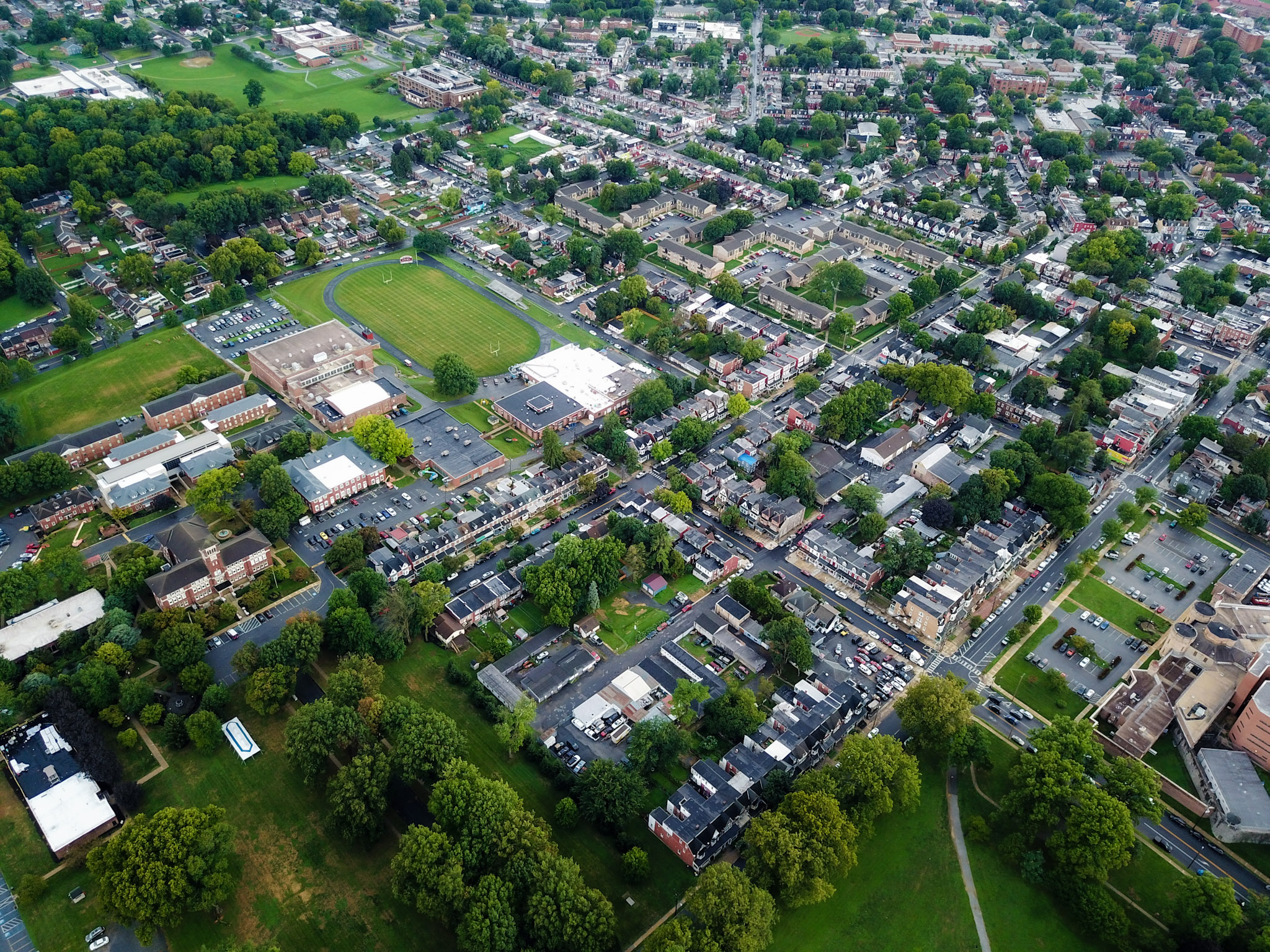

Explore the Community
Here you’ll find a view of the area with Ramboland in the middle. Buildings should be prosthetics for our surrounding living systems, and in a city thats a neighborhood. Click around amongst the key subsystems at this scale to learn about social and environmental issues and how Ramboland is connected to and addressing them.

Explore the Site
Here you’ll find a view of the Ramboland site itself. Click around amongst the key subsystems at this scale to learn about the specific features, strategies, and technologies employed throughout buildings and outdoor spaces, across the same set of key subsystems.

Explore the Features
Here you’ll find information about features that are at a scale too small or maybe too large for the other two scales (like details inside the buildings), as well as some other information that isn’t specific to a locational spot or area.
Please, join team Rambo!
Integrate this project into your learning and teaching, donate, explore, contact us, partner, and post about it!
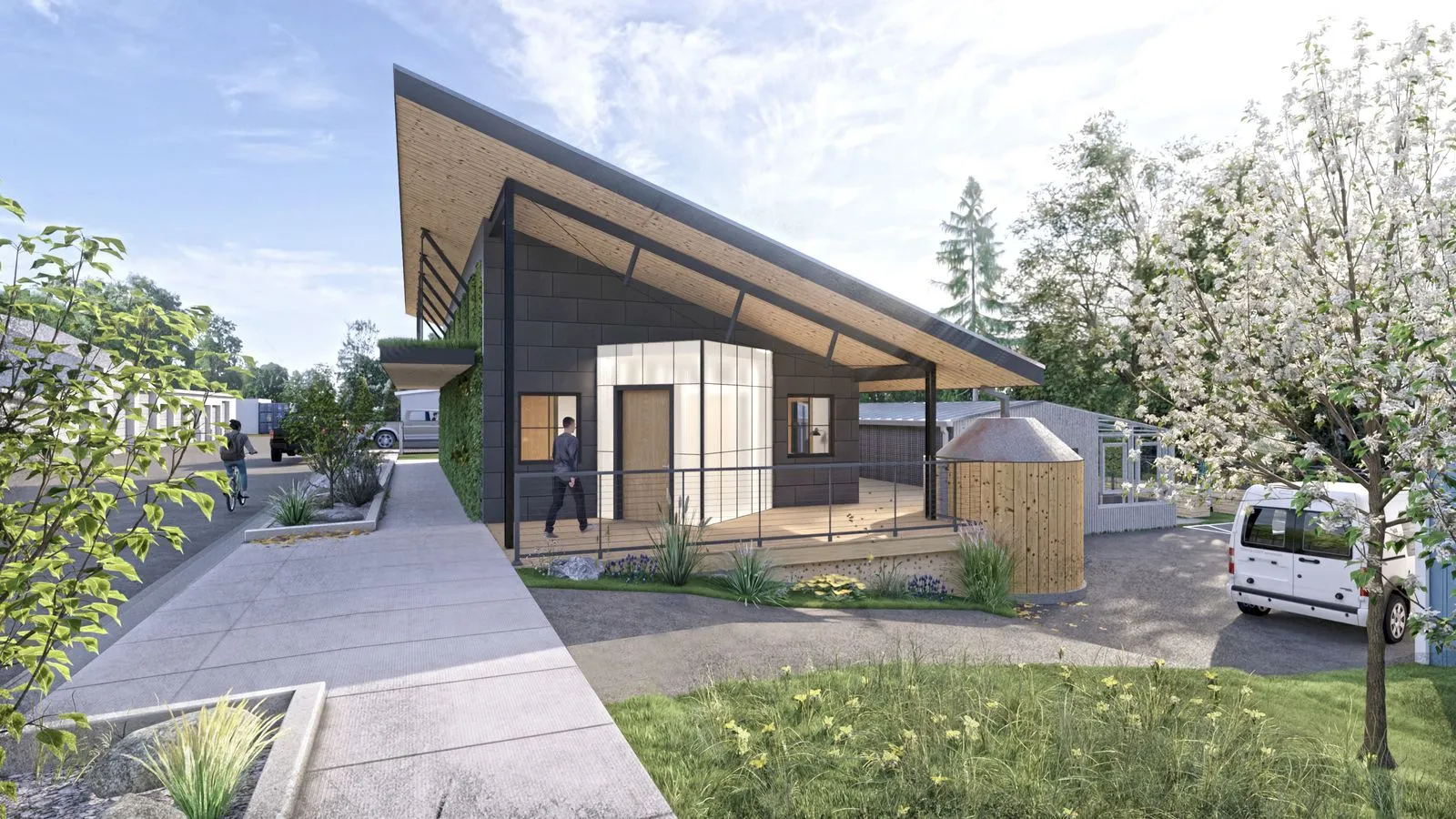
Welcome to Ramboland
Ramboland will be a living laboratory, demonstrating that our cities can heal our ecosystems while enabling all citizens to thrive, including those with special needs and other marginalized groups, far better and economically than we do today - launching a naturally spreading pattern of resilience, equity, health, and wealth generation.
This website is intended to be Ramboland's digital twin. Like the physical site, it is, and will continue to be in a state of becoming - as new approaches and technologies that enhance systemic fulfillment of the project’s intentions. The twins will be increasingly integrated with each other, both utilized for educational programs. Eventually onsite sensors, data streams, bioregional climate data, and human-collected information will be made visible here, creating imagery of the complex systems that make up healthy Places.
We are making greater possibilities for our built environments, and the living beings it is supposed to be serving, visible to the world as they evolve and are utilized over time. We believe that a whole-systems approach to urban regeneration can produce living and economic prosperity and support the health & wealth generation of our most neglected and abused communities and individuals. And that this will not be a sacrifice to the health and wealth of others, but will be a service to society as a whole, as this model (or better said: pattern) for design, economics, healthcare, inclusivity, environmentalism, and more spreads throughout the city, and eventually the nation and world.
.avif)
.avif)
Ramboland Press

USGBC+ MAgazine

Arch Daily

Susquehanna Style
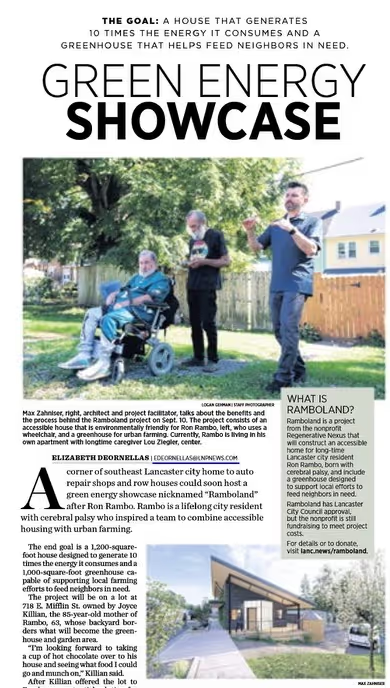
Ramboland to be a Lancaster city green energy, accessibility showcase

Ron Rambo brings a unique approach to green living

Ramboland Is Increasing Self-Sufficiency for People with Disabilities through Architecture Designed To Heal

Learning from one differently-abled man launched nationally acclaimed sustainability in Lancaster
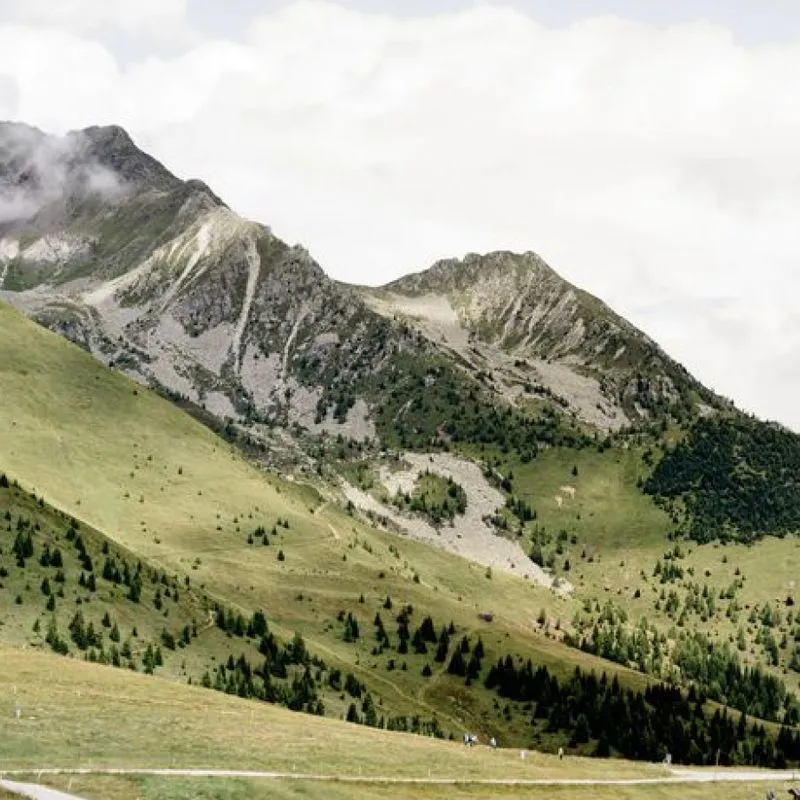
Intro Video

Partners

Larsen & Landis

Larsen & Landis is a structural engineering firm offering services to architects, to other professionals in development, design, and construction, and to building owners. We have solid experience in educational, commercial, industrial, residential, recreational, historic, and religious projects. Our engineering includes design, evaluation, and investigation, and we tailor our services to meet our clients’ goals and expectations.
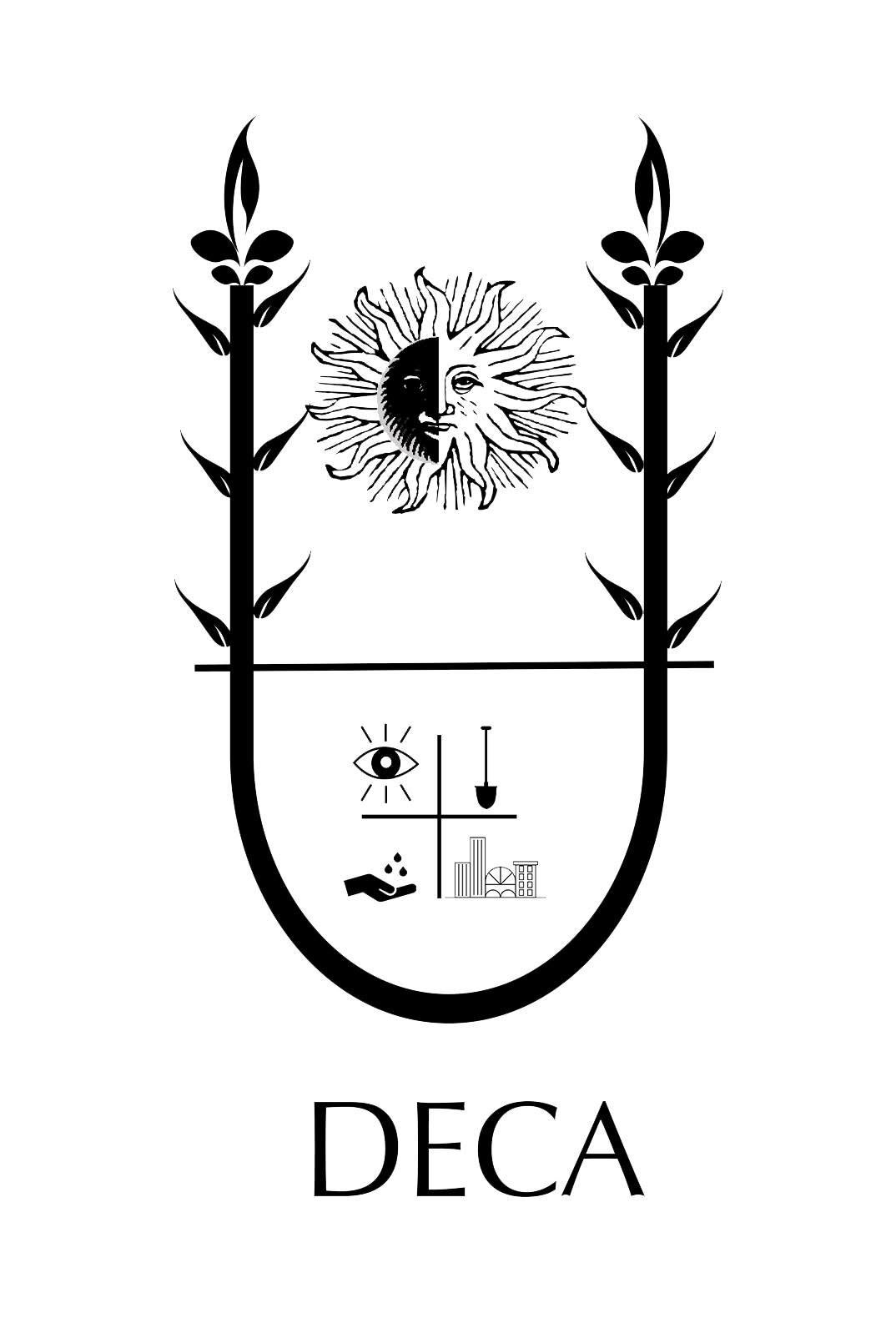
DECA City Farms

A 501c3 dedicated to creating Wellness & Abundance in our communities; fostering Agency and Inclusion
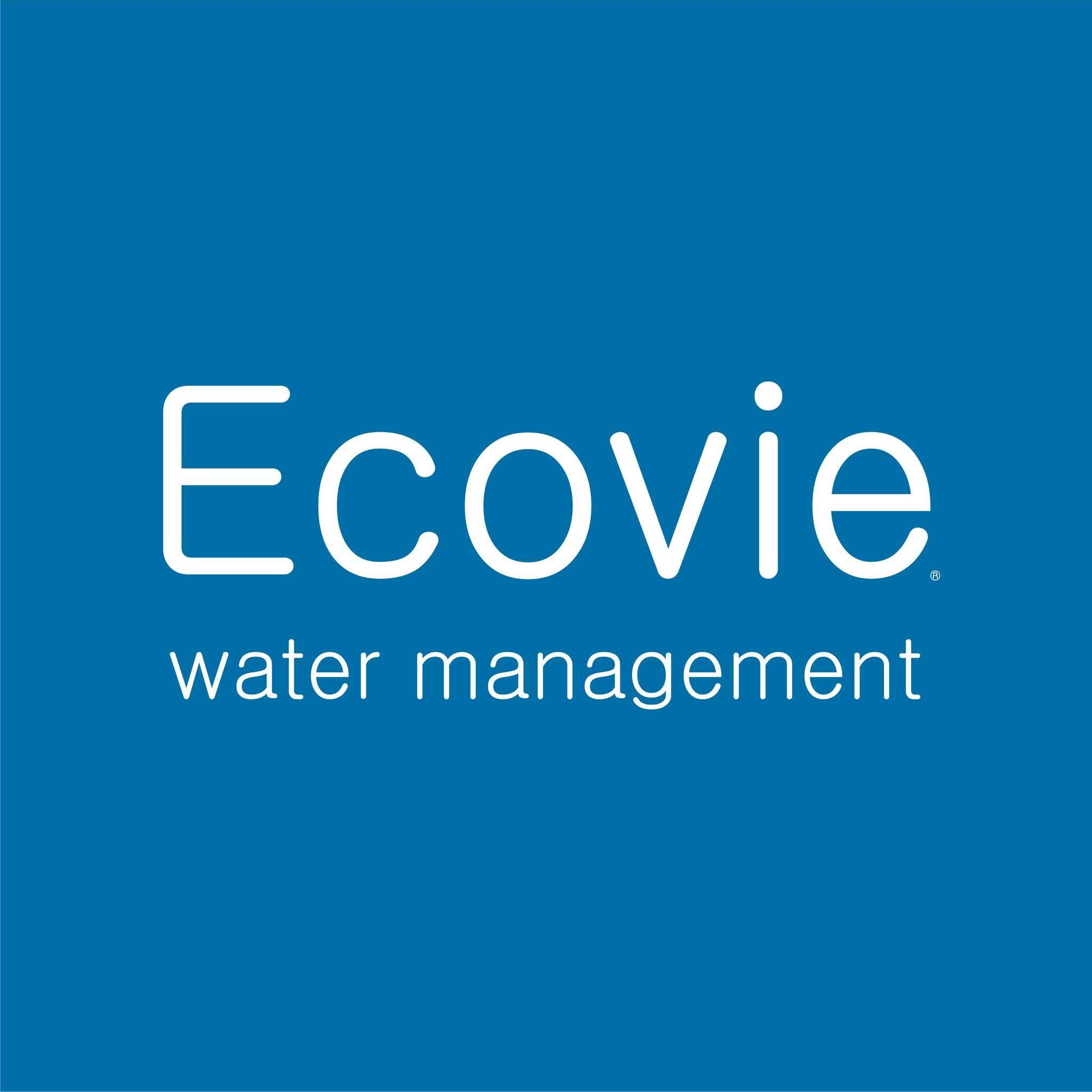
Ecovie

At Ecovie, we believe that decentralized water management is the solution to many water problems. Water scarcity, water discharge, storm water runoff, and water quality are real issues impacting communities across the country.
We design and deliver on-site water management solutions for commercial grey water recycling and rainwater collection, and storm water management.
We offer the only commercial greywater recycling system tested and certified by NSF International to the NSF 350 C standard. This is the recognized standard for water recycling by the International and Universal plumbing code authorities.

INTAG Aquaponics

INTAG is a sustainable agriculture company that exists to solve problems for the people who feed the world. Our biological solutions help reduce the environmental impacts of food and agriculture production while increasing yields for farmers. INTAG systems bring microbial life and other beneficial organisms together to create powerful biological and organic nutrient solutions for modern food and agriculture.
Integrated agriculture uses combinations of natural systems to create sustainable, resilient, hyper-efficient environments (ecosystems) for controlled growing. We minimize waste, reduce dependency on pesticides and synthetic chemicals in the growing process, and maximize the nutrient content, flavor, and productivity of naturally grown food, all while reducing or eliminating contaminants. We provide solutions that are sustainable, scalable, repeatable, transparent, and easy to use.
The most powerful inventions are inspired by nature, and we create elegant solutions for the world’s pressing needs. INTAG harnesses the simplicity of nature to create technology that helps people and communities sustain themselves and thrive.

7group

7group is a multi-disciplinary collective of leading built-environment professionals engaging projects that advance how technical innovation, community vitality, and ecological health entangle and co-evolve.

Sherwood Design Engineers

Sherwood Design Engineers is a civil engineering firm that applies innovation and elegant design to the creation and implementation of sustainable infrastructure. Our engineering process emerges from the integration of imagination, experience and collaboration to create beautiful infrastructure designed to enhance relationships between communities and the natural environment.

Introba

Introba is one of the world’s largest building engineering and consulting firms with more than 1,000 employees in offices across the United States, Canada, the United Kingdom, Serbia, and Australia. Committed to reshaping the world, our problem solvers combine cutting-edge digital solutions with emerging innovations and industry-leading sustainability strategies to transform the built environment.

Water Research Center

The KnowYourH2O™ website and Path to Clean Water Program evolved from an initial blog and rather small website that focused on the private well owner and general drinking water issues in the early 1990s. It then took the form of the Water Research Center website from the late 1990s through the 2010s. The Water Research Center became part of the Carbon County Groundwater Guardian Program in 2001, which itself evolved into the 501c3 Keystone Clean Water Team in 2013.
Under the Water Research website we conducted research, training, and consulting projects in diverse areas. This included acid mine drainage (AMD), mine drainage, lake and stream monitoring, wetland creation and monitoring, drinking filtration plant performance evaluations, testing new point of use water treatment devices and systems, hydrogeological evaluations, geological investigations, soils testing, soil morphological evaluations, water well drilling, rehabilitation and construction, and land reclamation. During this period, we updated and expanded the Private Well Owner Outreach Program and developed a private well owner mail order water supply drinking water testing and education program.
Through our effort, we developed a number of programs such as the Private Well Owner and Drinking Water Testing Mail Order Water Testing Kits, Local Private Well Owner Test Programs, Our Drinking Water Guide for Well Water and City Water, and we worked and expanded the use of our Surface Water Quality Calculator and Citizen Science Outreach Efforts to the world.
We have been involved with Citizen Monitoring and other Environmental Training Programs for groups within the United States, Aruba, India, Arab Countries, Europe, and even the former Soviet Union and currently our Surface Water Monitoring Calculator is used worldwide and used as a training tool.

Regenerative Nexus

Ramboland's Fiscal Agent and Program Manager.
Nexus emerged to enable system-change-makers to step into new levels of capability in creative new ways. We serve this purpose by tending to 1. under-supported projects, 2. the evolution of how education works in our society, and 3. the communities intertwined with both. We believe these all need one another in order to be regenerated.
Our programs are all intended to serve that purpose in different ways, each entering into the whole system made up of those 3 parts, and driving their co-evolution from a different entry point.
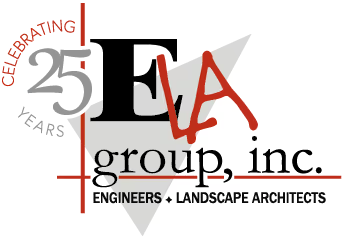
ELA

Since 1996, we have provided a wide range of Engineering and Landscape Architecture solutions to both the private and public sectors, from our corporate headquarters in Lititz, PA, our Central PA office in State College, PA, and our Western PA office in Butler, PA.
Through our collaborative project approach, we combine the design nature of our Landscape Architects and the scientific nature of our Engineers to yield project solutions that are innovatively conceived, creatively designed, and technically sound.
100% Employee Owned Company (ESOP)

UDS Foundation

It all began with Anna…and Mary Poppins. In 1965, we were inspired by the touching story of a young girl named Anna who was unable to attend a local theater showing of Mary Poppins with the other children because she was in a wheelchair. From this inspiration was born United Cerebral Palsy of Lancaster County. In 2000, we became United Disabilities Services (UDS) — a new name to reflect our greatly-expanded capabilities.
The UDS Foundation is a non-profit organization based in Lancaster, PA, committed to helping seniors, veterans, and people with disabilities lead more independent and fulfilling lives. In our 55-plus years, we’ve developed a wide variety of services and programs that improve quality of life and expand boundaries.
Today, over 350 caring, dedicated employees proudly serve people with disabilities and the aging in 40 counties across Pennsylvania. We provided services to more than 6,000 people last year alone, enabling them to live happier, more independent lives where they’re more in control of the decisions that affect them.
Our foundation is based on a strong vision, mission and core values.

DBC Partners

At DBC Partners, LLC we’re passionate about securing the necessary funding so building projects in targeted neighborhoods and key areas can be completed. To do this, we focus on Debt/Equity and Joint Venture Partnerships, working with BIPOC developers on projects in underserved neighborhoods that, when completed, will create a significant upside to the communities in which they’re located. All debt is secured via Greenbriar Capital, LLC (Philadelphia, PA) who specializes in debt for operating companies and real estate transactions by providing commercial mortgages and loans. Although many project sponsors (the borrowers) have 85-90% of the equity required to complete a project, they still lack the remaining 10-15% (ranging from $500K to $10MM). That’s where we at DBC come in, supplementing the remaining amount needed so projects can be fully funded.

Longview Structures

We believe that we're impacted by the built environment, and we aim to improve that relationship. Whether a project is big or small – a stairway or a stool, a dwelling or a door – great building starts with great design. Our goal is to enhance all spaces and interactions through purposeful structure and finely crafted detail.
Founders Mike Stoner and Jesse Pellman, LEED® AP began with a vision to create better housing based on the principals that for something to last, it must be well-loved, and that all we do should carry the awareness that our actions reverberate throughout our broader community.
We believe that sustainability goes beyond the individual spaces and things we build, restore, and renovate. This core ideology is why we’ve recently become a Certified B Corporation. Relationships are at the heart of our business, and the center of what we do. Whether it’s with a client, co-worker, architect, artisan, our neighbor or our environment, we’re always more interested in developing a relationship than a contract. So we’ve worked hard to cultivate a unique and comprehensive understanding of high performance, healthy, and sustainable housing.
We feel fortunate to have been joined by some great friends and makers along the way who help to further the mission of crafting sustainability.

Steven Winter Associates

Improving the Built Environment Since 1972
Steven Winter Associates, Inc. provides research, consulting and advisory services to improve commercial, residential and multifamily built environments for private and public sector clients. We specialize in energy, sustainability and accessibility consulting as well as certification, research & development and compliance services. Our engineers and architects have led the way since 1972 in the development of best practices to achieve high performance buildings. As a matter of course, we collaborate with our clients to produce the most cost-effective and innovative solutions.
Our History
When Steven Winter Associates, Inc. was launched in 1972, it was in part a result of Steven Winter, then a young architect, realizing how inefficient buildings were in their design and construction methods, and in their use of man-made and natural resources. Over the last 50 years, the core mission of the firm has stayed true to its origins. We work to improve the planet’s buildings and communities by optimizing their construction and operation, by improving the systems and products they are made of, and by enhancing the services they house.
Our success has come from providing superior services and innovative solutions, while exceeding our clients expectations, and inspiring them to do more. Much of our business is repeat business from clients who have realized the benefits of choosing the most proactive solutions, like going green long before it became a trend or an important standard of business practice. We have always believed that our strength comes from hiring the best people and providing them with an environment for growth and enjoyment. We are a strong and proactive voice in the industry for high performance buildings, and we enjoy a visible role in delivering this message through the media, associations and events.
Our clients – in government, industry, and the private sector – have awarded us the opportunity to work on projects as varied as the impact of the green, energy, and accessibility issues in residential, multifamily and commercial buildings. Our research in building science and technology has inspired new ways of solving construction challenges nationwide. And, our efforts in information dissemination and tech transfer have helped to inform stakeholders in both public and private sectors.
We are proud of our history and accomplishments over the years, but the real story of SWA is the future. There is still much to be done to improve the built environment.
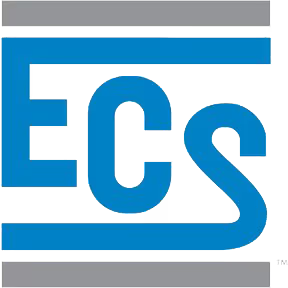
ECS (Engineering Consulting Services)

At ECS Group of Companies (ECS), our mission is simple: To be the engineer of choice in the markets we serve. We fulfill our mission through our values to collaborate, focus and lead, and we approach business with a mindset of abundance, entrepreneurship and having fun.
Our team is deeply invested in the success of our projects – sometimes our projects become personal. It’s not uncommon for our staff to directly benefit from the final product of the projects they work on, whether it be taking family to visit the new wing of one of the world’s major art museums or simply commuting on the roads they drive every day.

Ground Plan Studio

Founded in 2016, Ground Plan Studio is a recognized leader in the evolving fields of carbon farming and regenerative business. We have decades of global experience in ecological planning and design, and have worked with the best minds on the planet to solve real world business problems with strategies derived from the enduring and robust models seen in nature.

Land Grant Surveyors

Established in 2008, Land Grant Surveyors, LLC (LGS) was founded through a partnership between Steven C. Black and ELA Group, Inc. ELA Group, Inc. is a comprehensive Landscape Architecture and Engineering firm with over 26 years of experience and offices in Lititz and State College, Pennsylvania. LGS, in affiliation with ELA, enhances client service by leveraging their expertise in Land Development, Engineering, Transportation, and GIS. This collaboration also benefits ELA by ensuring internal quality control and seamless continuity in the design process for their clients.

Team
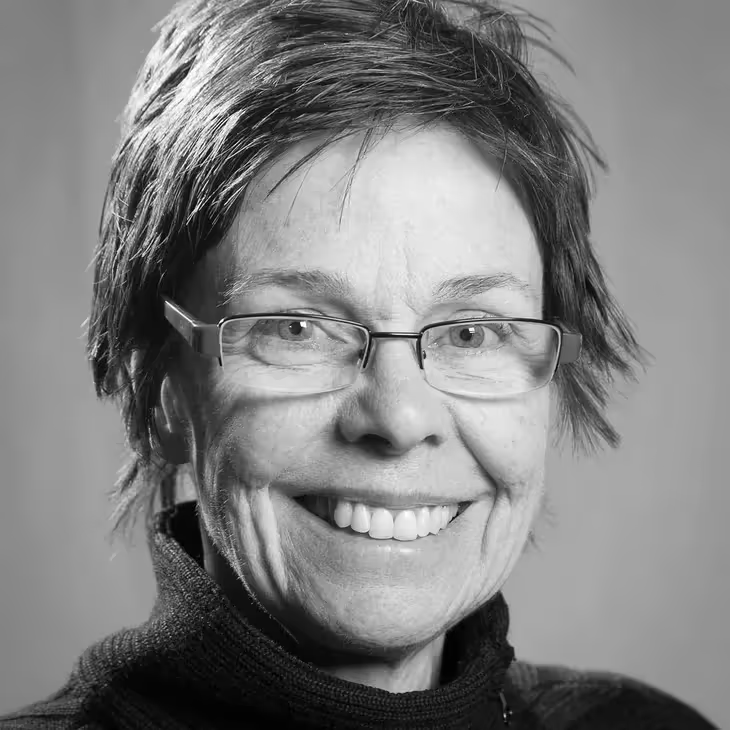
Carol Hickey

Carol Hickey stepped forward first to serve as architect of record, and lead the architectural efforts during the project's schematic design phases. She's an ardent supporter and fan of Ron and the project, and has integrated it into her architecture education offereings and F&M University.

Chad Adams

A globally experienced leader with over 25 years of professional background in whole system thinking, ecological planning, and sustainable design, Chad is leading the farm business modeling for the projects.
“I believe that a resilient systems approach in our built environment – informed by the pattern and process of nature – will be an economically robust business model of the future. We must understand land and people as a positive relationship that enables them both to thrive in the future.”

Cheryl Love

Cheryl Love, RLA, does not seek out the limelight, but it found her as she and other “Women of Influence” were honored by the Central Penn Business Journal. The awards are based on experience, integrity and leadership. Cheryl is the Director of Landscape Architecture, specializing in Land Planning. For many years, she has been the lone female partner at ELA Group, Inc, which she has since been integral in developing ELA into an Employee Owned Company (ESOP). Cheryl is a gifted Landscape Architect with passion and energy for making the community great, through the project she leads and civic causes she supports. Cheryl focuses on sustainable designs, responsible use of water resources, and energy efficient designs. She sees Ramboland as an extension of all these things.

Elizabeth Baldwin

Elizabeth W. Baldwin, P.E. is an experienced Senior Professional Engineer (P.E.) and Project Manager with a demonstrated history of working in the civil engineering industry. Elizabeth is a professional skilled in Stormwater Management Design and Implementation, Land Development, DEP Permitting, and Erosion Control. Elizabeth feels this project is an important contribution to the industry and regulations due to the ways in which it is future facing. She feels this project will be an example for development to come to show how combining site stormwater and water systems can be sustainable and beneficial for all.

Erin Raup

Erin's goal is to leave every place better than the way it was found, in both professional and personal life. While in college, Erin designed buildings that met the net zero energy standard and strived to achieve Living Building Challenge certification. Erin has a very strong passion for high performance buildings and believes architectural professionals play an important role in demanding and producing a more sustainable built environment. In this vein Erin worked for Habitat for Humanity in North Carolina, serving as a laborer and project manager who helped build 50 houses in just one year. Erin has been aspiring to live a zero waste and vegan lifestyle for over six years in an effort to reduce her ecological footprint as much as possible. Erin is leading the effort to produce the final permit documents for the Ramboland this year.

Frank Sherman (RIP)

Frank Sherman was a leader in the national green building movement, an architect, sustainability director, and food systems entrepreneur. He advocated for the inclusion of food systems on Ramboland both to make the scope of the project more whole, but also to create a means of better utilizing the clean water and energy excesses it can create for the good of both the community and the operational financial self-sufficiency of the project. He is missed.

Hawa Lassanah

UPDATE: Throughout my career, I have positioned myself as a community leader first, team player second, entrepreneur third. My passion is connecting with people and creating networks to uplift the underserved. Ive directed this soul passion towards my intellectual passions which include anatomy, nutrition, mental health and spirituality. The intersection of these interests have led me to acquire wide variety of skillsets having participated in a variety of fields: from customer service, food service, child care and educational curriculum building to plumbing, HVAC and light electrical work, project management, event planning, administration, staff/volunteer coordination and relationship building with like minded organizations. If my warm nature and strong work ethic aligns well with the needs outlined for your Company, then I am eager to contribute my talents.

Jesse Pellman

A founding member of Team Rambo, Jesse has been the voice of construction innovation from the start. "Can't" isn't in his vocabulary. As founder of Longivew Structures, a leader in deep green and high end residential building in the Lancaster region, Jesse and Co will see this project through to its full materialization.

Jim Remlin

Jim Remlin is a Associate Principal at Sherwood and manages the Atlanta office. He specializes in the oversight and development of projects with goals focused on water management, improved site circulation, green infrastructure integration and utility routing. He has successfully supported projects from master-planning through construction documentation, bidding/negotiation and construction administration. In order to evaluate and achieve the clients’ goals and vision, Jim manages direct coordination with project architects, landscape architects and planners in addition to local and federal permitting agencies. Jim has worked on a wide array of project types in assorted land typologies, including institutional, open space, residential, and mixed-use developments located throughout the United States and internationally. These projects involve client and design team guidance and support to properly evaluate low impact design initiatives and strategies, identify ecological restoration opportunities and reach toward LEED and sustainable goals for the design of the site’s land and water footprint.

John Boecker

John is a green architecture movement leader and pioneer, focused solely on regenerative thinking and approaches. Ramboland represents one of the only projects with enough merit to keep John from fully retiring. John is supporting the project by seeing it through the final design and permitting phases of the house and initial.

John Gould

A lifelong leader in education systems throughout Pennsylvania, and now leading educators to reinvent the education system itself via his role at Drexel University's Doctorate of Education program, John sees Ramboalnd as the important first example of the sort of community educational infrastructure we need in every neighborhood. He is thus working to integrate the project with curriculum and learning institutions locally and regionally.

John Harper

Bringing both a passion for nourishing innovative, sustainable, and regenerative projects, and the capability to connect capital to worthy projects, John has been supporting the Ramboland project for several years, helping to strategize around the underlying financial dynamics amongst the housing, food, and energy systems.

Kirby Smith

Kirby Smith and his wife Suria have led an innovative and practice-leading company, Sunkirb Ideas, for many years. Kirby is a technologist and innovator in connecting built-environment management systems with interfaces people with any level of ability can use to manage their spaces and systems. Kirby has been supporting Ron and Ramboland to help Ron in his current living situation, and maximize the independence yielded by the Ramboland design.

Kris Haycook

Kris has had a decorated career in industry leading companies, including Integral Group (now called Introba), Glumac, Tesla, and Ecovie. He is a world-leading expert on deep-green water system engineering, including expertise in rainwater collection, treatment, reuse, quality, and efficiency. Kris is a long-time member of Team Rambo.

Luke Morton

Luke Morton is HYA’s sustainability manager and graduated from Stanford University with a B.Sc. in Earth Systems and an M.S. in Civil and Environmental Engineering. During his studies, he worked for a number of building energy organizations. At the U.S. Green Building Council in Washington DC, he supported the creation of a carbon-based standard that was incorporated into the LEED criteria. At the Rocky Mountain Institute in Boulder, CO, he worked on evaluating the effectiveness of Automated Demand Response Systems (“smart” thermostats). At Southface Energy Institute, in Atlanta, GA, Luke inspected over 500 new single-family houses as a HERS Rater for ENERGY STAR and EarthCraft House certifications. With Viron Energy Services in Oakland, CA, Luke led the energy audit of the entire Community College District of San Mateo, including College of San Mateo, Cañada College, and Skyline College. In his free time, Luke enjoys baking desserts in his solar oven for FGY’s Tuesday lunches, playing ukulele in a local bluegrass band and presenting to architects and contractors statewide. He is now a father of two!
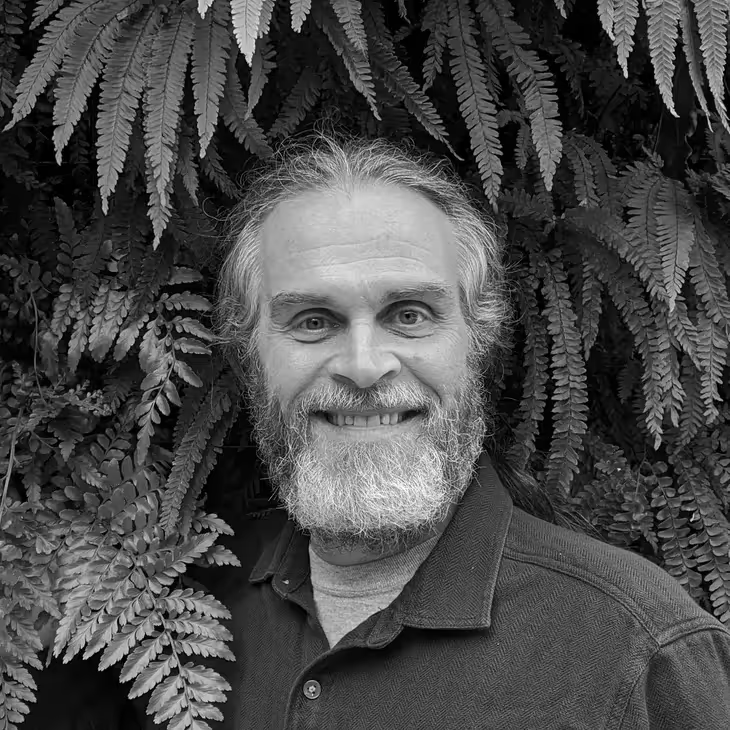
Marcus Sheffer

Marcus has been an international leader in the green building movement and energy optimization for three decades. His passion for how things things can support and integrate with social and food systems, and via a regenerative approach, has attracted him to contributed in several ways to Ramboland. He is leading the team's efforts around food system partnerships. He's also passionate about working in his local community, and lives near the Ramboland site.

Max Zahniser

Once upon a time, Ron Rambo had the idea to build a green demonstration project on his mother's land, and after talking about that around town to a couple of people, he was introduced to Max, a green building and regenerative practice leader who grew up near Ron's home. The two of them have been conspiring to make this project happen ever since.

Michael Paul

Michael J. Paul, FACI, has more than 40 years of construction and engineering experience and is a recognized leader in the concrete industry. He currently serves as Principal Structural Engineer for Larsen & Landis, Inc., based in Philadelphia, PA. In this role, he oversees the engineering, documentation, and management of structural engineering for commercial, institutional, industrial, recreational, and residential projects. Paul’s experience includes troubleshooting, repair, restoration, and rehabilitation of existing concrete structures, in addition to new structure design.

Ron Rambo

Namesake and initiator of the Ramboland project, Ron lives with cerebral palsy, and all the ways our society succeeds and fails to support an independent and livable way of life. He is a social butterfly, and passionate about the environment, as well as making the world a better place, especially for those facing similar challenges in a society that does yet know how to support them.

Sam Horochowski

Sam believes in architecture as profoundly unique form of human expression, with the ability to impact both humanity and the planet for better, or worse. He feels strongly that it should do the first.
Sam lives a slow life in Lynchburg, VA where he and his wife operate a small design studio focusing on single family residential architecture and interiors. He enjoys spending time in nature, weight training, obsessing over building science, technical construction details, and a cold beer on the porch. He has lead the final visualization efforts for RAMBOLAND.

Spenser Yost

Highly ambitious team member looking to better everyone around them as well as himself. Quick learner and very adaptable. Open to new opportunities and adventures. Job history is extremely varied with success occurring in each position held. Feel free to pick his brain.

Team Rambo

Over the years an incredible cast of pro-bono contributors have provided titanic support from every perspective; including Brian Oram, Brian Falcon, Tyler Stull, Heather Medlin, Jason Loiselle, Justin Bond, Tracy Buchholz, Scott Pusey, Tyler Thumma, Stull Investment / FLOW, Josie Plaut, CityCoHo, and more.

Theresa Jordan

Theresa Jordan is a graduate of Drexel University’s Urban Strategy masters program, with a concentration in community-based development and sustainable design. Her academic research focused on the regenerative potential of urban public space development. She has a background in business administration and human factors psychology.

Thomas Devenny

Thomas W. Devenney, P.E. is the Director of the Water/Wastewater Engineering Department at ELA Group, Inc. His responsibilities include overseeing the water and wastewater engineering design and project management. With a Bachelor of Science degree in Environmental Systems Engineering from the Pennsylvania State University, Thomas has an educational background in air pollution, ground pollution, and water pollution control and values the opportunity to be involved with a project that seeks opportunities to mitigate its carbon footprint and institute water conservation practices. Thomas is also passionately committed to the project because its attitude toward nutrients and management of resources is the direction we need to go if we're going to only solve, but dissolve our "waste" water challenges.
Connect
Help us do more.
Join Team Rambo!
Integrate this project into your learning and teaching, donate, explore, contact us, partner, and post about it!
Support the future of universal design, deep green building, urban regeneration, and equitable healthy community. Your donation helps this project continue to operate, grow, and be available for everyone. Every contribution - big or small - makes a difference.
Sign up here to recieve periodic updates about our progess.
Your submission has been received!
On the east side of downtown Lancaster, PA
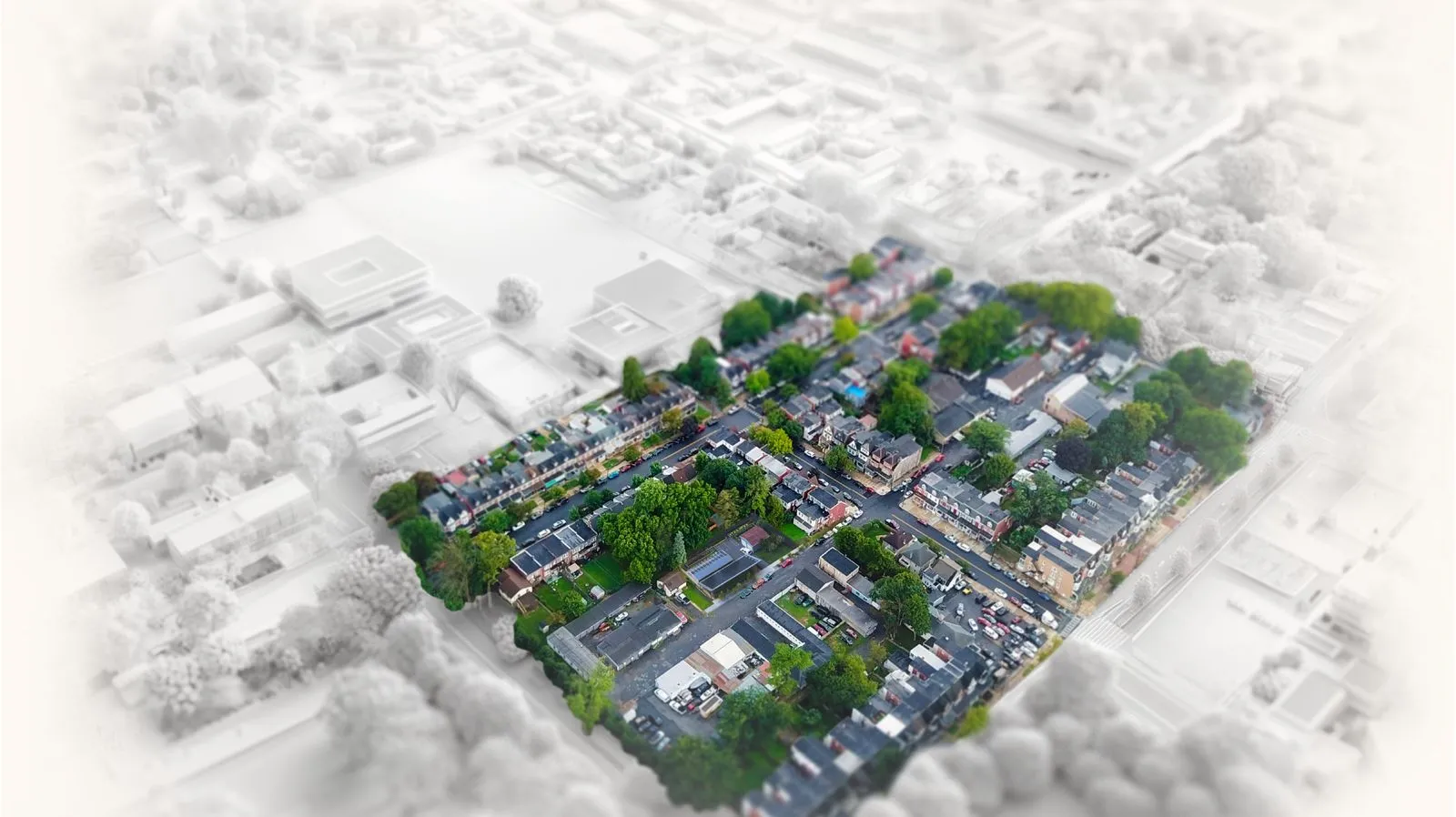
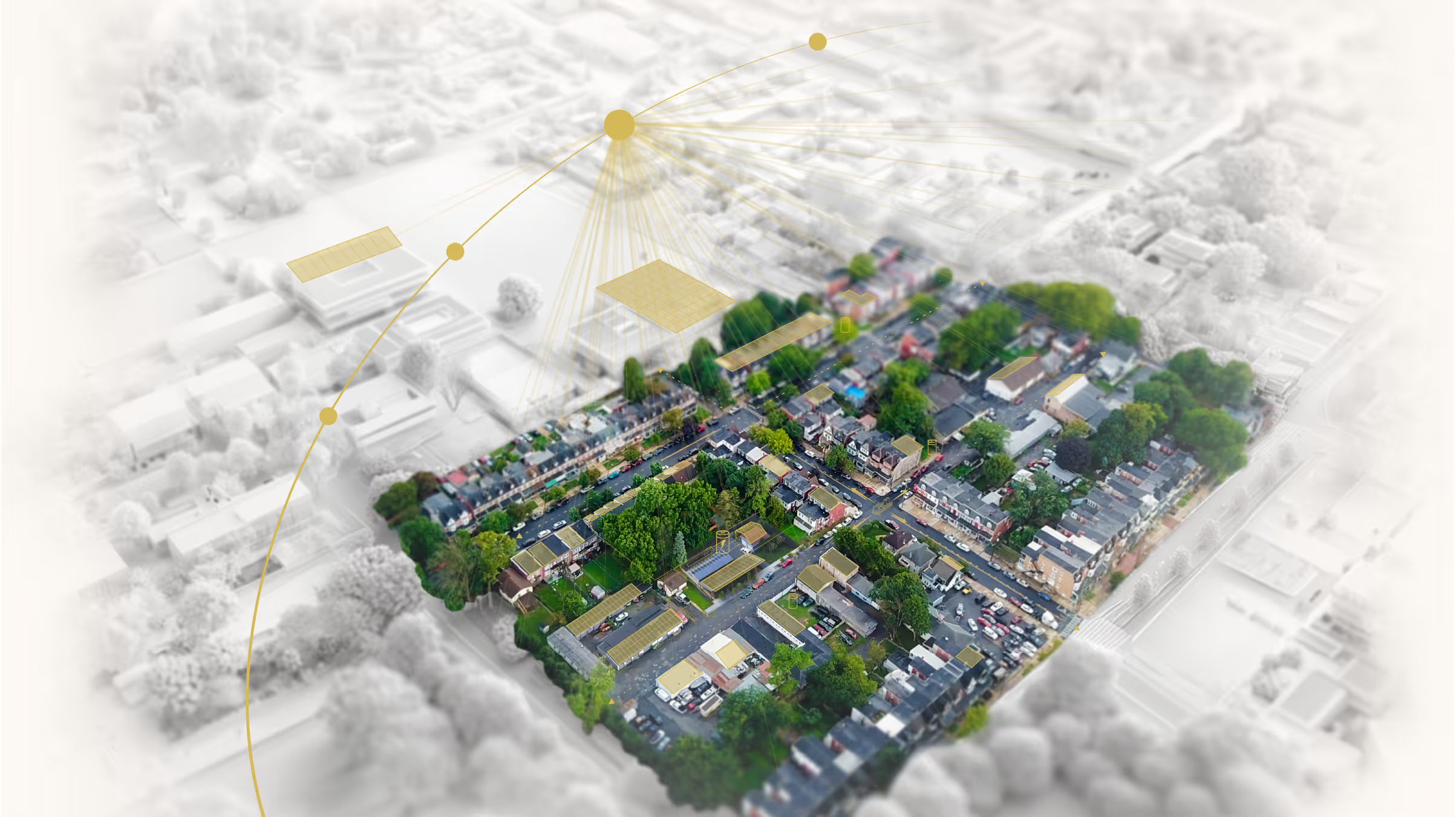
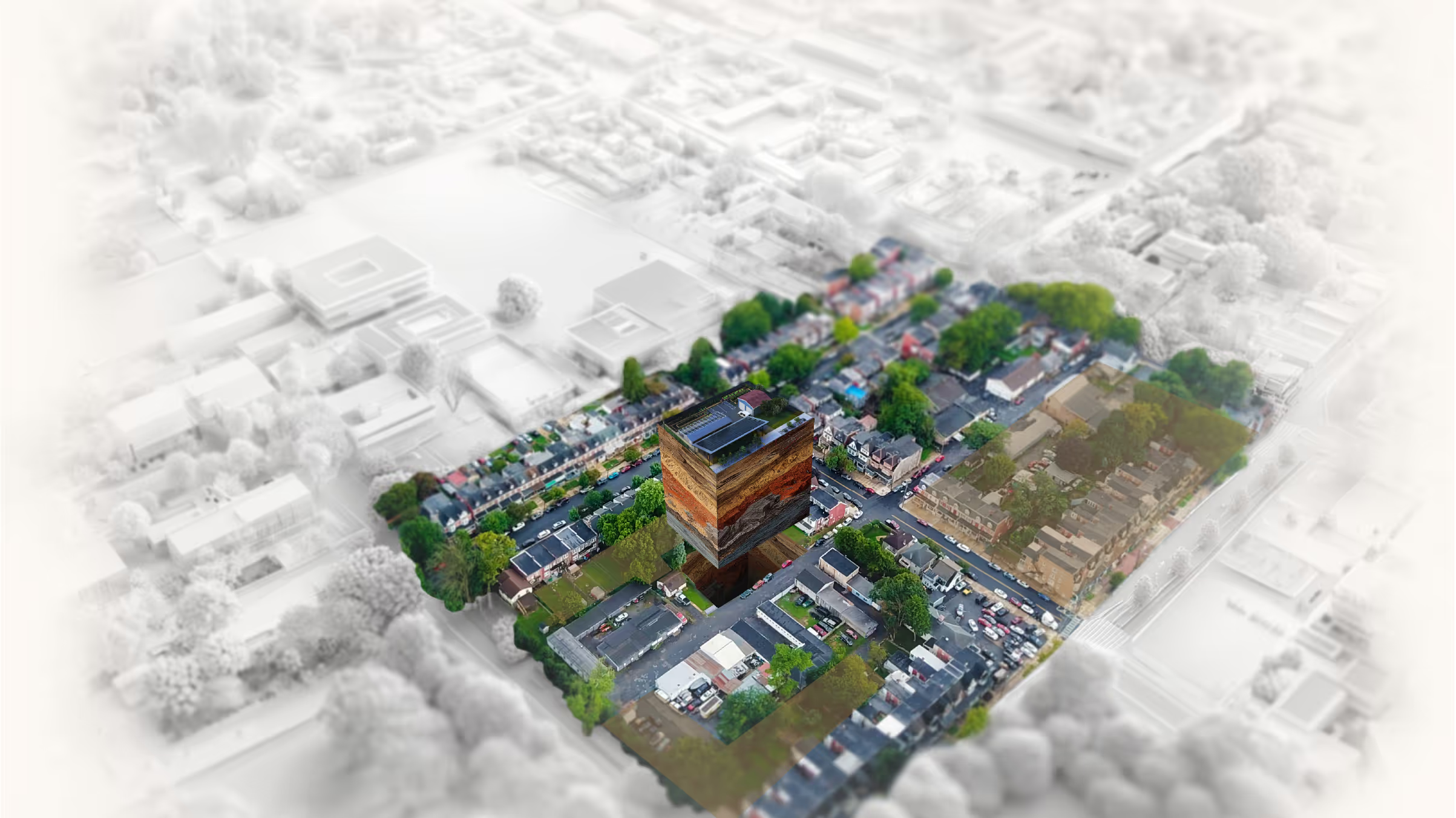


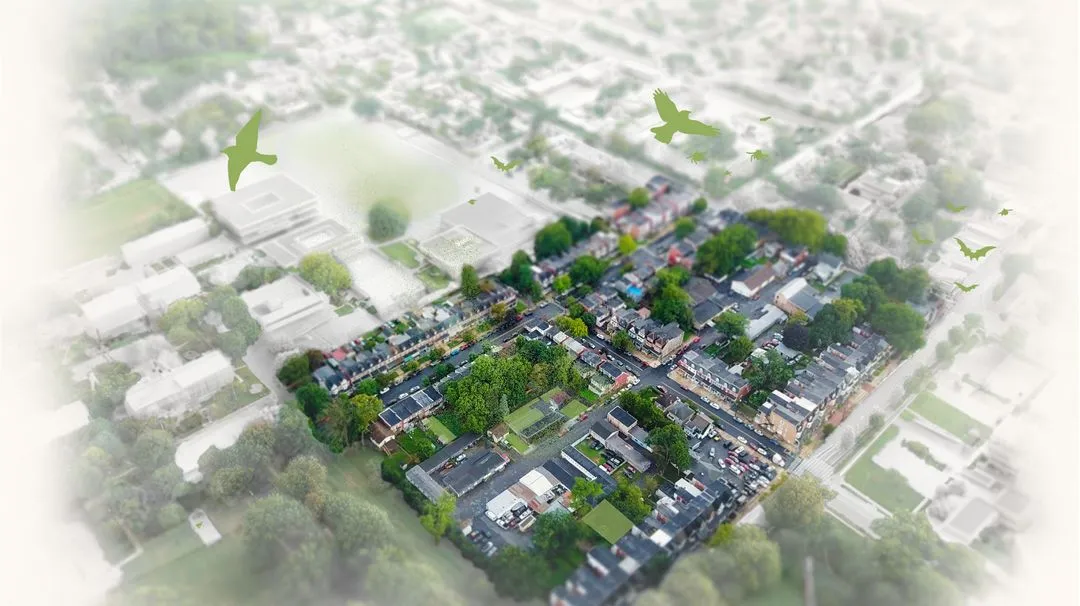
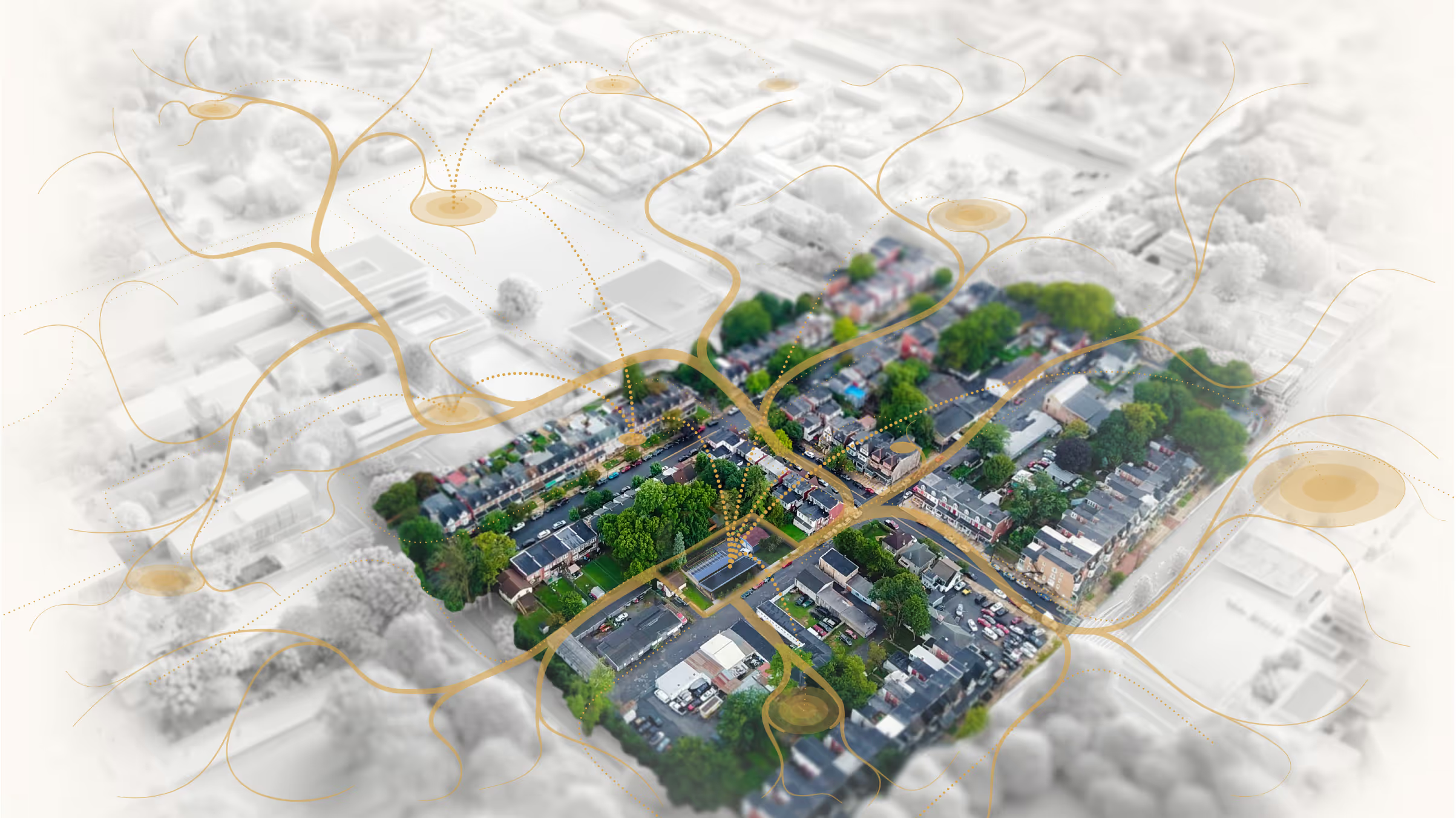
























Clean and healthy energy created through solar PV, and some residential scale wind generation, with the ability to store energy in the EV battery, is made available for home electricity, water pumping, food production, and with a significant amount being stored to weather times when the larger grid is down. This will also carry with it the decarbonization of households, many of which cannot afford to front the costs of new electric appliances to replace natural gas and other fuels, creating a resilient energy system as well as solving issues such as indoor gas leaks that now contain dioxins from fracking (Gas Safety USA), overall CO2 balance, explosion risks, and more.











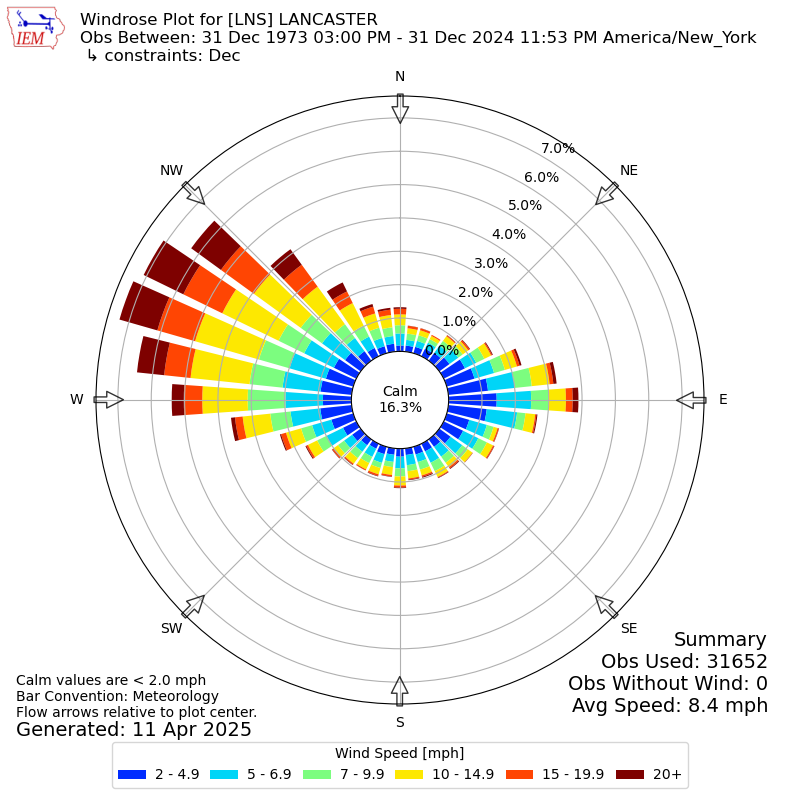
Prevailing wind information for the cooler months is useful to know for a couple of reasons:
- When designing to maximize energy efficiency, reducing heating system usage is a primary concern, at least in this “heating load dominant” part of the world and building type. Blocking cold wind from increasing heat loss when those molecules would hit the coldest side (northern) of your building is often one of the keys to minimizing heating energy use.
- When considering wind power generation systems, knowing directionality and speed can make the difference between viability of such systems, and their productivity.











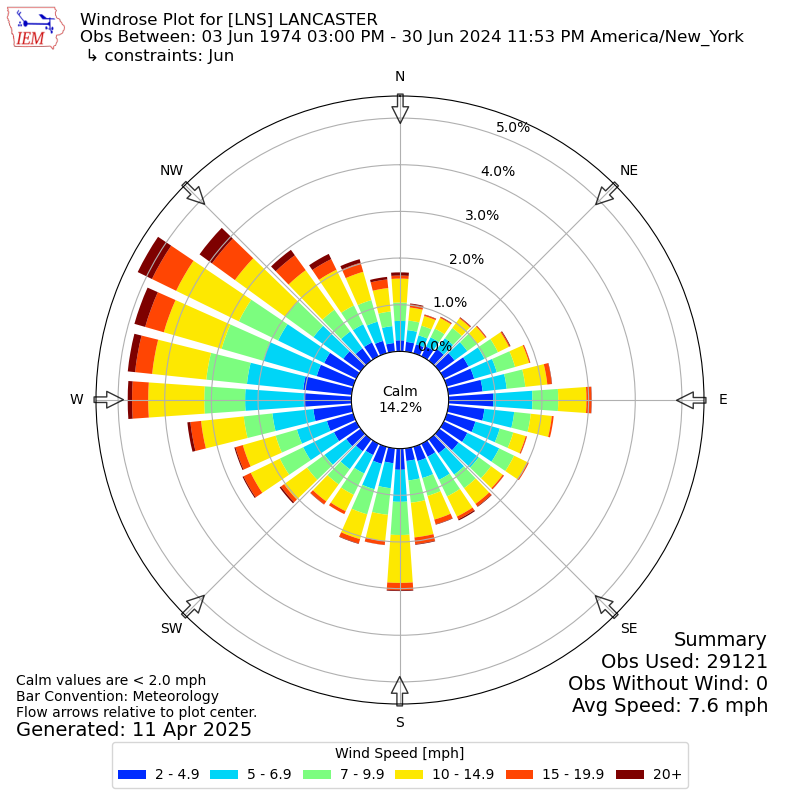
Prevailing wind information for the warmer months is useful to know for a couple of reasons:
- When designing to maximize energy efficiency it often it makes sense to explore passive-airflow strategies (architectural air pockets, insulation, windows on the south side, massing and orientation, triple pane windows, surroundings, vestibule, breezeway), to pass air through the house without electric fans, and to reduce the number of days per year that the building must be closed up and using energy-demanding cooling systems.
- When considering wind power generation systems, knowing directionality and speed can make the difference between viability of such systems, and their productivity.











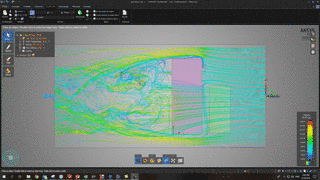
“Prevailing Winds” is a term for the fairly consistent direction and speed of airflow in a large geographic region. While speed and direction vary a bit moment to moment and day to day, etc., over time within a particular season of the year, it can be counted on that air flow above the ground, or above and between objects on the ground, like buildings, landmasses, and plants, will often match the prevailing winds. Over time climate change may also change this. Currently, in this part of the world, winds tend to come from the southwest during the warmer half of the year. Also known as southwesterly. And winds tend to come from the northwest during the colder half of the year. Also known as northwesterly. Note: One might assume that terms like “southwesterly” or "northwesterly" would refer to the direction wind is GOING, but when referring to wind direction, the terminology refers to its source.












The neighboring businesses and warehouses (currently mostly mechanic shops) could potentially become part of Ramboland through “just transition” support. Just as YIMBY will extend and enhance Ramboland systems to residential neighbors and partners, on this block and others over time, neighboring small businesses may decide to participate in the same ways, as well as adding PV installation and maintenance services, EV repair services, rainwater collection, treatment, and reuse system expertise, indoor and outdoor growing, all through training programs with local and regional educational systems that do and will increasingly offer these topics. This will enable greater economic resilience for these business owners, and greater system efficiency and security with less downtime for the neighborhood wide systems themselves, as well as ensuring the systems can produce surpluses, fully displacing such costs for the residents and business owners, and yield value that can be monetized. This may be important for these businesses as internal combustion engine repair will continue to taper off with the increased market-share of electric vehicles. That said, this would be a tapering and transition process, as especially low-income neighborhoods will need ICE car repair for several more decades… then again, if the Ramboland pattern spreads, the neighborhoods will no longer be “low-income.” Read more about how neighborhood economics work and COULD work.











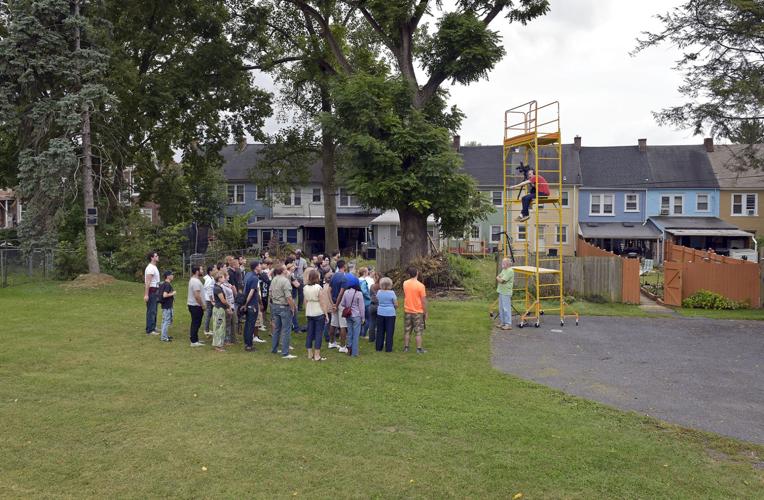
YIMBY was born during a community engagement session, when a neighbor said “can you do this stuff in our backyard too?”












Natural and biophilic sounds from trees moving in the wind, birds singing, insect noises, animals, moving water, and more can be beneficial to human's mental health, as it calms our nervous system and gives us a sense of safety. For those that don't suffer from biophobia, it can be soothing, and positively impact our psyche and thus bodies in meaningful ways. In order to be surrounded by natural and biophilic sounds, we have provide and take care of natural habitat. Ramboland does this in several different ways: Vegetated Surfaces, Bird Houses, Ecosystem Prosthetics, Bat Boxes, Pollinator Hotel











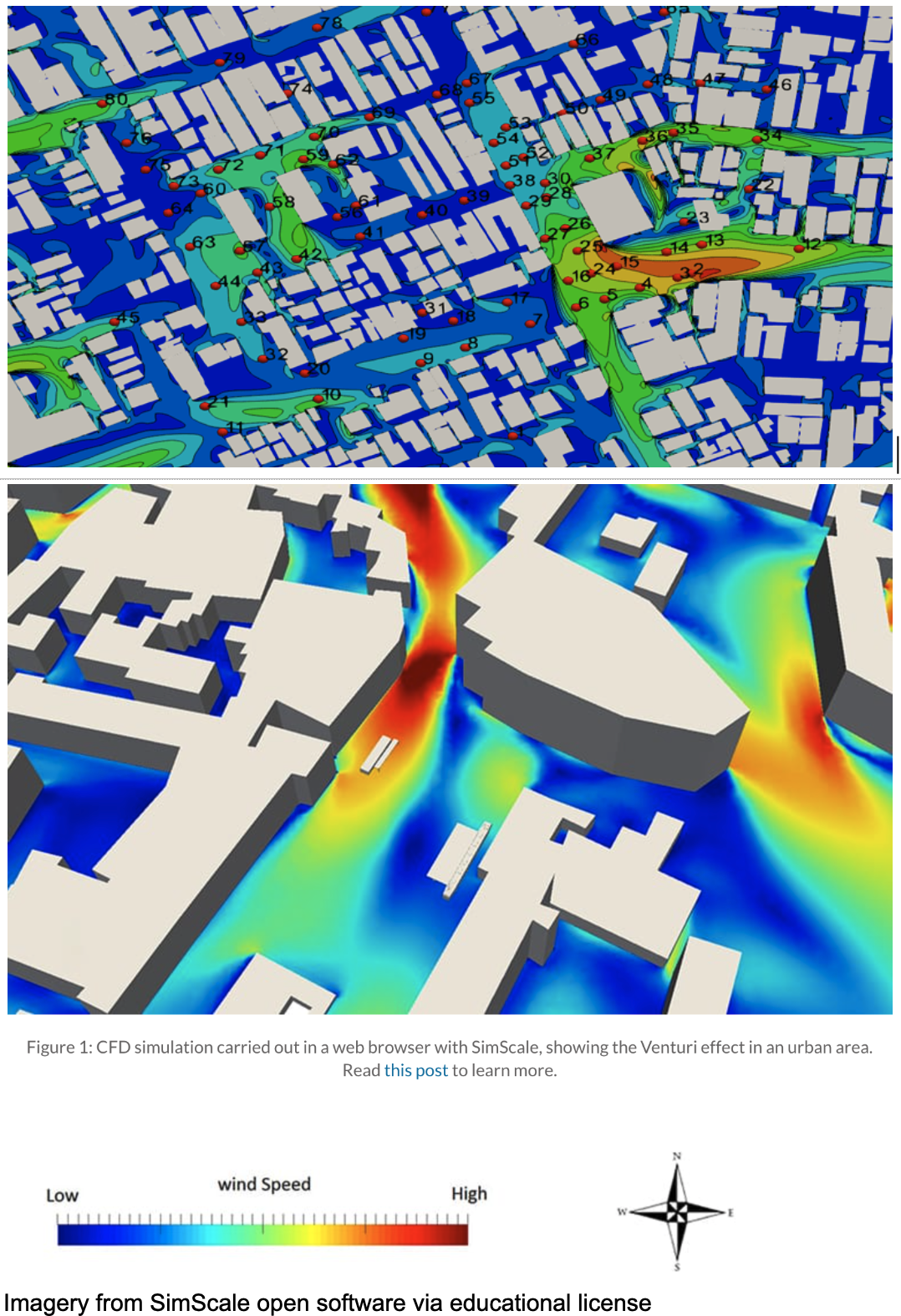
Wind speeds tend to be higher in open spaces compared to spaces with buildings or trees, except cases where the prevailing winds align with urban canyons or corridors.












In recent years, in part because of the limiting of human activity as a result of Covid 19 lockdowns, we have realized that noise pollution is one of humanity's biggest assaults on other forms of life. Disruptive noises such as mechanical equipment, vehicles (especially diesel trucks), construction, airplanes, and other machinery flood our environments with sound that drowns out important detection and communication capabilities of many species.











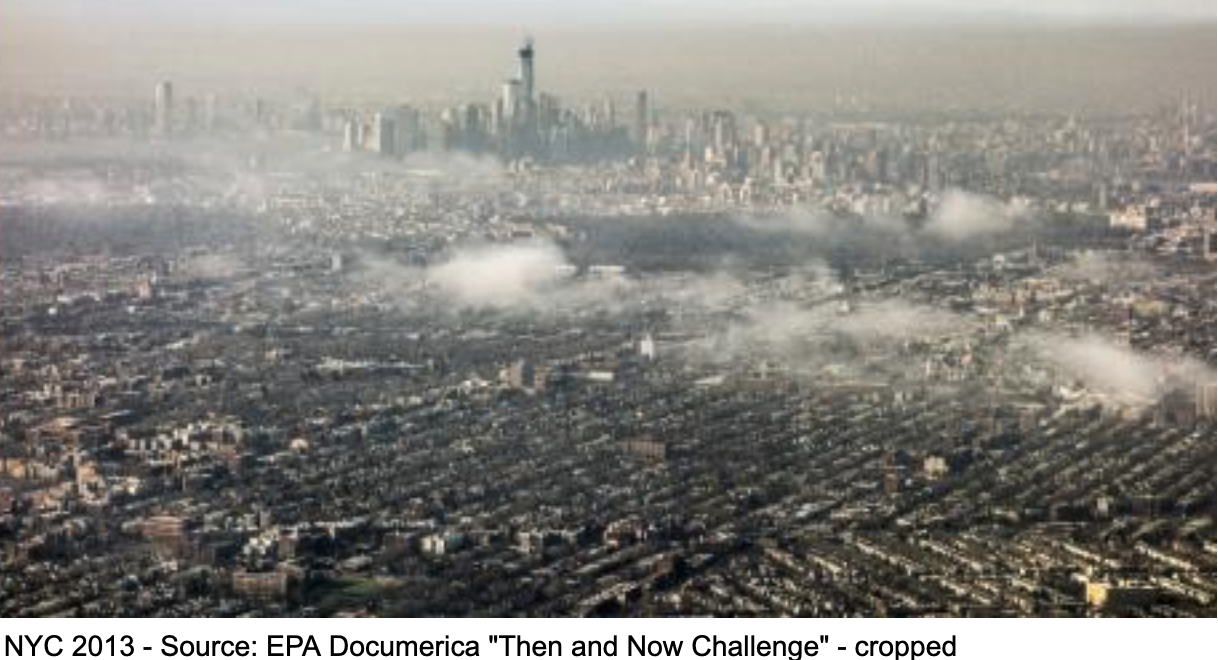
Air quality in urban environments, indoor as well as outdoor, can be a threat to human health. Americans spend 90% of their lives indoors, and on average, indoor spaces have between 10x and 100x as many contaminants in the breathing compared to most outdoor environments, even major cities, with some exceptions (source: Greenguard).
Building materials are among the worst culprits, as are building systems that fail to clean the air well, and prevent infiltration of contaminants in various ways. But in many cases natural gas utilizing appliances, which pretty much all leak at least a minor amount, are introducing oxygen displacing methane, along with impurities, and now in some cases dioxins suspected to originate from corporate IP protected fracking fluids (Gas Safety USA).
Outside, nearby industrial and transportation air are usually the primary culprits, but often in close competition with fossil fuel utilizing power plants.












Trees and plants use energy from sunlight, water and nutrients from the roots, and carbon dioxide from the air to create sugar for fuel and make their wood bodies – processes that emit oxygen as a byproduct. In addition to improving our air quality, trees can significantly cool large areas in the summer, by providing shade and evapotranspiration. Trees and plants are also habitats for many Life sustaining and supporting species, such as pollinators, birds, other insects, fungi, other microbes, and many mammals and rodents.
Being surrounded by nature is also scientifically proven to contribute to improved mental health and cognitive function for humans. Broadly
speaking this is known as biophilia.
Read about what typical buildings do here.











.webp)
Buildings are one of the most significant contributors to greenhouse gas emissions, accounting for about 40% of global CO2 emissions (Source: US DOE EIA). When you attribute industrial and transportation impacts from building products and materials, the total building CO2 emissions number is much higher. In other words, both operational energy uses such as heating, cooling, lighting, water pumping and heating, as well as building materials and construction are usually the biggest contributors to non-local emissions (from power and water plants), and among the most significant contributors to some emissions locally.
Most buildings also exacerbate the urban heat island effect, raising temperatures in densely built environments by storing heat and displacing temperature regulating vegetation.
Buildings can also be a major threat to wildlife, such as birds, second only to cats in terms of bird fatalities, etc. And of course many other species are displaced or otherwise disrupted and killed by our built-environment practices. We submit that none of this is necessary, and much of it can be walked back with innovative practices such as building integrated habitats, rewilding, bird friendly building techniques, and more.
Read about what trees and other plants do here.












As the YIMBY model spreads, neighboring roofs can be renovated addressing issues such as leaks, wear and tear, and structural damage, as well as improving insulation. Instead of unwanted water going down into the house it will be redirected to community cisterns, or to rain barrels that can be picked up by the EV. The additional power generation from the newly installed solar PV panels on the roof will provide for any electric pumping necessary, but in most cases gravity will do all the work. In concert these systems will support food production across a food insecure neighborhood, as well as a highly resilient “nanogrid,” extending the benefits of clean and resilient energy to the neighborhood over time, as neighbors opt-in.












Water cisterns are distributed throughout the neighborhood to collect rainwater from the roofs. In addition to aid stormwater management, the rainwater can then be used to water the urban farms. The EV will transport full cisterns to the farm or where water is needed, and return the empty cisterns back to collect rainwater.











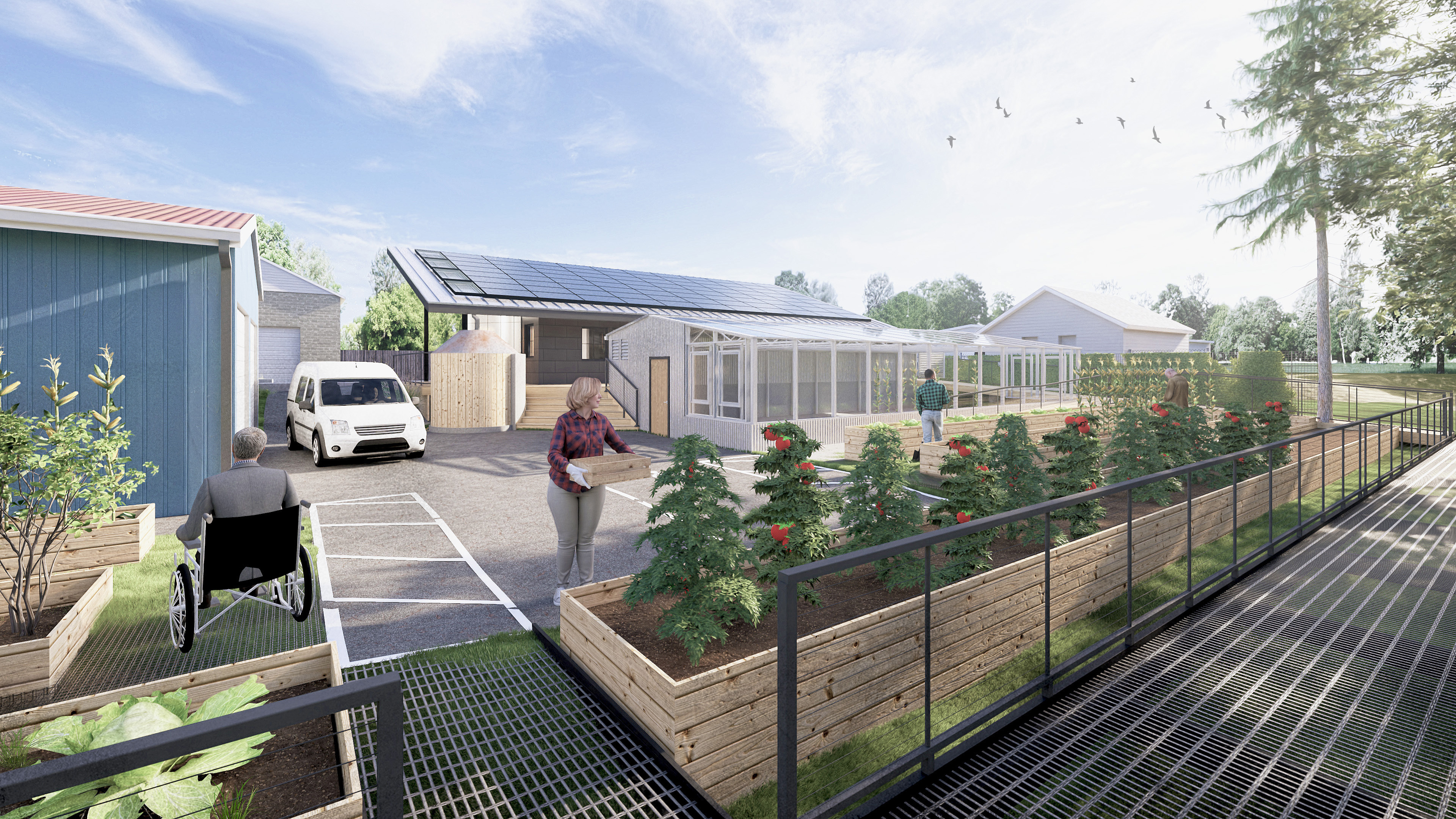
Food is at the core of the Yes-In-My-BackYard (YIMBY) program. Initially neighbors on the same block can opt for the backyard buy-in, giving them little stock in the shared entity, and giving the farming operation more area to cultivate ecologically rich food systems, where mostly dead "lawn" exists currently (mono-culture lawns are often less-alive that even deserts). Further stake/stock can be opted into with offers of labor and wall and roof surface area for additional ecological food generation, and sun (energy) and water collection to continue to maintain and expand the surplus-producing water and energy "nanogrid" (smaller than a typical microgrid). (link to YIMBY water, and YIMBY energy)
With the overhead costs of energy and water eliminated by onsite net-positive system surpluses, and to some extent labor supplied through educational partnerships, the cost of food production is significantly reduced. Through regenerative as well as technologically advanced (2 different things mind you) both food quality and quantity can be radically increased in close vicinity to where it is most needed. In partnership with DECA City Farms and others, the Glassmeyer Farm at Ramboland will be tied into an emerging net-work of urban food system nodes, providing not only nutritional, but also economic resilience, through shared ownership models.











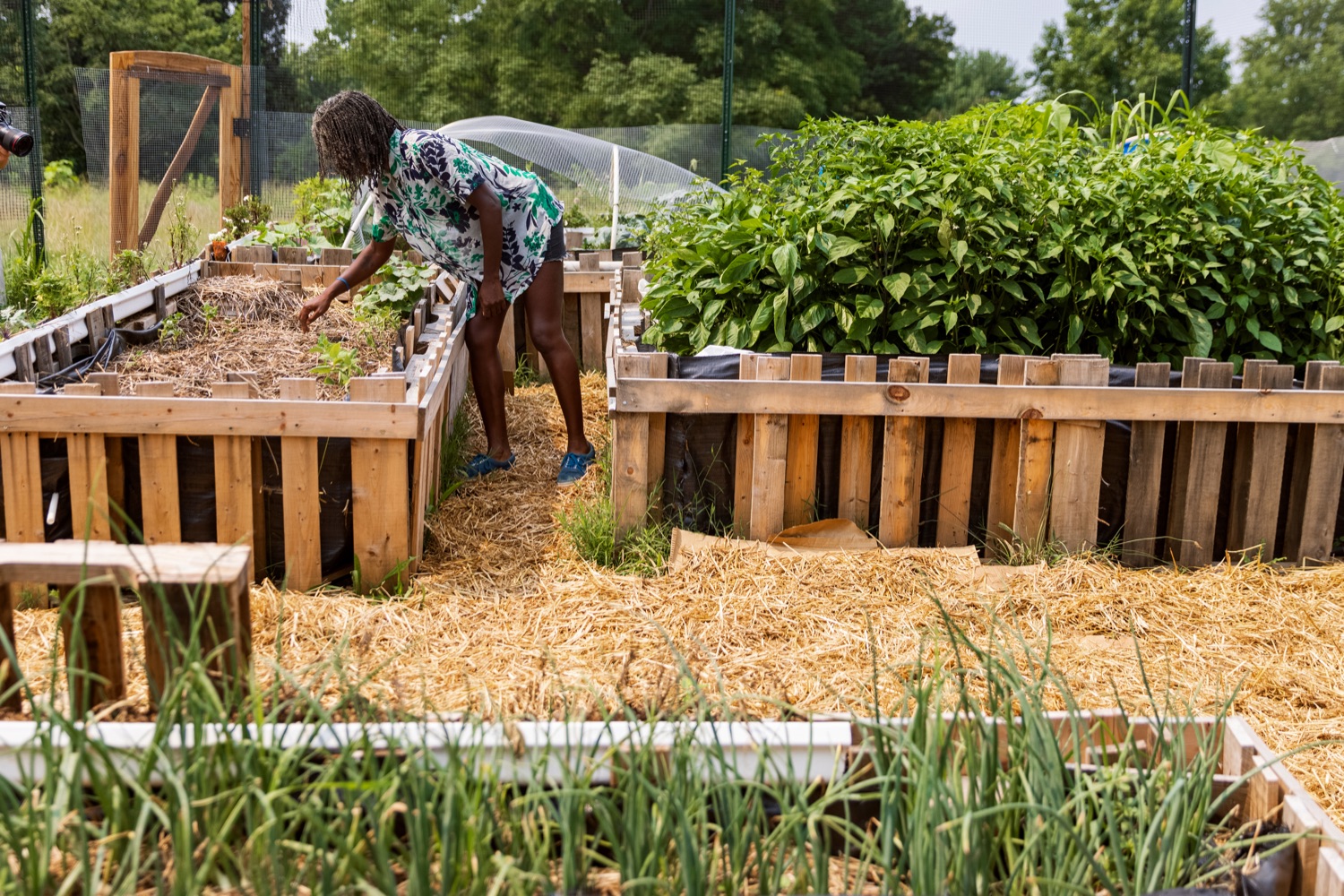
Urban farming efforts are often restrained by soil contamination and other contaminants in urban environments. In order to grow healthy food, Ramboland will bring in healthy soil, as well as commit to composting and other methods of producing more healthy soil, in order to continuously support the farm with soil that is free of contaminants, as well as spread the pattern of these activities across neighborhoods, through collaboration with partners and adjacent institutions on nearby open green space. Instead of planting turf grass and mowing it, which is associated with high financial and environmental cost, we aim to enable regenerative farming in those spaces. This will also be in support of just transition efforts for landscapes.












Urban soil, while often forgotten about or deemed so unhealthy that it can no longer fulfil its purpose, is essential in supporting urban green space, urban biodiversity, mitigating floods, and serving as water and carbon storage. The soil in urban environments is often heavily contaminated with industrial chemicals, landfill-like debris, and other health threats, which makes it mostly unsuited for urban farming purposes. However, like introducing specific plants, fungi, and/or bacteria to process chemicals and remove heavy metals from soil, and to absorb other pollutants from water or soil have been proven to be capable of addressing all of these issues if carefully and consistently applied, while also growing urban ecological health and diversity. Ramboalnd will serve as a proving ground and launching point for this activity, especially as its approaches grow through YIMBY.











.jpeg)
The alley, which we’ve been told by the city we may improve with the consensus of the neighbors we share it with, can serve as a spine for YIMBY expansion and connection to institutional future partners (hopefully) with nearby land. This will enable better connectivity of especially water and energy systems, hopefully allowing us to connect with neighbors who share our block, without solely relying on the EV’s for YIMBY partnerships.












As crazy as it may seem, transferring electricity across streets to other blocks is not that easy, and is usually prevented by what are called franchise rights: In many cities power companies hold sole permissions to run power lines over, under, and across streets. Sometimes Ecodistricts and other policy instruments can be used to rescind these legislated monopolies, but our crazy Ramboland engineers realized another, creative, counter-intuitive solution. In conjunction with the fact that electric vehicles have massive batteries, even compared to most whole-house battery systems, and the need for many neighbors to have more resilient systems, especially for medical equipment and their refrigerators, a clever transitional idea was born. Building upon the concept discussed in the “EV Battery” Tooltip we also plan to move freestanding batteries to & from the Ramboland site (which will have a surplus of renewable energy) with neighbors on other blocks that have signed up for partnership via YIMBY. Essentially the same thing will be done
with rain barrels and crops, when heavier payloads go down hills than the payloads being brought back up the hill, the EV’s may even have a net-gain of stored energy (battery-level). In an already well distributed energy, food, or water system this would not be necessary, but it is a bizarrely synergistic neighborhood system “hack” as we work to transition from dirty, dangerous, vulnerable, costly centralized systems.












The EV battery will function as energy storage, and transportation. Although it may seem ridiculous to transport energy between buildings using the batteries in EV’s, a great deal of recent research and analysis (citations forthcoming) is demonstrating that this may be a useful transition strategy. EV batteries are huge relative to those needed to support a home. The differences in schedules of energy production and use across buildings and vehicles offers opportunities to match peaks in energy generation and demand. Moving energy between buildings, especially from surplus producing ones like the house at Ramboland to other nearby homes without as much renewable energy production capacity, can even out . Until we have widespread blockscale “nanogrids” nested within neighborhood microgrids, we still need ways of moving energy between buildings and across streets, to supplement the traditional centralized energy grid with cleaner energy for greater resilience, especially in more vulnerable communities. Check out the “Satellite Block Battery Exchange” TT for more.












As the YIMBY model spreads, neighboring roofs can be renovated addressing issues such as leaks, wear and tear, and structural damage, as well as improving insulation. Renovated roofs will be equipped with solar PV (definition link) modules which will extend the life of the roof, shade its surface, and in connection with Ramboland’s core systems, create a solar powered electricity “nanogrid” (a small microgrid - microgrid definition link) in a vulnerable community, extending the benefits of clean and resilient energy to the neighborhood over time, as neighbors opt-in. All this work will also result in redirecting rain that falls on the roof and PV directly to community cisterns (definition link), or to rain barrels (usually 50 gallon barrels at the base of a home’s downspout) that can be picked up by the Ramboland EV. The additional power generation will provide for any electric pumping necessary, but in most cases gravity will do all the work.












Goal: Operate within the sites natural energy budget, and produce a surplus of renewable energy to share with neighbors












Formerly known as the “Back-yard buy-in program” the concept has long been that this will be a consent-based counter-displacement and wealth-generation-enabling strategy. In other words, it's been an answer to the question “how do we enroll neighbors who wish to join forces in a systems expansion and sharing approach that enhances their current homes and yards, expands the capacity of the Ramboland food, energy, and water systems, producing more of all those forms of value, and thus creating a revenue for existing neighbors without them needing any up-front money to do so?”
The intention is that it be a way for primarily the residents already living nearby to gain significant ownership (legal ownership ideally), in the systems we’re creating that will net
health and wealth after meeting basic needs on site… so that the proverbial short chains attaching their boats to anchors are broken, and so a “rising tide” actually can lift all boats, and not drown existing residents whose economic chains are shorter than the rise in tide. i.e. Economic development is only good for those that can remain to benefit from it without it forcing them out. Read more about how neighborhood economics work and COULD work.

Solar Arrays on Garage and House

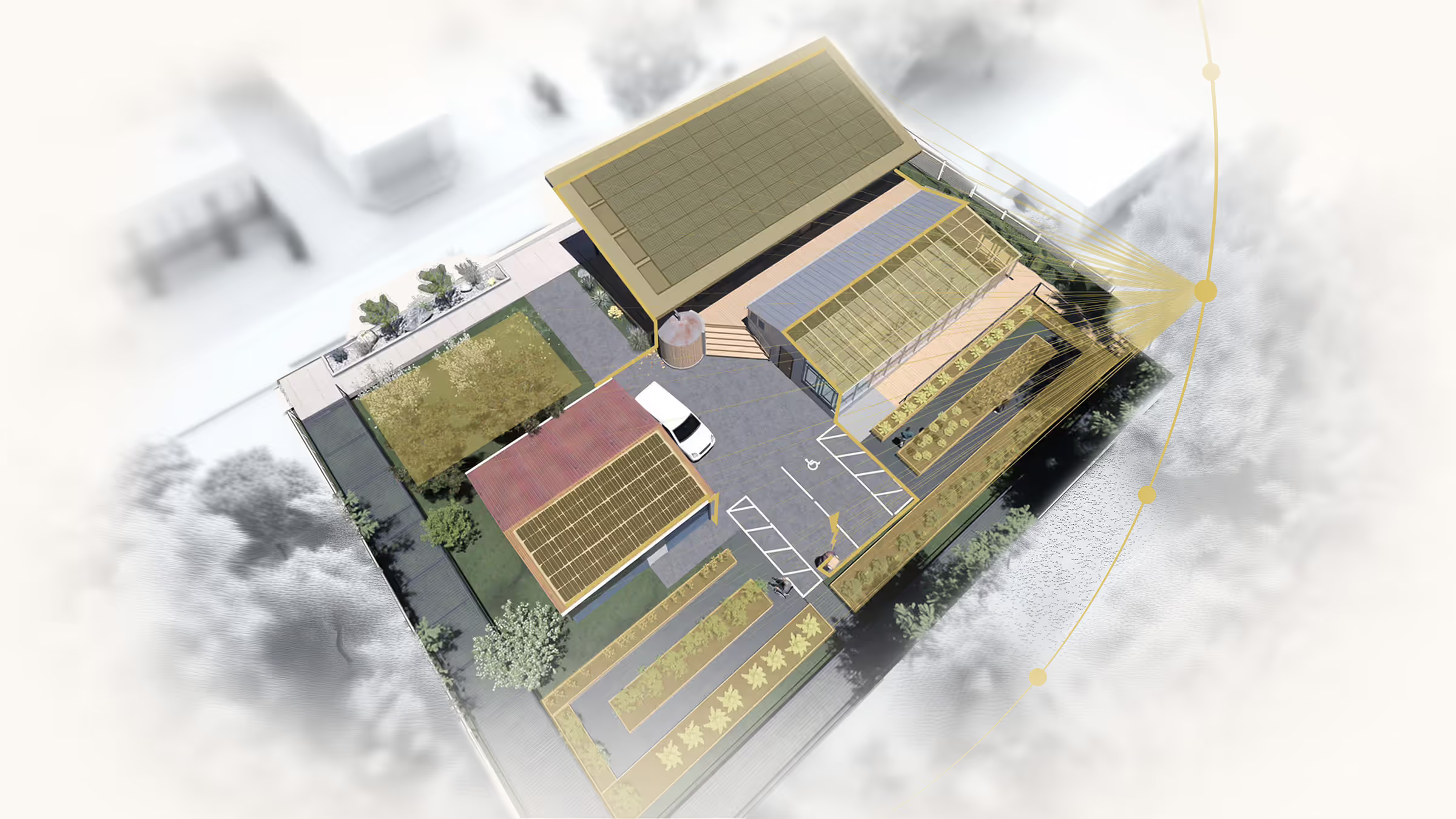
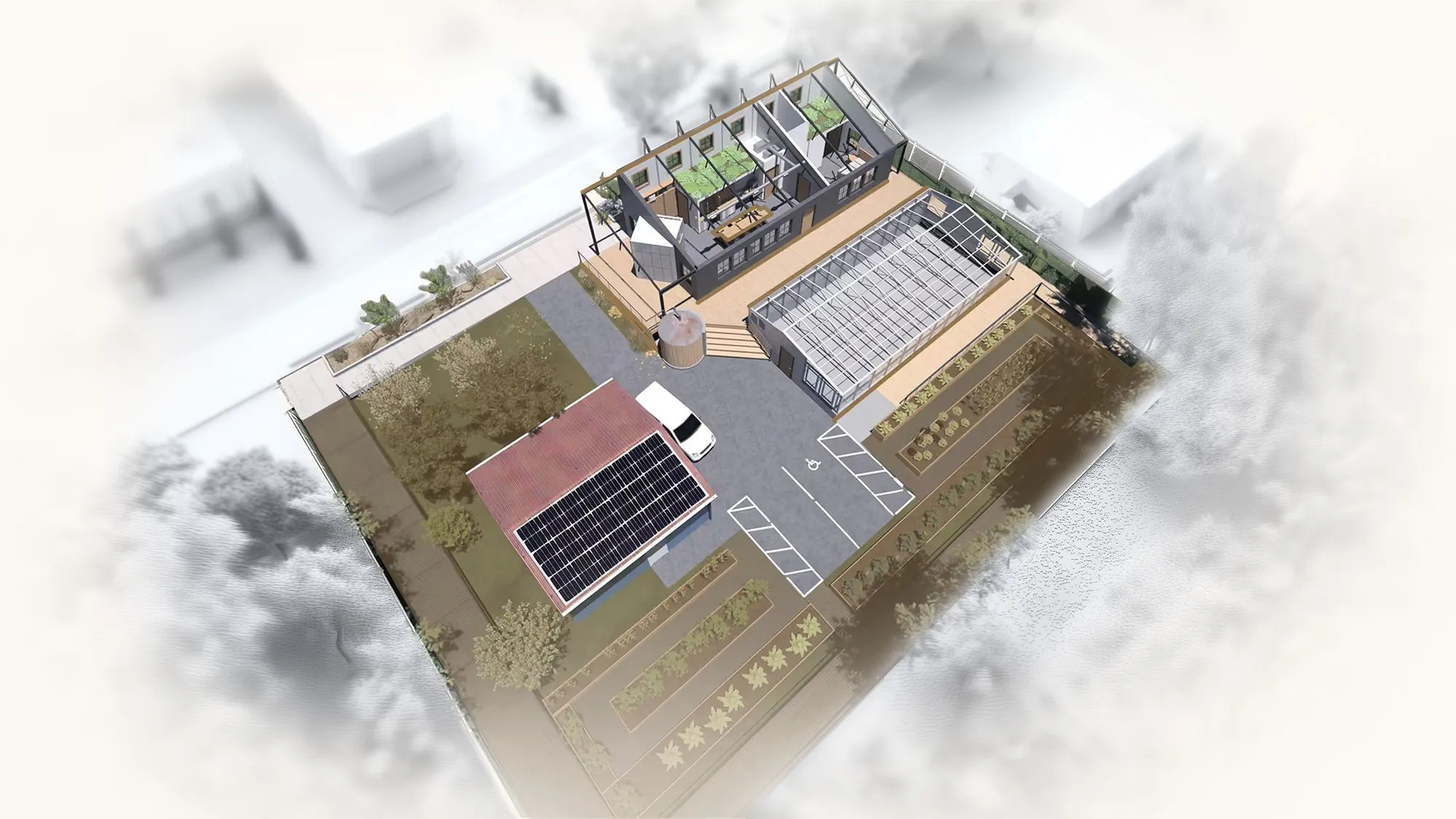
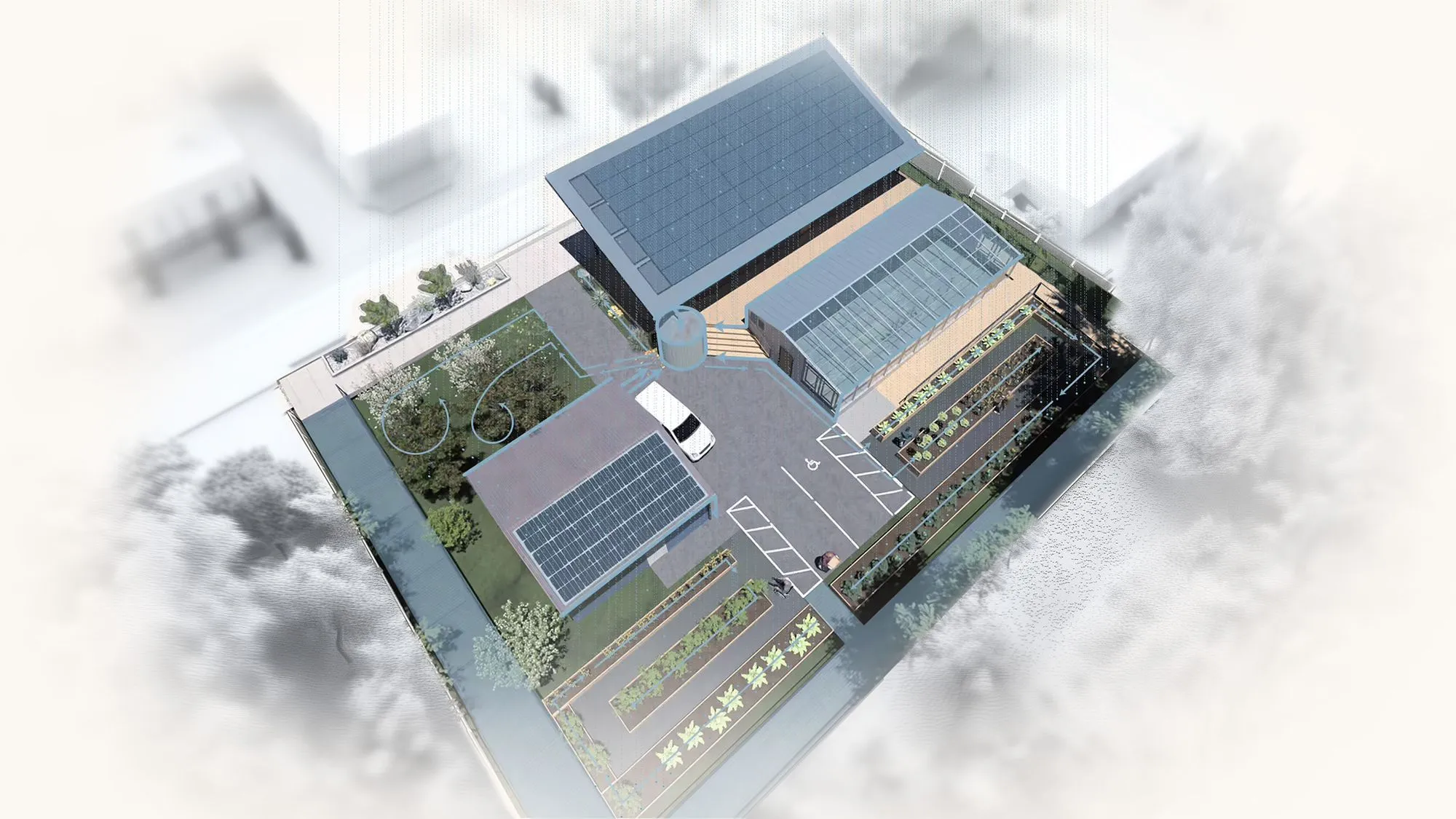
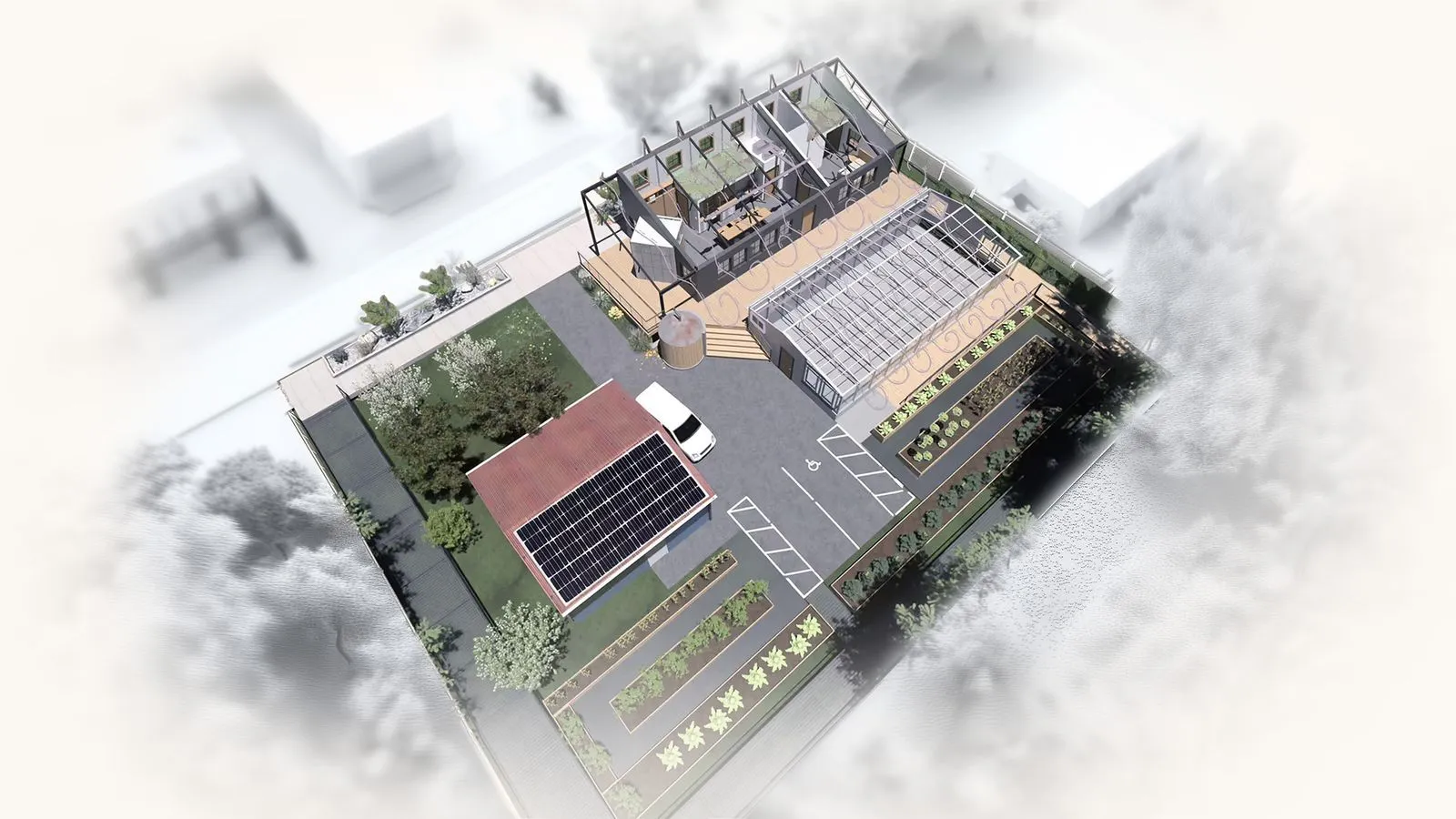
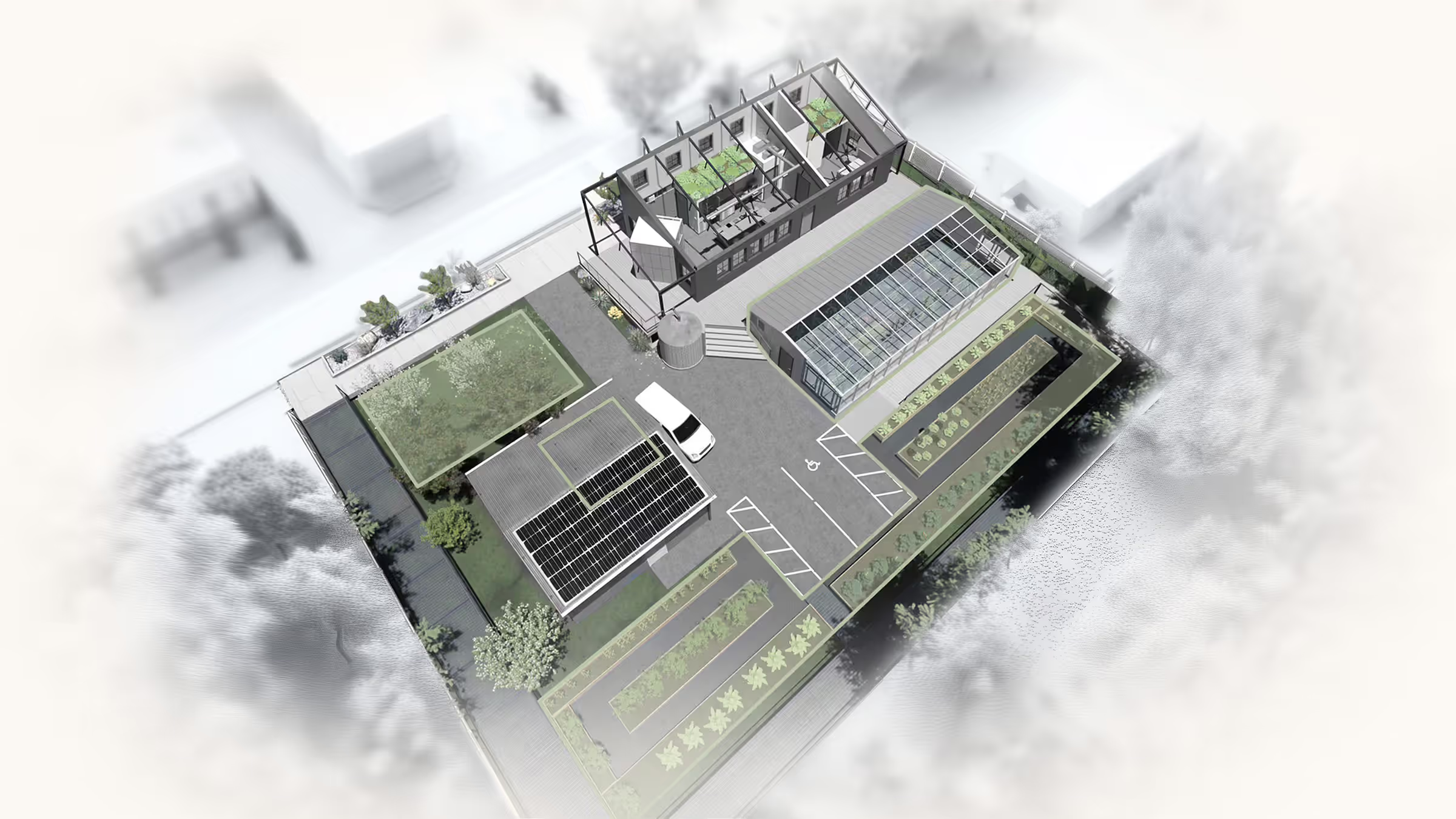
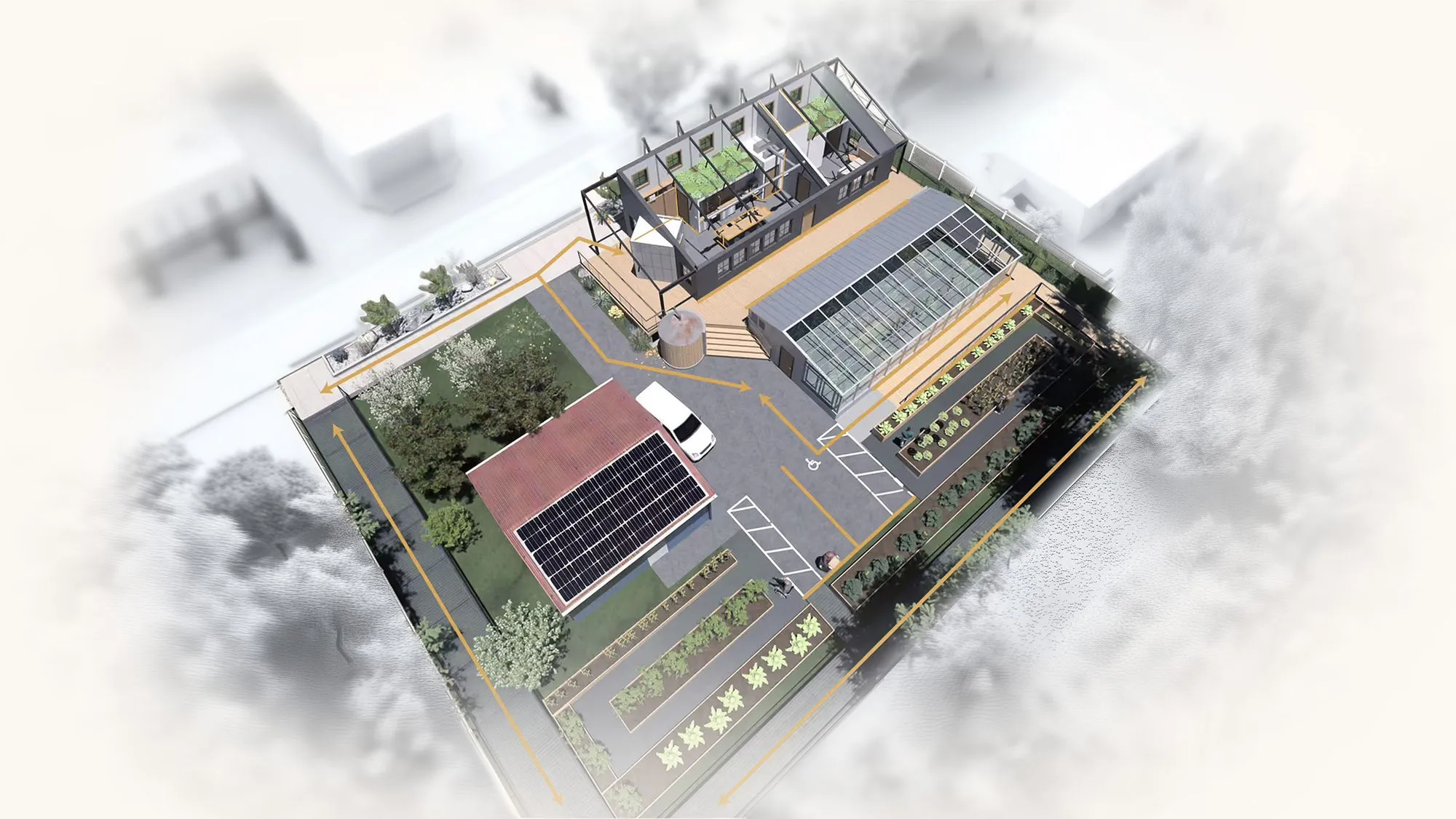










.jpeg)
Research and projects indicate that energy microgrids can achieve "islandable" status while producing a far smaller surplus of energy if they have massive and dynamic storage in the form of electric vehicles (EV) that are consistently connected to them via two-way chargers. We have wanted to provide a wheelchair modified EV as part of this project all along. Now it may have even more purpose.
This insight from one of our energy engineers triggered a set of unexpected additional ideas with one of our civil engineers and our food system and building architects. What if our YIMBY program, which expanded Ramboland’s system approaches to neighbors' yards, could connect across streets using the EV – transporting food, energy, and water? What if, instead of direct piping from neighbors' roofs to our cisterns, we placed rain barrels at YIMBY houses on other blocks, in this and other low-income neighborhoods, and would be able to transport them by EV if needed? It could be calculated based on rainfall and roof collection areas when those barrels would be full. The EV couldbring an empty barrel, and swap it for the full one, as well as take that water to one of our partner's sites, such as DECA City Farms, to fulfill additional water needs or provide chlorine free rainwater for food production. Having dropped off several full rain barrels the EV van with a liftgate would be empty and able to haul crops from the other farm to either locations where canning, jarring, pickling, etc could occur, or directly to a sales point or a free distribution point like a food bank, church, park, or community center.
This torque-intensive, low-milage journey is a perfect fit for the strengths of EV's, and it would likely return to its charger at Ramboland with a lot of remaining battery charge. If the nanogrid decided it made sense for economic or energy resilience reasons, that excess charge could power the house, recharge its batteries, or charge batteries in neighboring houses to prevent refrigerated food loss or medical device power loss during a blackout.
Likewise, the EV's could actually deliver charged batteries from energy surplus producing sites, to energy deficit suffering YIMBY partners as well.










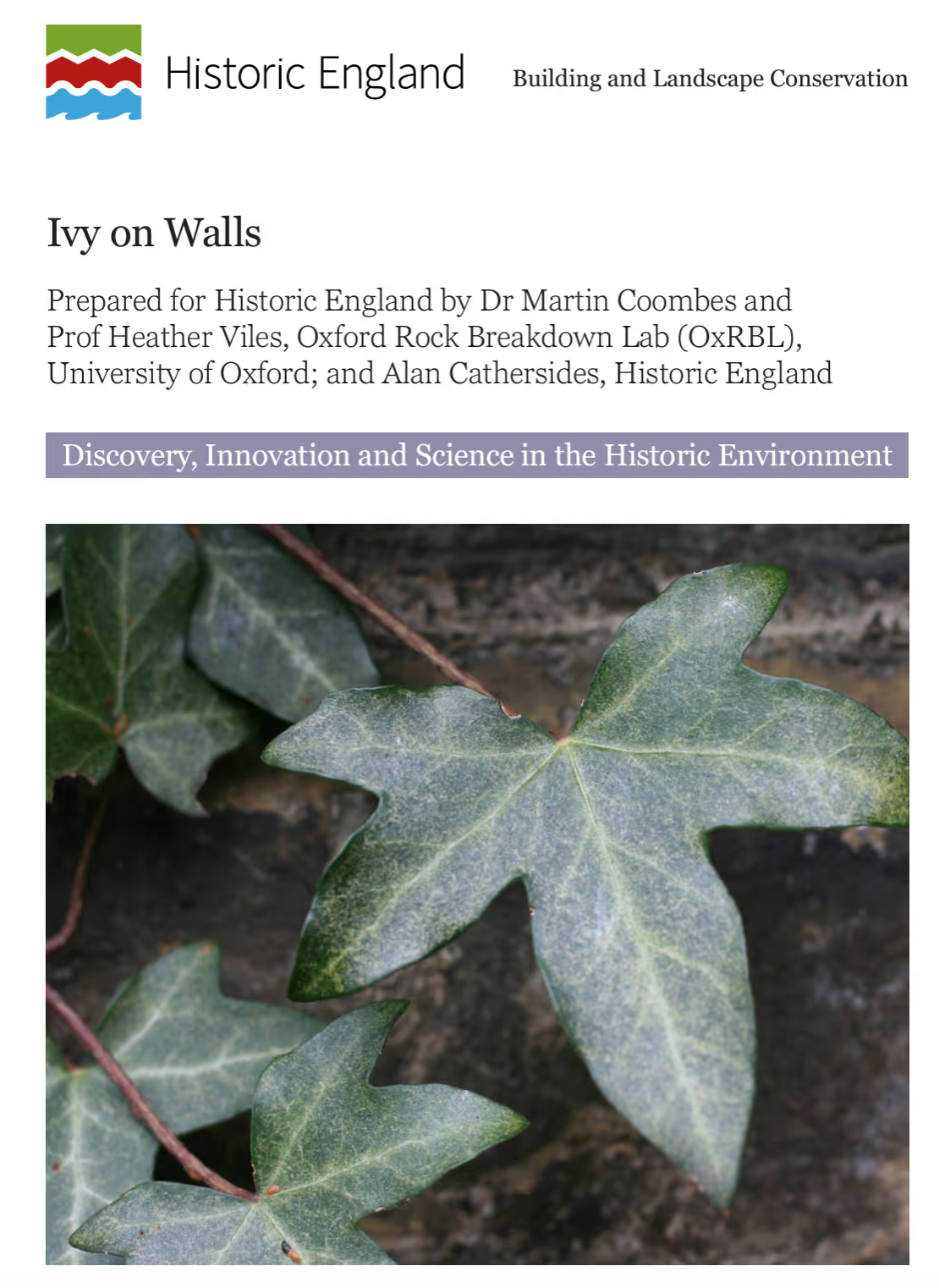
Architecturally structured pockets of air organized against north wall increasing insulation (effectively) on the side exposed to cold winter prevailing winds. In other words, closets, murphy beds, mechanical rooms, cabinets, bathroom, and even the vegetation on the exterior, all further protect and insulate the most thermally vulnerable exposure of the building. An Oxford study found that heavily vegetated building facades were not only an average of 15 degrees cooler in the Summer, but more surprisingly 10 degrees warmer in the winter!










.jpeg)
In most cities, including Lancaster, shared alleys can be improved and utilized in a number of ways as long as all the neighbors are in consensus about it. Utilizing some of this space to provide better wheelchair and pedestrian access through the core of the block and to the resources at Ramboland, for the neighbors, several of whom rely on access to their backdoors because the steps on the front of their houses are not manageable. Furthermore, a boardwalk can serve as a spine for conduit, hose, and pipe for the connectivity of neighbors enrolling in the YIMBY program to link up their homes to the Ramboland utility network.










.avif)
After we planned the building, we placed the mechanical room, closets, and a few other enclosed spaces along the northern wall of the home (*). We also designed the cross-ventilation so that as air warms, it rises and is pushed and pulled out through upper windows (**) above the mechanical room, using the prevailing winds. This left us with a design challenge: how to cap the mechanical room in a way that worked with the airflow and overall plan.
Leaving it open would expose the main living space to all the noise of the equipment in the mechanical room, and also eliminate the opportunity for that room to function as a space in which air is pre-cooled in the Summer or pre-heated in the Winter by the equipment***, before being recycled into the space by a combination of the fresh air supply system and the high efficiency heat-pump above the bathroom****.
Indoor green roof moderates temperature and humidity, improves IEQ, IAQ in terms of ?, O2/CO2
*link to Passive Design 3 Tool-Tip
**link to Cross Ventilation Vignette
***link to HVAC pre-conditioning (not yet written)
****link to explanation of mechanical equipment











Since air conditioning (cooling) caught on in the U.S., designers of our buildings have largely ignored the effects of sunlight and wind on them, and as an industry and culture we've mostly lost touch with ways of not only reducing unwanted heat gains in Summer and losses in Winter, but conversely also don't typically consider or know how to maximize the beneficial inverse of these factors.
Surrounding massing of buildings, trees, topography, and
other structures are of course also key considerations. If there is or even may eventually be a large mass that blocks the sunlight to the south of the building, the southern windows won't be able to catch direct sunlight to gain more heat in cold months.
Surrounding elements can also be used to great advantage also. For example trees that drop their leaves in cold months will let sunlight through to reach the buildings and heat them, while they're fully leafed out canopies create shade and cooler microclimates underneath them in the warmer months. This makes them a great contributor to energy efficiency when they are located to the south, east, and west of the building. Coniferous trees which maintain their vegetation year round are very helpful in blocking cold winds from the NW direction in the Winter, and hot sun to the east and west, and even the north near the Summer Solstice.










.jpeg)
Most people are skeptical about including support for bats in their local ecology. But then they learn what bats eat – insects. Particularly since the Zika virus, Malaria mostly in other countries, and other mosquito borne pathogens made their debut,
Google AI Overview
Bat boxes can be good for a variety of reasons, including:
Protecting your yard: Bats eat many types of insects, including mosquitoes, moths, and beetles, which can help keep your yard pest-free.
Providing a safe place for bats: Bat houses offer a safe place for bats to roost, especially when they're raising their young.
Helping bats survive: Bat populations are declining due to habitat loss, and bat houses can help provide a place for bats to roost that they might not otherwise find.
Helping the environment: Bats are important pollinators and seed dispersers, which can help plants grow in new areas.
Being fun to watch: Bats are fascinating to watch, especially during their nightly acrobatics.










.avif)
As with the more public living/dining/kitchen/guest room, we wanted the bedroom first to be optimal in terms of accessibility and health effects, then second efficient in terms of space. Like the more public side of the wall, this room must not only be a medically well-equipped but homey bedroom, it also must be an entertainment space, dressing area, and an exercise room. While we did some tricky things with convertible furniture in the more public room, in this room we simply hung the entertainment system (TV, and HDMI streaming product, and a small soundbar with a great wireless headphone connection) from the roof/ceiling with some basic, inexpensive, but safe and strong hardware. We will likely add a single-size murphy bed as well, in case the queen sized one in the office nook is not sufficient for all the guests on a given night, or in the event that the caregiver needs to be in the same room for some overnights.











Ramboland features a pollinator hotel under the porch facing driveway. Pollinator hotels provide bees and other important pollinators with a safe site for nesting and overwintering, which offers benefits to humans and pollinators, as they are essential contributors to biodiversity and a healthy ecosystem. In urban environments, where natural habitats for pollinators are limited, integrating pollinator hotels in a green space or urban farm can increase biodiversity, lead to a more sustainable urban ecosystem, and enable agriculture that doesn't require herbicides and pesticides. Pollinator hotels are also great educational tools, raising awareness about the importance of pollinators and habitat conservation.










.jpeg)
Extended ramp and pier enable both accessibility and a diverse range of accessible viewing positions for those reliant on wheelchairs.










.jpeg)
Many crops can be simply upgraded with some labor. Canning, pickling, etc. can extend the shelf life of food, and increase the price it can fetch if sold. Food processing can happen on-site in the garage, minimizing transportation of crops. (Link to Vignette)










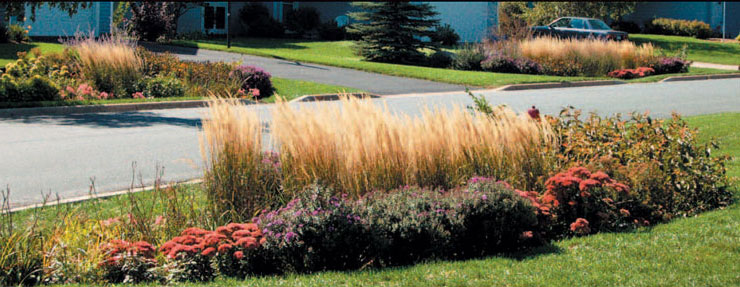
Including a bioswale where many developments would include a strip of turf grass in between the sidewalk and the curb and street has numerous benefits. In this urban agriculture project it can serve as additional area for food producing trees and possibly other plants, although the water treatment the plants in the swale will be performing will make it important for us to select species that don’t allow contaminants to make their way into the harvested portions of the plants (fruits, etc.). In addition to cleaning the water on its way to a sewer or cistern, these systems also slow the flow of the water, making managing the rainfall easier. They also serve to create an even stronger barrier between motor vehicles and vulnerable users of the sidewalk that a simple curb does.










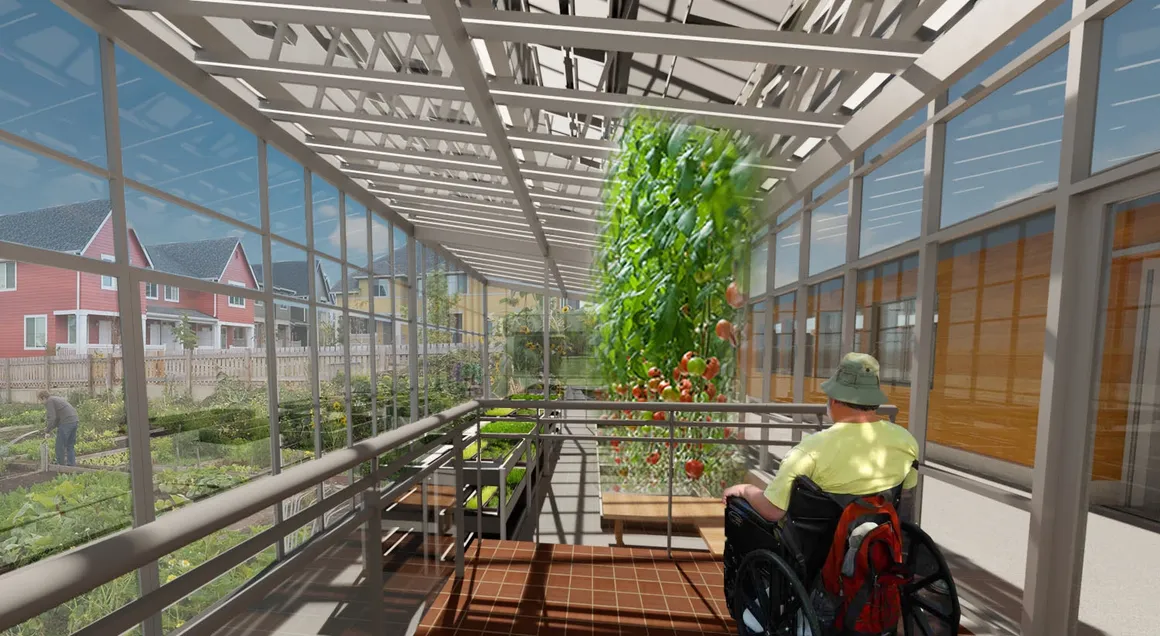
"Starts, growth, upgrade, teach, eat.”
The Ramboland “Fooding” System consists of the Greenhouse - used mainly for plant starts, the raised beds - used for plant growth, as well as the orchard, vertical screens, indoor green roofs, and outdoor green roofs – all on site. Ramboland’s on site “Fooding” System will produce much of the nutrition needed for the occupants and visitors of the house. Supplemented foods will only be needed for personal preferences and perhaps in the dead of winter, but we plan to tune portions of the greenhouse to address even the dead of winter. The agricultural products will also lead surpluses that can be sold and/or help feed food-insecure community members. The garage will be used for food processing like canning, jarring, pickling, etc., to increase the dollar value of the food and extend its shelf-life, also extending some of the food’s availability into cold winter months.
The site is just part of what we consider the “Fooding” System however, as partners like DECA, YIMBY (link to definition) urban farming efforts, and other future collaborations and farming opportunities will create what we plan to be a resilient system that can feed not only partners and YIMBY residents, but help bring healthy, affordable, and nutritious food to the entire community, eradicating food insecurity in Lancaster.











As water changes phase from liquid to gas, when it reaches the right combination of temperature and relative humidity in the air around it, it absorbs a bit of additional energy from adjacent molecules. This causes a cooling effect, which is why we sweat too cool ourselves, and many other living beings do similar things. It's also why a forest always feels a bit cooler than less vegetated areas nearby; their canopies are actually usually hotter than a "natural" area without trees, but thanks to the shade and this evaporative cooling effect, the area under the canopy is often cooler, so generally speaking: vegetation has a cooling effect on an area. Swamp coolers also take advantage of this, spraying a mist into a space. They are among the simplest of active cooling systems, simply using a pump and a fan, and some water. Luckily most times of year we'll have more water than we need thanks to our large rainwater treatment and storage systems, and the projected increase in total annual water arriving in fewer, bigger rain events.











A forthcoming level 2 (definition link) , possibly even level 3 (definition link), and definitely two-way charger (definition link) will not only support the optimization of the performance the Ramboland site (house plus Glassmeyer Farm; see TT about EV batteries) and the Ramboland Electric Delivery Vehicle, but also support other neighbors and their charging needs with clean renewable energy at lower cost than most stations - generating additional revenue for Ramboland and the co-owners amongst neighbors of those systems. In other words, it will be an additional way to produce revenue from a growing renewable energy system via YIMBY (link), justifying nearly limitless growth and renewable energy overproduction.











The kitchen will be a demonstration both of the best accessibility products and creative ways of arranging them to maximize their usability for as many users as possible; products like pull-down upper cabinets, height adjustable counters, sink, and appliances, and a wheelchair pull-in space between all of them, as well as space to add an upper refrigeration unit should Ron or other visitors or residents wish it to be available to those that can reach those higher levels. The induction cooktop will be embedded in the height adjustable island, with prep space between the two pairs of burners to improve usability by those preparing foods from a wheelchair, minimizing the need to maneuver the chair repeatedly while moving food and cookware onto and off of the safe induction heat surfaces.
Links to:










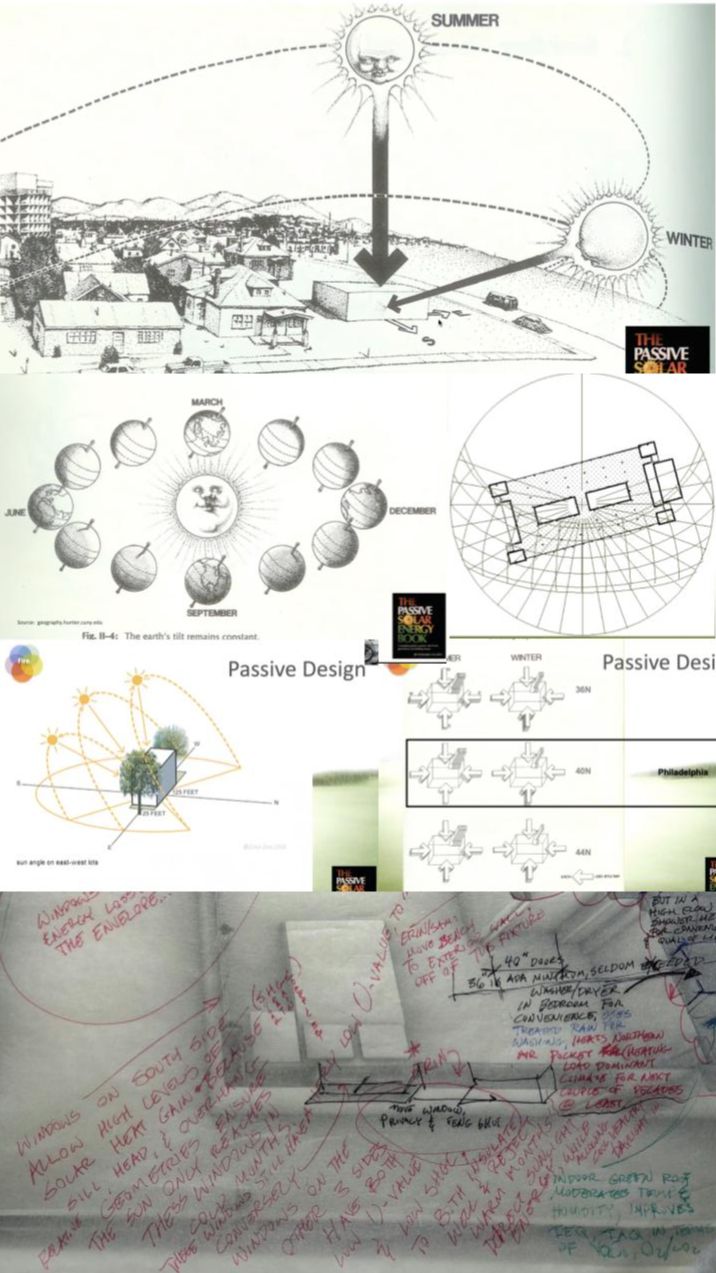
Windows on the south side allow high levels of solar heat gain because window sills, headers, and roof overhang relative geometries ensure the sun only reaches these windows in cold months, when we want the heat gain. In those months the sun angles are lower, and can get under the roof overhang to pass into the house and assist with heating it, reducing the burden on the mechanical heating systems. These windows still have a very low U-value to insulate well, however. Conversely, windows on the other 3 sides have both low U-values (insulate well) and low SCGC (Solar Heat Gain Coefficient), so they reject solar heat gain in the warmer months when we can't prevent the sun from reaching them. However the house has also been shaped and oriented such that we have far more southern exposure than east or west, because again, the southern exposure doesn't receive heat in the warm months, and does in the cold months. Conversely the minimized east and west wall sizes do the opposite of what you want them to; they gain heat in the Summer and don't in the winter, because the Sun rises farther northeast of the house and has more time to heat up the eastern side of the house in the Summer, and likewise spends more time heating up the western side of the house as it sets, which is also generally when the ambient temperatures are highest (afternoon).











The almost literally beating heart of the machine aspects of the house are in the centralized mechanical room. Water, air, and energy management systems are placed here, along with the laundry. Some HVAC equipment is just on the other side of the wall, placed above the bathroom ceiling plenum (definition link). These central locations allow for several benefits:
This mostly unoccupied space can serve as an additional buffer against the north wall (link to Passive Strategies TT), and be allowed to have temperature and humidity setpoints beyond typical human comfort ranges, reducing energy use to regulate that.
Duct, wire, conduit, and pipe lengths will be minimized because nearly all destinations for these conveyance systems (definition link) will just on the other side of a wall or ceiling from the mechanical room. This will not only reduce cost and environmental impacts via material use reductions, but the resistance you get from every linear foot of pipe or duct is reduced, which means pumps and fans don’t need to work as hard.
Placing all this equipment indoors (some of which would be placed outdoors or in basements in other cases) not only allows them to be more easily and effectively maintained, but it gives us a central place to show them off on this educational demonstration project.










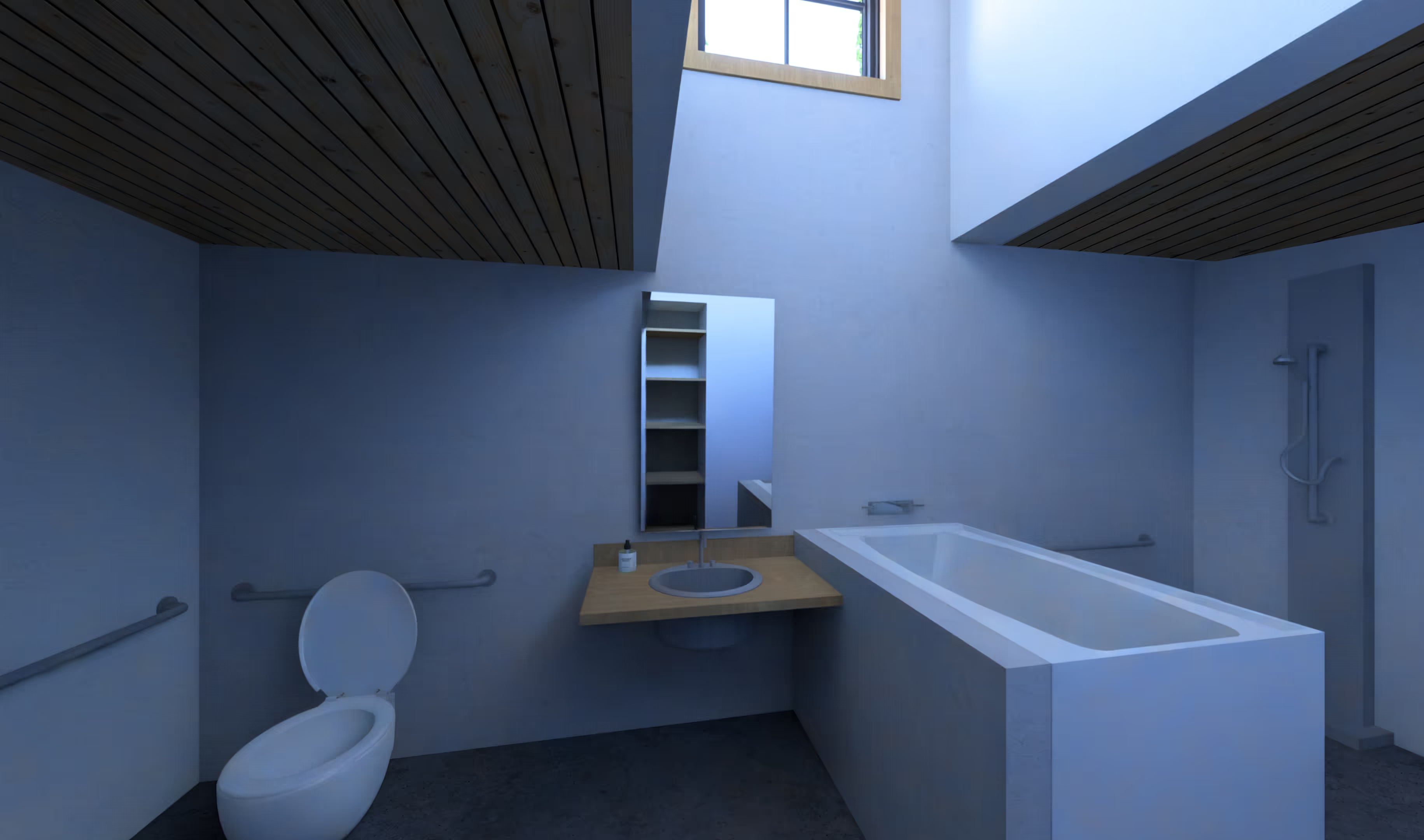
The look and feel of the bathroom will be spa-like, featuring a simple material palette, light colors, and a clean aesthetic.
The bathroom will be spacious for optimal wheelchair use and caregiver support.
Features like grab bars will be placed throughout the space (more than are required), because again, caregivers often rely on them also, and not everyone will always necessarily have access to the suspension system.
Links to:










.avif)
The house is oriented to optimize sun angles, penetrating or not, depending on time of year and day*. But the house is also designed to account for prevailing winds.
"Prevailing winds" is a term for the direction wind tends to come from, and in this climate they have tended to come from the Northwest in the Winter (when we don't generally want to be hit by cold air), and the Southwest in the Summer (when we often can benefit from some cross-ventilation and cooling).
So the house is designed with blocking the (north)westerly cold winter prevailing winds in mind, with additional layers of vegetation, insulation, walls, trees, and pockets of air**.
Likewise, the house is designed to scoop up the southwesterly winds in warmer months, so when the temperature is within certain ranges the windows can be opened, and the movement of the air can create whats called "expanded thermal comfort." This is a term for the effect of more air molecules hitting your skin and absorbing some heat from it thanks to the air moving. This increases the rate the body can release heat energy, and thus requires the air to be less cool than when it's not moving as much. Ceiling fans also offer this benefit but use up some electricity to do so (though less than air conditioning).
When early on in our design process the addition of a greenhouse was being considered, we were concerned this might jeopardize our cross ventilation because the greenhouse would block some of that southwesterly winds in some of the warmer months of the year. So we did a type of analysis called Computational Fluid Dynamics (CFD). This technology has been used for a longer period in automobile and aeronautical engineering and design so that cars and planes could be made more aerodynamic. The old fashioned way to do it is to place a model of the geometry of the object being designed in a wind tunnel (literally a room with fans at both ends to create high air speed in one direction), and then smoke being blown blowing in the fan so that the airflow is visible to the observers. CFD software allows us to assess our design in a virtual model without building a physical one yet.
Somewhat to our surprise, the introduction of the greenhouse created whats called a Venturi Effect. This is the phenomenon in which sending a fluid (usually air) through a compressed space causes it to speed up, like a nozzle on a hose, or the tapered or fluted cooling towers and smoke stacks on factories and combustion-based power plants. The breezeway between the house and the greenhouse is angled enough towards the prevailing southwesterly winds, that it captures enough wind and compresses, that that wind is actually accelerated into the house a little bit more than if the greenhouse weren't there.
Using CFD created a lot more confidence that we could not only add the additional complexity of a diverse and high tech food system to the project without sacrificing other performance goals, but in fact enhanced our achievement of those goals. The house will actually be able to use active, electricity consuming air conditioning a little bit less, because our breezeway pushes the air a little bit faster into the south-facing windows in house. As the air inside heats up a bit from contact with warm human bodies and other heat sources inside the house, this will actually help it rise a bit and then more effectively be sucked out of the high-up windows on the north wall of the house. The CFD allowed us to do a lot better than the typical ""wishful thinking arrows"" designers so often use to represent how they hope the air will flow!











Our goal of having no water leave the site horizontally unless it's in a living body (humans or other animals, or plants, usually in the form of crops). In other words any water we need to send on its way beyond those uses must leave vertically, either downward to recharge the aquifer (definition link), or upward into the sky through evaporation and evapotranspiration (definition link). This is very much how a healthy, verdant forest in this Lifeshed (definition link) works. This demands that, like a forest, we gather as much of the rainfall as we can, and use it for living system needs, often multiple times, before letting it go. This allows us to get through dry months and even full droughts, but it also means at other points we need to contribute to preventing flooding in surrounding areas but still get rid of some water, when we’ve already received plenty or even too much rain. Our huge water storage capacity will be more than sufficient most of the time, again helping with increased droughts in the future, driven by climate change. But we are also projected to get more rain in fewer rain events (i.e. big rain storms). NOAA (definition link) and other services can predict this to some extent, and we can utilize predictive information about additional forthcoming rainfall to realize we need to get rid of some water. Our first strategy will be to increase irrigation to the upper levels of our crops’ tolerances. Likewise we’ll maximize our distribution of water to local agricultural partners. Then we’ll have to get more creative.
The two main factors that reduce PV (definition link) efficiency and function are dirt (obscuring the cells from sunlight) and heat. Rinsing our solar panels would address both of these issues, and any water that didn’t evaporate into the sky, would go back through our water treatment and collection system.
Inspired initially by our goals to clean the air in the neighborhood, and realizing that air is cleanest after a big rain storm (having effective “rinsed” the atmosphere of particulate and contaminants) we had another idea. What if we misted site and its surroundings. Not only would this cool the air on the hottest days, but it would also clean it significantly. Then we realized we weren’t the first to think of this. Major cities in China, who had been suffering from the vicious cycle (definition link) of SMOG (hot conditions increase energy use for cooling, which increases energy production at power plants, many of which were actually in the cities, those plants produce more SMOG, making it hotter through the greenhouse gas effect, demanding more cooling, energy-SMOG-cooling-energy-SMOG… and so on). To attempt to short circuit this runaway set of problems they began using some of the energy to blast mist into their cities from huge water canons atop many of the buildings. While this increased energy use even further, it did contribute to SMOG reduction, and thus cooling energy use reduction, and so on. While our neighborhood’s situation is less dire and on a very different scale, the added benefit of releasing some excess water using excess renewable energy, and having all these additional benefits makes some sense, as counterintuitive (definition link) as that may me!










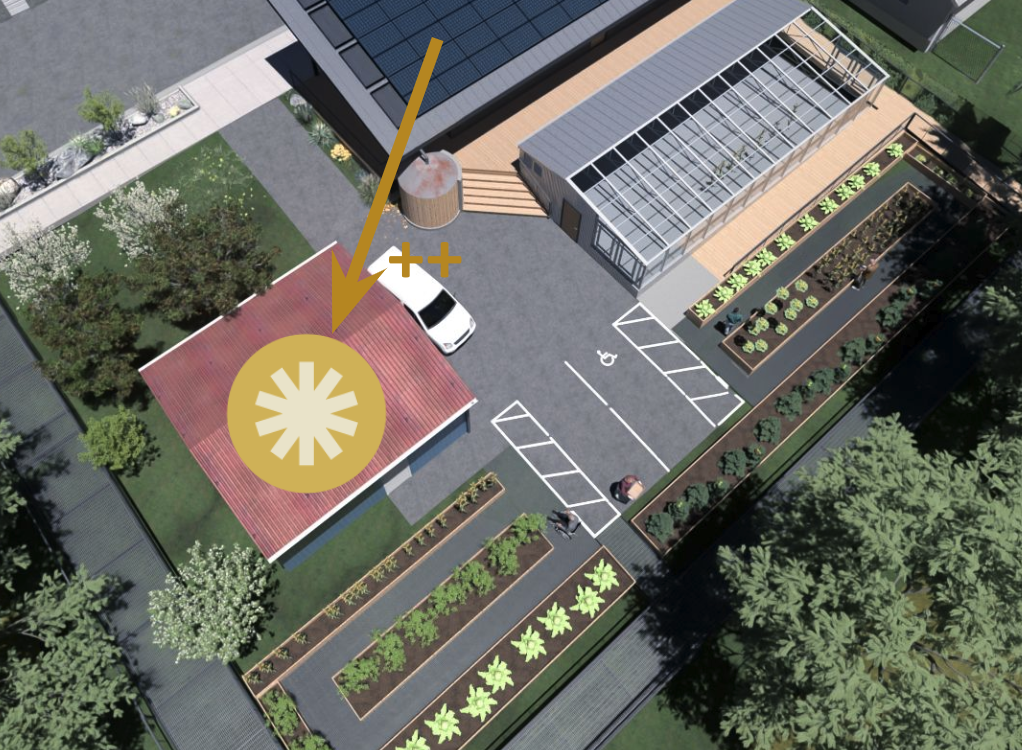
As additional technologies emerge and our ability to utilize surplus energy (for revenue and/or great resilience for neighbors) is proven and perhaps grows, utilization of the preexisting surfaces of the garage will certainly make sense. Ramboland sits at a high point in the city, and thus offers some interesting opportunities for wind generation.
Wind turbines (forthcoming link to pronunciation rant) are great in several ways. They tap into a free, ongoing, renewable “fuel” source - namely the wind generated by a multitude of interrelated factors including the rotation of the Earth, global, regional, and local topography, thermal and physical flows in water bodies, and thermal and pressure dynamics in the atmosphere. They tend to produce more energy at times solar energy systems are producing less or none (cold months and nighttime), making them an ideal addition for a more holistic approach at certain scales. Wind technology is generally limited to larger scales, because of the size of most wind turbines. They can however be disruptive to humans and other creatures alike, primarily via noise (they tend to emit a low hum or whine that is audible close to them). Noise, we have learned more recently, is one of humanity’s biggest forms of threat to other living systems, not to mention our own psychology. That said there have been some particularly interesting smaller scale technologies developed. Whether it be VAHTs (definition link) that can sit on top of building peaks or land high points, or an emerging technology we have discovered which is technically a HAWT (definition link) like the big white whirlly pinwheels we all have seen, because their axle is horizontal, but they are designed to sit directly on top of a roof ridge to take advantage of the fact that air must speed up to get over and around buildings. What little noise this newer technology creates will be fairly separated from Ron, our neighbors, and our building integrated habitat systems.
Note that wind turbines of any sort are less common in residential applications in large part because they have many moving parts (unlike solar panels), and thus have greater maintenance issues and costs. Not to mention that most of those moving parts are usually at the top of a mast, making them hard to get to in order to work on them. This all effects their lifecycle cost and feasibility, and it probably doesn't make sense for most single-family homes. Like so many things at Ramboland however, we think they might make a lot of sense for the "Goldiblocks" scale!











In most modern built-environment practice it is assumed that a human-built edifice must displace living systems – plants, insects, fungi, other animals, etc. And this is one of our self-fulfilling prophecies. Not many have taken the time to question this like Ken Yeang has. He not only challenges the idea that building must result in a total loss of biomass, but that perhaps there could be an increase in biomass, diversity, vitality, and overall living system health AFTER we have built what he calls 'ecosystem prosthetics.' After all a prosthetic is a human-made tool, instrument, or system designed to restore or expand function and/or independence. What are buildings doing if not expanding an ecosystem's ability to meet our human needs? This framing liberates creativity, but it also exposes the ways in which our buildings
aren't so great at fulfilling their own purpose. Indeed, a prosthetic that makes its user sicker, and/or kills life around its user like our buildings do, would not be considered a very good one.










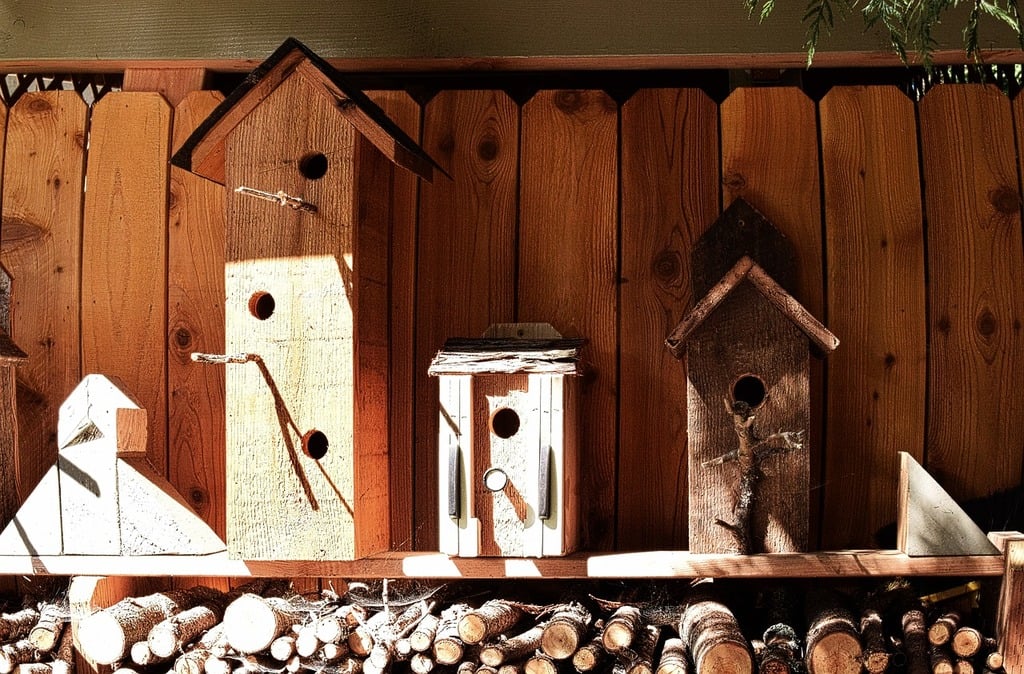
Bird Houses are probably the most common form of human provided shelter or habitat for other species that aren't considered pets or "live stock." Birdhouses can be designed to accommodate somewhat specific species, to support overall ecological health and help to naturally manage insect and other animal populations – what some call "pest control." Personally, we think that term feels like putting two curse words together.
Birdhouses, also known as nest boxes, are beneficial for many reasons, including:
Nesting: Birdhouses provide a safe and private place for birds to nest and raise their young.
Wildlife habitat: Birdhouses can help qualify your outdoor area as a National Wildlife Federation Certified Wildlife Habitat.
Winter refuge: Birdhouses can provide a safe place for birds to roost and sleep during the winter, especially when protective foliage is scarce.
Pest control: Birdhouses can be used to attract swallows, which can help manage flies on farms.
Birdwatching: Birdhouses can provide a great opportunity for birdwatchers to observe the breeding process.
However, poorly designed birdhouses can be detrimental to birds. Some things to consider when placing a birdhouse include:
Location: Place the birdhouse out of the wind, rain, and strong sunlight.
Height: Place small-hole boxes 1–3 meters above the ground on tree trunks.
Materials: Use rough-cut wood slabs, tree sections, or 3/4-inch plywood. Avoid creosote-treated wood, which can kill eggs and chicks.
Paint: Paint the outside of the birdhouse with a dull color that blends in with the surroundings. Never paint the inside of the birdhouse.










.jpeg)
Vertical vegetation walls
Vertical vegetation walls offer benefits for both the environment and the buildings they essentially become a part of. They can improve air quality by acting as a natural air filter (absorbing pollutants and producing oxygen), regulate building temperatures (cool buildings by reducing the amount of solar heat absorbed by the walls, and also reduce urban heat island effects), reduce noise pollution (absorb sound, helping to reduce noise pollution in urban environments), and contribute to biodiversity (provide habitats for insects, birds, and other wildlife, help support biodiversity in urban areas). They can also help reduce stormwater runoff by absorbing and holding water.
Outdoor green roof
Green roofs can serve as habitat for numerous species, playing a role in a balanced and self-managing urban ecology. Species found in healthy, curated (initial species selection) green roofs include various insects, birds, and even some small mammals. They can act as stepping stones for migrating species, link fragmented habitats, and increase biodiversity in urban areas.
Indoor green roof
The indoor green roofs act as caps over one-story rooms or closets, allowing air to flow over them to support cross ventilation. This solution allowed us to cap those spaces in a way that minimizes cleaning and maintenance, adds additional insulation—particularly sound insulation in the case of the cap over the mechanical room—and provides added benefits such as indoor air filtration and oxygen production.










.jpeg)
Attitudes towards rain as a nuisance ("stormwater" is a pejorative term) or instead as a life-giving precious blessing (rain/water) are both self-fulfilling prophecies. We pick the second attitude. Our goal is that the hydrology of the site be nearly indistinguishable from that of the temperate forest that previously occupied this site and its surroundings. To that end rainfall is collected to be stored & used to support living processes, often several of them, before leaving the site.
Smog, bird droppings, and pollen are easily removed to create pristine water without chemical hormones, pharmaceuticals, fluoride, chlorine or Cr6), while maintaining some nutrients living bodies can benefit from. Tap water with added chlorine to kill pathogens does not make great irrigation water either, because it is a biocide.











Raised gardening beds on-site are a good solution for urban farming as they allow for soil quality control, enhanced water drainage, and ease of access for people with and without mobility limitations. Raised beds will also be part of the YIMBY food system for the same reasons.










.jpeg)
It was important to Ron to have an office space, to do email and participate comfortably on Zooms. It is also important to his health and the ideal functioning of a home that accommodates a caregiver to stay overnight, at least on occasion. Given the opposite timing and some complimentary shared equipment (big TV/monitor, table surface, etc.) and our goal of maximizing feasibility and cost-effectiveness, despite doing so much more) we felt we could combine these two spaces into one. Using a large, elegantly disguised murphy bed system, we have designed a lovely, daylight, highly functional area that we believe serves both of these important uses in the same square footage. Another technique added to the list that includes the dynamic/transformer-like furniture we are including elsewhere (link to table Vignette)










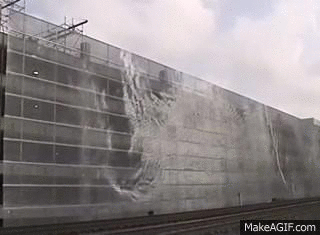
What better place to put a WIND veil than a BREEZEway?! Wind veils are beautiful, biophilic building screens that indicate the flow of air, creating liquid-like waves (which have been found to have a calming effect on humans) across the surface of the building. Not only will this be a way to create an educational element, but a way to add some beauty to a wall that was solid because of the need for energy efficiency in the greenhouse. This will help us to actually observe how accurate our CFD (computational fluid dynamics) analysis was, when we were concerned about the greenhouse inhibiting our carefully designed cross ventilation through the house.











After perfecting the geometry of a building accounting for the uses within, immediate surroundings, and larger climate considerations like sun angles, temperature, humidity, and wind all day everyday, the attributes of the building envelope are the next set of considerations in the optimization sequence:
The reflectance levels of the outside surfaces;
The window sizes, placement, insulation value (definition link), solar heat gain/rejection level (definition link), visible light transmittance (definition link), and operability (definition link), and window-wall ratio on each face of the building, all in conjunction with further tuning the building overhangs and other geometry
The walls’ and roofs’ R-value / insulation levels) and leakage rates.
Newly introduced deliberate obstructions beyond existing surrounding plants and buildings to further manage climate influences on the building.
In reality some iteration amongst all of these direct and related considerations will happen throughout design, but focusing on these at this stage is key to maximizing the health and performance of the building.










.jpeg)
Buildings don’t just sit there all closed up all the time. As people come and go we temporarily create gaping holes in the envelopes we’ve worked so hard to perfect. These gaping holes are called doors. In fact, when striving to provide greater than code levels of accessibility, these are even bigger than typical. Imagine how much repeatedly unzipping your coat on a cold day would impact your thermal comfort experience, and how much energy your body has to spend to keep warmer. Huge gulps of outdoor air are exchanged with the indoor air every time doors are operated. Unlike windows or operable wall panels, which we generally open for longer periods when the outdoor air conditions are pleasant, we open and close doors throughout the year, regardless of outdoor conditions. Not only that, as we ourselves pass in and out of the house we bring in contaminants on our wheels, shoes, clothing, and baggage… especially our wheels and shoes.
Having a vestibule (definition link) at least at the most frequently used door of a building can significantly address all of this. They’re required by code in commercial buildings for energy reasons. By limiting the “gulp of air” to a pocket between two doors and which for pressure reasons doesn’t all exchange with the outdoors, can radically reduce the threat to energy that the front door represents. They are also the perfect places for walk-off mats or grates, to get a lot of the continents off of our tread that contacts the ground outside, keeping the interior air and surfaces cleaner. Seating and rinsing systems can also make sense in such spaces, where there is room to upgrade them to being a full mudroom (definition link).
Core Concept:
How most American cities COULD work: Energy
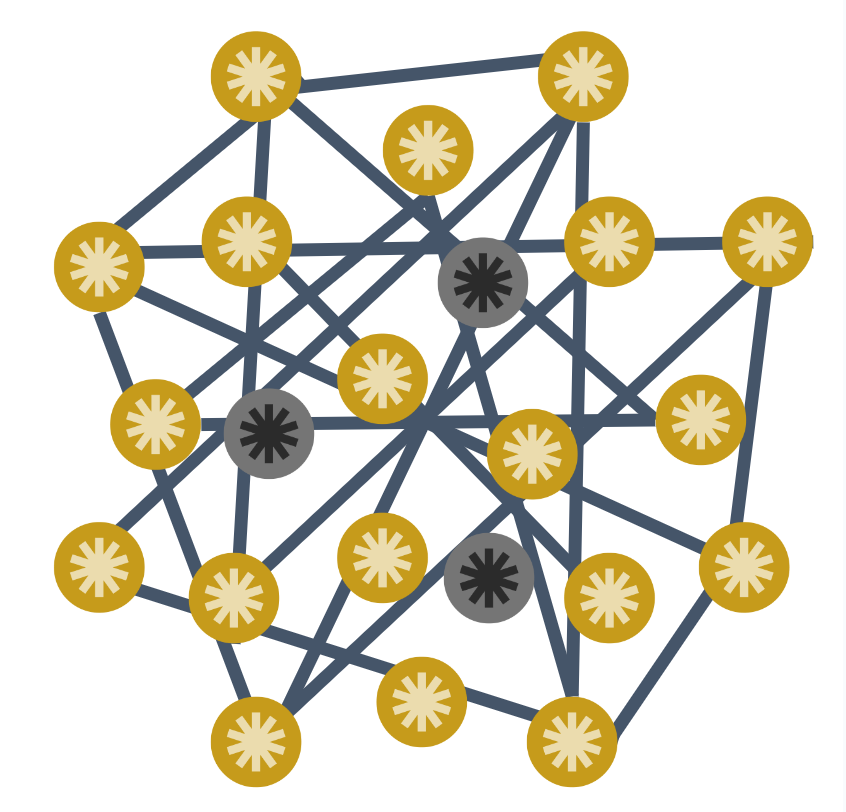

In a healthy village...
…All energy capacity and needs are understood by many if not all villagers. In times and places in which energy “technologies” amounted only to caloric human efforts, wood burning, and even onsite coal fired furnaces, this meant that villagers were sustainably managing their own usage as well as forest and other fuel source systems within a short travel distance so they never ran out of fuel. Tolerances of much broader temperature swings or extremes were also usually much higher. Architecture almost always accounted for solar angles, prevailing winds, obstructions of both, opportunities to utilize both in energy production / storage, like thermal mass adobe, cross ventilation, stack-effect “roof” openings, evaporative cooling from water bodies and plants, and more. All of these systems and techniques were both teaching tool and subject at once, so that physics, village management, and sacred elements were all learned about simultaneously.
In addition to restoring these “passive” techniques to contemporary construction and management of our habitats, there can be modern American expressions of these elegant and ubiquitously understood vernacular approaches to energy. In a modern American urban neighborhood going through self-directed re-villaging (instead of externally driven economic development, and the gentrification and displacement that almost always comes with it) would likely involve a Community Development Corporation or another candidate entity to serve as a genuinely well-intended positive change agency. This entity would first organize neighbors to be aware, informed, and capable to self-direction, if they are not already (many neighborhoods are, and many are not).
Next focus could shift beyond typical economics-only driven real estate developments that lay bare the landscapes of the neighborhood, vulnerable to vampiric developers who simply want to buy low, sell high, and never really be present in the Place. Instead the shift would be to initiatives like establishing a network of upgraded roofs covered in solar PV, as an extension of already common but underutilized weatherization programs. Furthermore, community held landtrusts or even POA’s (Property Ownership Associations) or a new entity type called an LSA (Land Stewardship Association) which honors the reality of land-personhood, as well as the need to interface with the current paradigm of land ownership. Regardless of entity type, these would establish the permanency and resident ownership and dividend access for managing “central plants” at the core of the block or in vacant rowhomes or lots,, to which upgraded solar roofs would all be tied. Ultimately these manage surpluses of energy across the block to expand to block-centralized heating and cooling, and other beneficial energy uses like pumping rainwater for collection, treatment, and distribution from roofs and even street surfaces for direct distribution of higher-than-utility quality water to homes and agriculture on all utilizable surfaces. This “nanogrid” (because even at block scale this is smaller than most microgrids) would eventually become part of a cellularly-networked mesh of nano-grids connected by physical cabling if power company franchise rights were frozen or redistributed to the CDC’s or RCO’s, or via EV battery exchange choreography (sounds crazy, but transitioning from entrenched, damaging, extractive, cynical systems can involve some pretty counter-intuitive solutions), especially when topography allows for heavy transport of batteries and water downhill, and lighter harvested crops back uphill.
This early establishment of stable, clean, cheap, community managed energy systems creates some resilience amongst existing residents, and establishes steady revenue for an entity, directed by the residents, which can then self-development and/or self-manage others utilizing many alternatives to the typical vampiric approaches to toxic, un-durable and unendurable, intrusive versions of bricks and mortar or bricks and sticks physical homes and other infrastructure developments discussed throughout the rest of this file.
Read more about energy works in most American cities here.
Core Concept:
How most American cities work: Energy


The reality is that energy in most American cities is centralized, loss-heavy, fragile, dirty, inequitable, unhealthy, and dangerous.
Hubs we call power-plants are a few vulnerable dots on the map, nodes in a system they would collapse by failing, struggling to keep the entire cardiovascular-like system of the energy grid glowing despite huge swings in production and demand, increasingly frequent natural disasters, terrorism, and tactical warfare. For the most part these strained juggernauts either belch out toxic emissions, and/or emissions that are already beginning to thermally skew the balances of our current atmosphere, biosphere, hydrosphere, pedosphere, etc., or they are producing types of waste that will remain a threat to Life longer than any of our current languages have been used on Earth - demanding the impossible task of creating signage to warn of the peril they present that will be definitely understandable hundreds of thousands or millions of years from now is next to impossible.
So the desperate, despotic, and/or vengeful have singular nodes in the form of mostly dirty and dangerous power-plants they can attack to threaten so many at once, and even the system as a whole. Not only are the regions each power plant serves huge, but the region supported by each juggernaut is limited in its ability to support any others, unless we're lucky enough for the disruptions in one to align with moderate or low stresses in nearly all the others.
Along with all these downsides, these juggernauts and the technology they are based upon enabled incredible progress, luxury, and wealth. And if that arc is to continue we must adapt the system, to allow the juggernauts to retire in honor, for the workers that support them to be honored and thanked, and supported in their transition to other roles. The surpluses of the new pattern can allow this to happen.
Read more about how energy COULD work in most American cities here.
Feature:
Hot water system
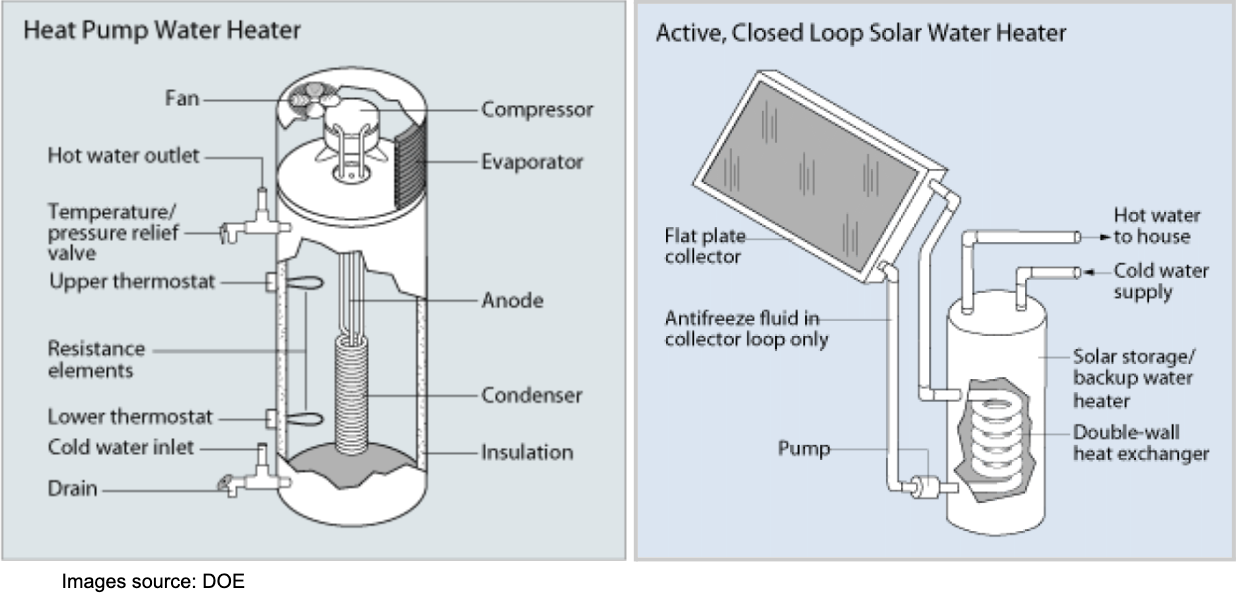

Recent innovations in hot water heaters have led not only to a more widely available energy efficient option than typical gas fired or even old electric water heater technology. But hot water heat pumps have also introduced a new source of cool air. As these units produce hot water buy pulling energy out of the air, they expel cooled air. In the winter this can be a bit of problem, because you’re effectively placing a small air conditioner, usually in your basement, during months you’re already spending too much energy on heating. We will exhaust this cooled air to the outside of the building in these months. But precooling the air in our mechanical room in the warmer months is a benefit.
Coupled with a few hot water solar panels on the roof, not only will we be able to produce all the hot water we need using very little energy, but we are also investigating a warmwater, subsurface irrigation system to supplement heating in the greenhouse and even extend growing seasons in outdoors raised beds. One of the many living-lab experiments we’ll be doing early on.
(Image source: DOE)
Feature:
Kitchen: Low Refrigeration and Dishwasher
.avif)
.avif)
Nothing super innovative here, honestly. Tried and true, energy star certified under-counter freezer (left) and refrigerator (right) and dishwasher (further right, beside sink because it uses water) with a wheelchair pull-in between/beside all of them. The prep space between the two refrigeration units is set at desk height, though may be adjustable. We're leaving the space above the counter on top of the refrigerator open in case an additional refrigerator is desired, or for coffee/espresso machines, toasters, air fryer, or other small appliances.
Links to:
Feature:
Bathroom: The best shower in the tri-state area


"Recirculating shower saves 90% of energy and 85% of water compared to code. High-flow shower head for convenience and quality of life.
Many do not fully appreciate some of the luxuries and coping mechanisms we have in our society, nor realize that many don’t have safe or frequent access to them. For example, showers. In Ron’s current subsistence level living situation, it is unsafe for him to take a shower as well as it is unsafe for his caregivers to assist him during a shower. Because of that, he relies mostly on sponge bathing, as do millions of other people with limited mobility. The shower installed at Ramboland will allow Ron (and ultimately other users) to have access to a full soaker tub with a door that allows a suspension system to carry him safely and conveniently in and out of it. The tub is positioned in such a way that caregivers can reach in from 3 of the 4 sides, a rare convenience. The bathroom will also feature a high-flow shower head next to the bathtub that he can enter independently in a wheelchair or with support of the suspension system and enjoy a better shower experience.
How does this comply with our other environmental goals? Well, the showering system we are installing is called a recirculating shower. Despite its high-flow rainforest shower head, it saves almost 90% of both water and energy compared to a code compliant 2.5 gallon per minute showerhead. This is because unlike standard showers that lose all the water and heat after it passes over our bodies and down the drain only once, water in this system will recirculate about 7 times before being drained. This is possible because the shower has built-in treatment, filtration, and temperature regulators, which also ensure cleaner water than typical tap water and allow for a perfectly controlled water temperature, making them safer in terms of burns and cold shocks – a greater risk with users that have speech challenges.
Links to:
Feature:
Universal Design: Suspension System


For much of the design process we have planned to provide an overhead track system to support a hanging mechanism that allows Ron, visitors, and/or future residents to be comfortably suspended, and moved easily around the house to key fixtures, appliances, furniture, etc., by a caregiver or their own control interface. Accommodating this structurally and architecturally was challenging and increasing complicatedness and cost. Getting it through doors, and to all those locations was particularly challenging. We recently expanded the track idea to go throughout the entire house however, rationalizing that the track itself was not the costly part, and it even being a somewhat fun ""ride"" for some fit well with the theme park implications of the project name. And yet it was still not universal in the access it granted and getting more over-the-top than might be reasonable even for this swing-for-the-fences project. And then it occurred to us that maybe we could hang the components that actually suspend our bodies from a floor-based mobile unit, something like an engine block lift. We thought this was very clever. In what couldn't even be considered an ""ah ha"" moment, but more like a ""yeah duh"" moment, we realized these make those already. Of course they do. They can fit through doors, turn and move along on casters, change height and orientation for different fixtures, furnishings, and appliances, and more. They can be operated by motor, or caregiver elbow grease.
That said, if we're not able to get the one we want, we may still modify an engine block lift! Which might actually be cooler and cheaper, and perhaps our partners who work and learn in fabrication and robotics labs might help us make that!
Feature:
Laundry - Washer/Dyer


The washer/dryer unit is placed in the mechanical room for convenience, and shortens pipe length from treatment systems to all fixtures and appliances using treated rain for washing and irrigation. This will also slightly post/pre-heat return air before it is exhausted through an energy recovery ventilator (ERV) or cycled back into the house. This is also creating a warmer pocket of air on the northern wall, and is what's called "waste heat capture," which is good because Lancaster will remain a "heating load dominant" climate for at least the next couple of decades.
Feature:
Super-High Efficiency Heating/Cooling System
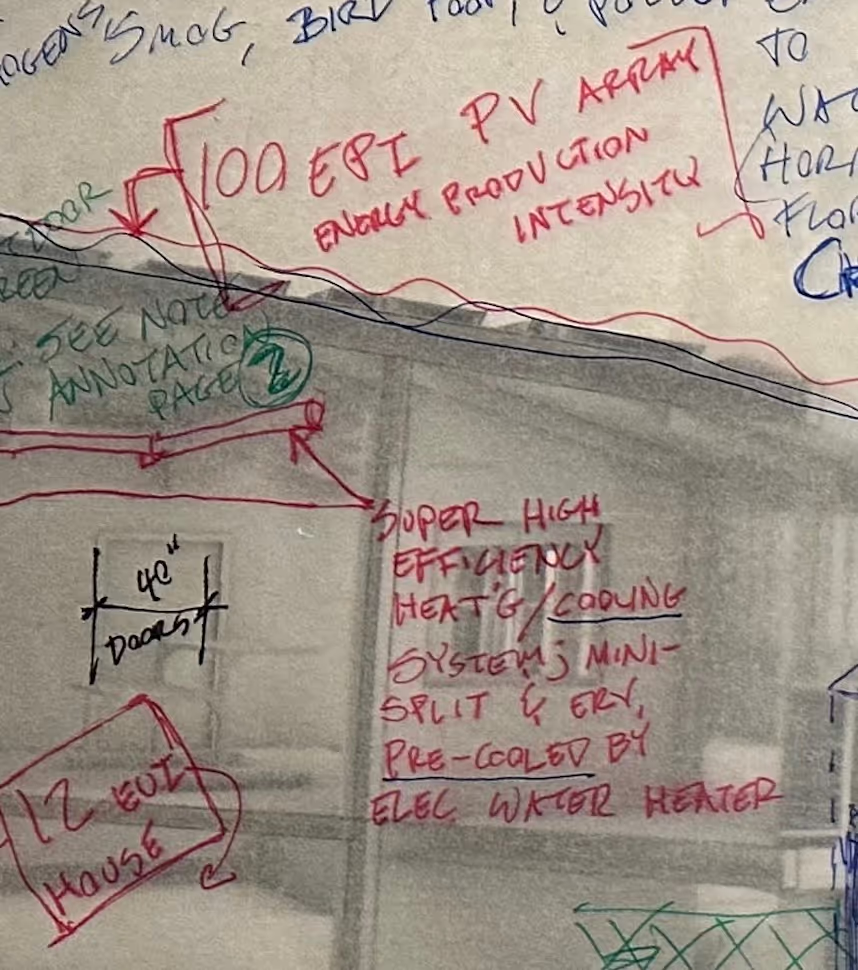

Having already designed a building envelope that allows wind and sun to do more of the cooling and heating when its needed most, and as little as possible when its not wanted, the remaining heating and cooling loads are quite small. This “downsizing” or “right-sizing” (link to definition) allows significant cost savings, and depending on how a project decides to think about it, it could be considered to create an allowance that can be spent to get more expensive technologies - which could still cost less than typical because they’re so much smaller.
Core Concept:
How most American cities COULD work: Food
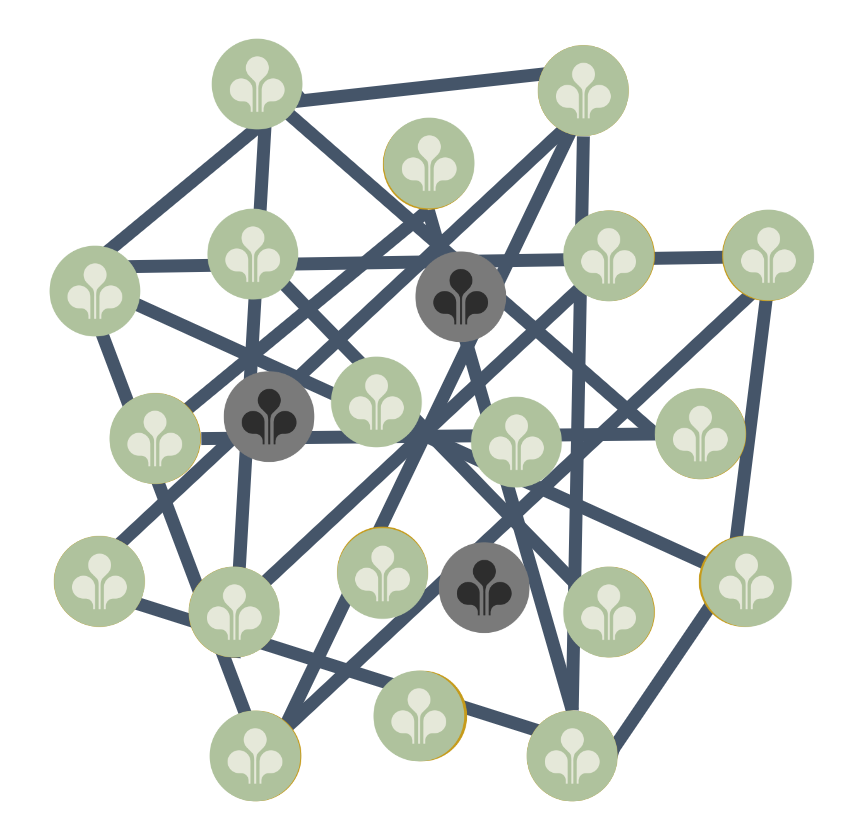

In a healthy village… there tends to be nested patterns of self-sufficiency and exchange with the larger nested collectives. I.E. individual “household” or nuclear families produce much of what they like and need most in their own share of the area. They usually produce a surplus of this, and then trade with neighbors and/or extended family. The core of their diet usually comes from community efforts in which shared food forests and/or fields, and or hunting provides a lot of the base. In some cultures almost all of the production, including the vast variety of flavoring, nutrition, etc. comes from community food systems, in which many or even a majority of the community participates in “cultivating.” These food systems are not exceptions to otherwise “natural” ecology, but a deeply interwoven and interdependent part of it. The ecology of the place is healthier, not hampered, thanks to the humans tending to their own needs for nutrition, medicine, and the pleasures of cuisine, and in full awareness of the balances and dynamics in that ecosystem.
Jumping scale, because every square yard of land is as different from the next as it is one across the continent (Gerald Wilhelm), villages also often have specializations in certain medicines, foods, and cuisines, which creates unique value for their trading with other villages, just as the families do within the village. One can see how the massive scale overspecialization of modern agribusiness is a form of this pattern run amuck, and reaching a scale that this pattern is not appropriate to.
Read more about how food works in most American cities here.
Core Concept:
How most American cities work: Food


Altogether now: centralized, loss-heavy, fragile, dirty, inequitable, unhealthy, dangerous...
Most of the food we eat, for those of us that have access to enough, is coming from far away; from mono-cropped land (land on which only one crop is grown, that is deader than deserts in many ways); bathed in petrochemicals to make up for the un-systemic, extractive methods of cultivation and the problems with pests and lack of nutrients it creates; tended by either massive machines or underpaid, desperate workers destroying their bodies by being hunched over all day, often just to send a few dollars back to poorer family in other countries; and about 40% of it is wasted either on the vine, or on the shelves, or somewhere in between; meanwhile huge populations go without sufficient access to healthy food, and we have simultaneous pandemics of obesity and hunger. Several of the species of plants being grown have been whittled down from numerous sub-species to only one or two, incredibly vulnerable to a single blight, and so heavily subsidized and relied upon that it could collapse our whole food system. And the animals involved are mostly treated like machines or plants, and live miserable, tortuously painful and short lives that resemble several levels of Dante's Hell, and are themselves extremely vulnerable to viruses and other infections and disease, and for that reason and to maximize their productivity are pumped full of hormones and antibiotics, many of which make their way into our food and the water bodies via their excretions being washed by rainwater runoff into the water bodies from which we draw our drinking water.
It is centralized, loss-heavy, fragile, dirty, inequitable, inhumane, brutal, and maybe if that were all in the name of the economic thriving of the people that rely on it throughout that overall chain there would be some kind of argument for protecting our agriculture's current form from reform. But it is squeezing family and small businesses, and primarily benefiting already wealthy subsets of our population, and perhaps also some of the retirement plans of our hard working citizens through pension funds on the stock market being tied up in the transnational corporations running most of it. But who would want their money in such a fragile and grim investment?
And what if it were all unnecessary, and a faster-than-we-think transition that left no one behind were possible? And what if that created far more overall wealth, security, and health for all species. We're not alone in not only believing in this, but testing it and proving it.
Read more about how food COULD work in most American cities here.
Feature:
Kitchen: Height Adjustable Sink
.avif)
.avif)
The height adjustable sink, which uses flex hose to allow fixture movement, provides a wheelchair pull-in space beside the adjacent appliances regardless of which height those are set at, and of course access to the sink itself.
The sink will also have an additional metered faucet control. Metered faucets are those activated usually by pushing down a knob and which then run for a specific amount of time. The button or knob slowly pops up stopping water flow when it has returned to its deactivated original position. This metered control will not control a faucet that pours into this sink however. This is a manual backup for the
irrigation system for the indoor green roof just beyond the top of the kitchen wall, which caps the mechanical room behind it. The primary faucet will be a sensor activated basic kitchen faucet. We will likely also provide a typical sprayer that can also be held and activated by a button on the sprayer head.
Links to:
Feature:
Bathroom: Accessible Bath Tub
.jpeg)
.jpeg)
The bathtub itself is a wheelchair-transfer walk-iIn tub with a fast fill Faucet, and massage jets. The orthopedic and quality of life benefits of this are clear. And like the pot-filler* in the kitchen space, flow-rate is irrelevant, in terms of water usage, because you'll put the same amount of water into the tub regardless of how fast it gets there. Getting it there faster will also save a small amount of energy because less heat will be lost before use.
The bathtub is set up like a peninsula extending into the bathroom instead of with its long side against a wall, as would be the typical way to place it. This is so that care-givers can access the tub from any of 3 sides, including the one where the sink is. The opposite side is the one with the door for transfer. Not only will this be much easier to get in and out for someone reliant on a wheelchair, but it will also enable a very easy transfer using the suspension system dolly**. There is also a floor drain on that side as well tied to the recirculating shower***.
Enabling this level of self care and care-giver ease is very rare, and therefore worth the additional financial cost. Most of us that are more mobile-able take for granted the luxury of being able to shower or take a bath, not only for convenience but the significant mental health benefits.
The fact that the water in this house will be unparalleled in terms of its purity also means that the steam generated in the bathroom will have far fewer contaminants, keeping the indoor air at a higher quality.
This approach is not only much safer – it’s also something that has long been out of reach for many people with mobility challenges. Bathing and showering can be too risky for them and their caregivers, largely because they only have consistent access to non-accessible bathrooms like the one shown in this image of Ron’s current setup. These are the types of facilities typically found in apartments that people with mobility impairments can afford when relying on state subsistence benefits. While programs do exist to support modifications even in rental units, landlords are often unwilling to allow them, or the small square footage and other architectural limitations make renovations cost-prohibitive.
Links to:
Feature:
Laundry - Washer/Dyer


The washer/dryer unit is placed in the mechanical room for convenience, and shortens pipe length from treatment systems to all fixtures and appliances using treated rain for washing and irrigation. This will also slightly post/pre-heat return air before it is exhausted through an energy recovery ventilator (ERV) or cycled back into the house. This is also creating a warmer pocket of air on the northern wall, and is what's called "waste heat capture," which is good because Lancaster will remain a "heating load dominant" climate for at least the next couple of decades.
Feature:
Bathroom: Cool Toilet
.avif)
.avif)
And then of course there is the elephant in the bathroom – the toilet. Although we will not be going with a $6,000 Japanese toilet, but are providing one with excellent geometry for caregiver and user ease, as well as either a built-in or bolt-on bidet and tushy dryer, which are becoming readily and affordably available in the market, and a great help to everyone involved.
In addition to all of those benefits, the plumbing system is set up so that the toiler flushes greywater (insert definition link), which essentially eliminates the negative impacts of water demand for toilet flushing.
A custom designed pedal mechanism as a second option for flushing (which will simply pull down on the dual-flush flush-valve handle) improves hygiene when usable, by allowing hand contact with the fixture to be avoided. In some cases it will also improve accessibility when 1. a user has the ability to step on it but not otherwise operate a flush mechanism higher up, or 2. a user of a wheelchair can maneuver it to run over the pedal.
Links to:
Feature:
Bathroom: The best shower in the tri-state area


"Recirculating shower saves 90% of energy and 85% of water compared to code. High-flow shower head for convenience and quality of life.
Many do not fully appreciate some of the luxuries and coping mechanisms we have in our society, nor realize that many don’t have safe or frequent access to them. For example, showers. In Ron’s current subsistence level living situation, it is unsafe for him to take a shower as well as it is unsafe for his caregivers to assist him during a shower. Because of that, he relies mostly on sponge bathing, as do millions of other people with limited mobility. The shower installed at Ramboland will allow Ron (and ultimately other users) to have access to a full soaker tub with a door that allows a suspension system to carry him safely and conveniently in and out of it. The tub is positioned in such a way that caregivers can reach in from 3 of the 4 sides, a rare convenience. The bathroom will also feature a high-flow shower head next to the bathtub that he can enter independently in a wheelchair or with support of the suspension system and enjoy a better shower experience.
How does this comply with our other environmental goals? Well, the showering system we are installing is called a recirculating shower. Despite its high-flow rainforest shower head, it saves almost 90% of both water and energy compared to a code compliant 2.5 gallon per minute showerhead. This is because unlike standard showers that lose all the water and heat after it passes over our bodies and down the drain only once, water in this system will recirculate about 7 times before being drained. This is possible because the shower has built-in treatment, filtration, and temperature regulators, which also ensure cleaner water than typical tap water and allow for a perfectly controlled water temperature, making them safer in terms of burns and cold shocks – a greater risk with users that have speech challenges.
Links to:
Core Concept:
How most American cities COULD work: Water
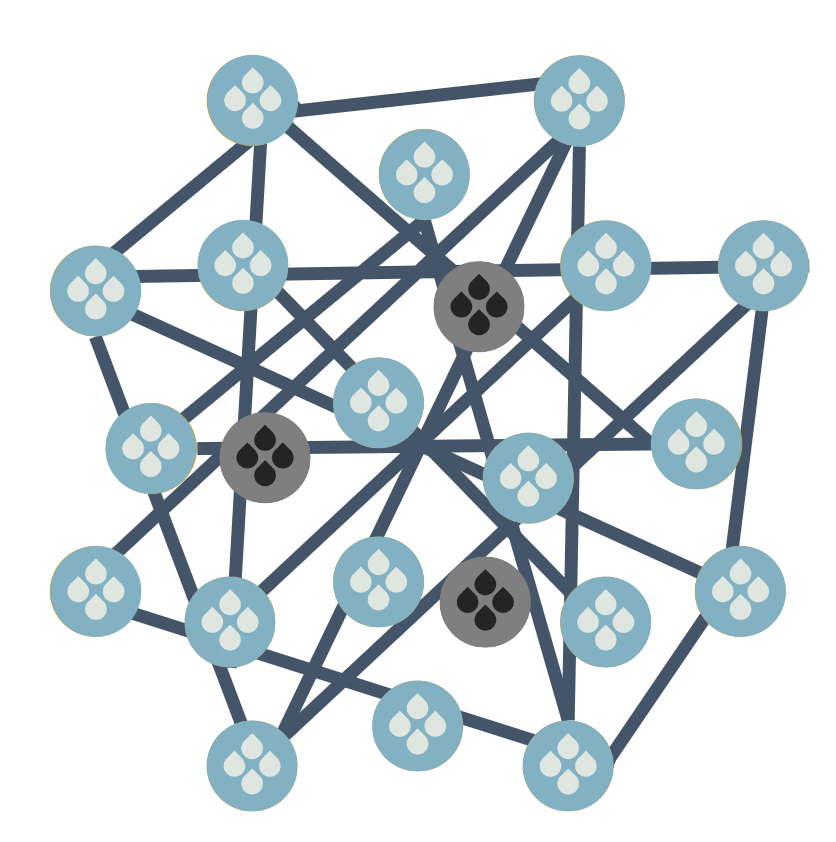

In a healthy village...
…resources are not taken for granted. Let alone contaminated and cast aside. The combination of having plenty of energy (whatever forms that takes, elbow grease, flowing water, solar radiation, the heat of the Earth herself) and the awareness of the water demands of the maximized healthy abundance in the hyper-local biome, makes the water falling out of the sky an obvious connector. Not only that, the familiarity with how that ecosystem relates to the hydrology, above and below, clues the citizens into the idea that rain does not skip right to the surface water bodies. The living beings take up huge amounts of it, use it for biological processes, often several, before releasing mostly vertically, through infiltration and evaporation/evapotranspiration. What if our built infrastructures did this as well? When significant storage capacity is introduced, not only is there enough water for all the biological processes in many parts of our country, there are also ways to release the water when it is in excess of needs, and without damaging systems and their members downstream.
When goals like "capture all rain, and use it multiple times on site" and "only release water vertically unless its in living being's body (mostly animals and plants that have consumed it)" become guiding principles, well-intended (pun) green building principles, like reducing water use, fall away because those are based on an intention of minutely reducing the contribution to the harm of the centralized municipal water systems. In the approaches explored here there are moments in the year that more water must be used to keep the hydrologic processes in balance.
Read more about how water works in most American cities here.
Core Concept:
How most American cities work: Water
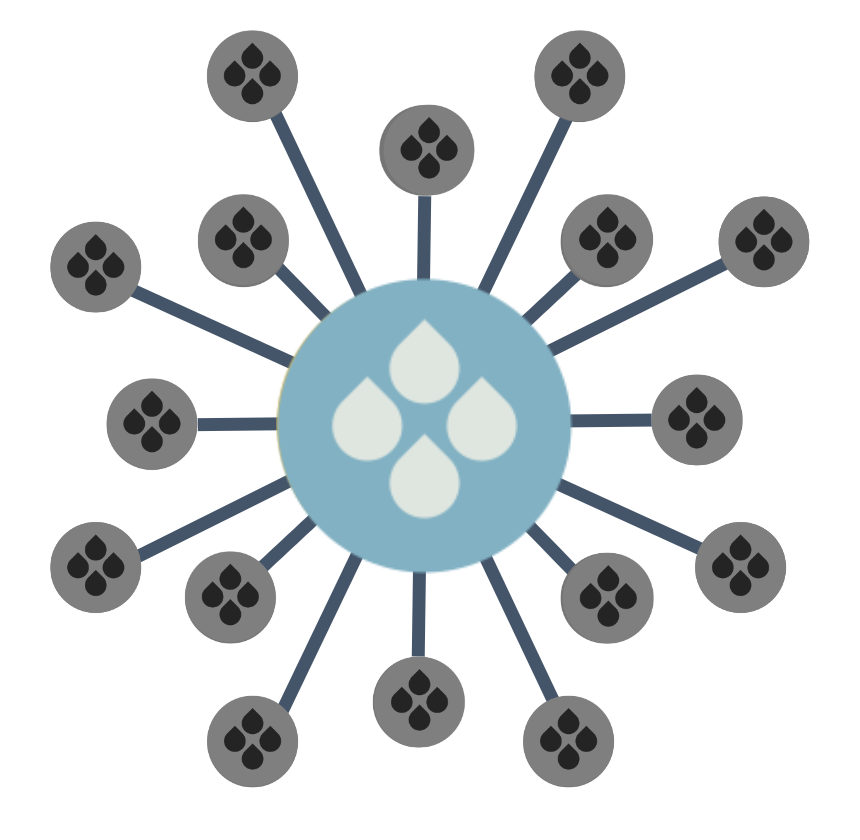

Yep, also centralized, loss-heavy, fragile, dirty, inequitable, unhealthy, dangerous...
Our power-plants and factories dump heat and toxins into water bodies, joined by hormones and pharmaceuticals from run-off from our farmland, and drawn into our water treatment plants which cannot remove all of these health threats. Our cities assure our citizens "the levels of hexavalent chromium (and a bunch of other stuff) are below EPA limits," but the recommended dosage if your doctor hasn't coincidentally prescribed the some of the same pharmaceuticals, is zero. And the test results are mostly from the treatment plants, while many old buildings and infrastructure, predominantly in poor neighborhoods, schools, and homes, contain additional contaminants like lead (because they haven't been updated in decades), so our most vulnerable and underserved are once again getting the worst version of the most basic resources.
Not to mention that the incredible amounts of energy that create a level of pressure in the water system needed to drive flow to all our fixtures, is also both responsible and challenged by the MASSIVE losses to leakage throughout the distribution system. Other than the impacts of the energy use and the production it demands, this might be one of the greatest virtues of this system, because it helps to recharge the aquifers that would otherwise be nearly completely cut off from incoming water due to the excessive amount of impervious surfaces in our cities - we have nearly fully cap the land with hardscape.
We then contaminate all of the water we use, and send it back into the water bodies from whence it came, often without further treatment when rain overwhelms our combined sewer and stormwater systems and causes outflows into these natural water bodies. Then a town downstream pulls it back in to do it again. From a certain perspective, an alien one for example, it might almost seem like the purpose of the system was to contaminate the natural water bodies, and hurt the living beings throughout the system.
This was not done intentionally, and it is largely a function of unforeseen developments in our societies' growth in both size and industrialization. Like our power plants these systems enabled great progress, but that is no reason to ignore their shortcomings and entrench in their current layout, structures, and technologies. If previous generations had thought that way we wouldn’t have had the progress we have. So the lack of progress and the current harm occurring is also now a function of its human operators and corporate and political stewards opposing bigger systemic shifts. We’re being told we must be relegated to coping with these issues with incremental band-aid solutions, one problem at a time, usually addressed by a single technology or technique (often yet another chemical, or energy intensifying form of filtration or treatment).
All the while much cleaner water, at least in some respects, is falling on us from the sky fairly regularly in many parts of the country. We increasingly have more water than we can handle falling out of the sky several times of year, and not enough in others... if only there were a way to take the excess water from the deluges and save it for the droughts! There is, storage. This water has smog, bird poop, pollen, dust, etc. in it, all of which should be removed for human consumption, and only some of which should be removed for irrigation. Removing all of that is much easier than a lot of what is in our municipally supplied water. Whether you treat rain like the sacred, valuable resource it is, or like its a nuisance, it will be a self-fulfilling prophecy. Stormwater is essentially a curse-word for rain or run-off that would not happen if we hadn't paved over almost everything.
The irony of this ignored resource literally hitting us in the face while we complain about it, and take it instead from what is probably the worst stage in the same hydrologic cycle to do so (rivers) is something that can't be unseen once realized.
And again, when you sit down to pencil the math on whether blocks or districts could meet their own water needs, especially if storage and natural treatment approaches were occurring within the core of blocks, in many regions of the U.S. and world, the numbers more than work. If that is tied into food systems and nano-/micro-grids producing a surplus of energy, it starts to become clear that our failure to design a compassionate and effective transition from our disastrous current approaches is the primary problem.
Read more about how water COULD work in most American cities here.
Feature:
Kitchen: Low Refrigeration and Dishwasher
.avif)
.avif)
Nothing super innovative here, honestly. Tried and true, energy star certified under-counter freezer (left) and refrigerator (right) and dishwasher (further right, beside sink because it uses water) with a wheelchair pull-in between/beside all of them. The prep space between the two refrigeration units is set at desk height, though may be adjustable. We're leaving the space above the counter on top of the refrigerator open in case an additional refrigerator is desired, or for coffee/espresso machines, toasters, air fryer, or other small appliances.
Links to:
Feature:
Bedroom: Convenience Vanity/Sink and Indoor Green Roof
.jpeg)
.jpeg)
There is a convenience lavatory/sink in the bedroom as well – this is just that, convenience. Especially for care-givers convenience in having rapid access to a sink and faucet in the bedroom for drinking or cleanup needs. Like the kitchen sink and faucet, an additional control is included here to manage the low amounts of irrigation the indoor green roofs in both spaces will require – which will also assist in dust control on those horizontal out of reach areas, and the green roofs will help to moderate air contaminants, oxygen levels, and humidity levels, not to mention provide a biophilic psychological benefit.
Links to:
Feature:
Hot water system


Recent innovations in hot water heaters have led not only to a more widely available energy efficient option than typical gas fired or even old electric water heater technology. But hot water heat pumps have also introduced a new source of cool air. As these units produce hot water buy pulling energy out of the air, they expel cooled air. In the winter this can be a bit of problem, because you’re effectively placing a small air conditioner, usually in your basement, during months you’re already spending too much energy on heating. We will exhaust this cooled air to the outside of the building in these months. But precooling the air in our mechanical room in the warmer months is a benefit.
Coupled with a few hot water solar panels on the roof, not only will we be able to produce all the hot water we need using very little energy, but we are also investigating a warmwater, subsurface irrigation system to supplement heating in the greenhouse and even extend growing seasons in outdoors raised beds. One of the many living-lab experiments we’ll be doing early on.
(Image source: DOE)
Feature:
Cross-Ventilation & the Venturi Effect
.avif)
.avif)
The house is oriented to optimize sun angles, penetrating or not, depending on time of year and day*. But the house is also designed to account for prevailing winds.
"Prevailing winds" is a term for the direction wind tends to come from, and in this climate they have tended to come from the Northwest in the Winter (when we don't generally want to be hit by cold air), and the Southwest in the Summer (when we often can benefit from some cross-ventilation and cooling).
So the house is designed with blocking the (north)westerly cold winter prevailing winds in mind, with additional layers of vegetation, insulation, walls, trees, and pockets of air**.
Likewise, the house is designed to scoop up the southwesterly winds in warmer months, so when the temperature is within certain ranges the windows can be opened, and the movement of the air can create whats called "expanded thermal comfort." This is a term for the effect of more air molecules hitting your skin and absorbing some heat from it thanks to the air moving. This increases the rate the body can release heat energy, and thus requires the air to be less cool than when it's not moving as much. Ceiling fans also offer this benefit but use up some electricity to do so (though less than air conditioning).
When early on in our design process the addition of a greenhouse was being considered, we were concerned this might jeopardize our cross ventilation because the greenhouse would block some of that southwesterly winds in some of the warmer months of the year. So we did a type of analysis called Computational Fluid Dynamics (CFD). This technology has been used for a longer period in automobile and aeronautical engineering and design so that cars and planes could be made more aerodynamic. The old fashioned way to do it is to place a model of the geometry of the object being designed in a wind tunnel (literally a room with fans at both ends to create high air speed in one direction), and then smoke being blown blowing in the fan so that the airflow is visible to the observers. CFD software allows us to assess our design in a virtual model without building a physical one yet.
Somewhat to our surprise, the introduction of the greenhouse created whats called a Venturi Effect. This is the phenomenon in which sending a fluid (usually air) through a compressed space causes it to speed up, like a nozzle on a hose, or the tapered or fluted cooling towers and smoke stacks on factories and combustion-based power plants. The breezeway between the house and the greenhouse is angled enough towards the prevailing southwesterly winds, that it captures enough wind and compresses, that that wind is actually accelerated into the house a little bit more than if the greenhouse weren't there.
Using CFD created a lot more confidence that we could not only add the additional complexity of a diverse and high tech food system to the project without sacrificing other performance goals, but in fact enhanced our achievement of those goals. The house will actually be able to use active, electricity consuming air conditioning a little bit less, because our breezeway pushes the air a little bit faster into the south-facing windows in house. As the air inside heats up a bit from contact with warm human bodies and other heat sources inside the house, this will actually help it rise a bit and then more effectively be sucked out of the high-up windows on the north wall of the house. The CFD allowed us to do a lot better than the typical ""wishful thinking arrows"" designers so often use to represent how they hope the air will flow!
Feature:
Laundry - Washer/Dyer


The washer/dryer unit is placed in the mechanical room for convenience, and shortens pipe length from treatment systems to all fixtures and appliances using treated rain for washing and irrigation. This will also slightly post/pre-heat return air before it is exhausted through an energy recovery ventilator (ERV) or cycled back into the house. This is also creating a warmer pocket of air on the northern wall, and is what's called "waste heat capture," which is good because Lancaster will remain a "heating load dominant" climate for at least the next couple of decades.
Feature:
Super-High Efficiency Heating/Cooling System


Having already designed a building envelope that allows wind and sun to do more of the cooling and heating when its needed most, and as little as possible when its not wanted, the remaining heating and cooling loads are quite small. This “downsizing” or “right-sizing” (link to definition) allows significant cost savings, and depending on how a project decides to think about it, it could be considered to create an allowance that can be spent to get more expensive technologies - which could still cost less than typical because they’re so much smaller.
Feature:
Air Quality / Chemistry Monitoring and Treatment


Air quality in western modernity has been a bit of a rollercoaster. Before the industrial revolution humanity had seldom (though certainly not never) produced a concentrated pollutant source consistently enough to create lasting outdoor or even indoor air quality threats or problems. Cities became incredibly polluted in the early and mid stages of industrialization, so much so that those that could live outside of them did so. Regulation and other factors that moved industry out of urban centers from urban poor, to rural poor areas, essentially diluted the contamination enough that it became somewhat less severe issues for broader areas. The Clean Air Act and its sibling Clean Water Act substantially reduced the negative impacts of industry, which had been radically disproportionately impacting poor and non-human living beings. Regulation and enforcement have continued to struggle to keep up with the propagation of new sorts of industries and their new contaminates, and other factors like corporate lobbying and politicians susceptible to it have hindered their effectiveness. But generally the arc of outdoor air quality over nearly the last century and half has been mostly a trend in the healthier direction, with ozone loss for a time, and throughout the century greenhouse gas emissions as indirect health impacts of air contamination steadily rising.
In the mid to late stages of industrialization our industries were producing new chemicals for household and other products at a rate well beyond what testing, medical and health analysis could keep pace with. Fashion trends in architecture and interior design at times exacerbated this, while health and green building rating systems at least pointed the way to often cost-effective avoidance of indoor health threats from products and materials, albeit without really moving the bell-curve of building industry practice all that much. It would be fair to say that have substantially impacted product and material manufacturing, leveraging the PR and marketing motives of building product manufacturers, though greenwashing still runs rampant. Much of these
efforts fall short of proper prioritization and accurate technical considerations however, and the air chemistry being brought to bear on Ramboland is rarified air, both literally and figuratively (sorry, couldn't resist).
By 1. maintaining a simple material palette, 2. maximizing material reuse, 3. being highly critical of chemical content in all products and materials selected, 4. resorting to new materials only when necessary and via local and scientifically validated and/or certified content, as well as 5. introducing filtration and other treatment within rooms and sometimes within HVAC systems (whichever is more effective in terms of air quality, and often also hard costs, and addressing other air quality issues like temperature and humidity as well) Ramboland will have amongst the most pristine air of any building. This 'optimization sequence' ensures maximum performance and minimal cost. Ongoing air quality testing will add insight and prompt responses to air quality impacts materials and products introduced by occupants (clothes, accessories, food, and other belongings) as well as activities like cooking, bathing, cleaning, and respirating, further strides will be made in controlling for and maintaining super healthy air quality beyond design and construction stages, in a way that can be accessed by education systems and the public at large.
Core Concept:
How most American cities COULD work: Food


In a healthy village… there tends to be nested patterns of self-sufficiency and exchange with the larger nested collectives. I.E. individual “household” or nuclear families produce much of what they like and need most in their own share of the area. They usually produce a surplus of this, and then trade with neighbors and/or extended family. The core of their diet usually comes from community efforts in which shared food forests and/or fields, and or hunting provides a lot of the base. In some cultures almost all of the production, including the vast variety of flavoring, nutrition, etc. comes from community food systems, in which many or even a majority of the community participates in “cultivating.” These food systems are not exceptions to otherwise “natural” ecology, but a deeply interwoven and interdependent part of it. The ecology of the place is healthier, not hampered, thanks to the humans tending to their own needs for nutrition, medicine, and the pleasures of cuisine, and in full awareness of the balances and dynamics in that ecosystem.
Jumping scale, because every square yard of land is as different from the next as it is one across the continent (Gerald Wilhelm), villages also often have specializations in certain medicines, foods, and cuisines, which creates unique value for their trading with other villages, just as the families do within the village. One can see how the massive scale overspecialization of modern agribusiness is a form of this pattern run amuck, and reaching a scale that this pattern is not appropriate to.
Read more about how food works in most American cities here.
Core Concept:
How most American cities work: Food


Altogether now: centralized, loss-heavy, fragile, dirty, inequitable, unhealthy, dangerous...
Most of the food we eat, for those of us that have access to enough, is coming from far away; from mono-cropped land (land on which only one crop is grown, that is deader than deserts in many ways); bathed in petrochemicals to make up for the un-systemic, extractive methods of cultivation and the problems with pests and lack of nutrients it creates; tended by either massive machines or underpaid, desperate workers destroying their bodies by being hunched over all day, often just to send a few dollars back to poorer family in other countries; and about 40% of it is wasted either on the vine, or on the shelves, or somewhere in between; meanwhile huge populations go without sufficient access to healthy food, and we have simultaneous pandemics of obesity and hunger. Several of the species of plants being grown have been whittled down from numerous sub-species to only one or two, incredibly vulnerable to a single blight, and so heavily subsidized and relied upon that it could collapse our whole food system. And the animals involved are mostly treated like machines or plants, and live miserable, tortuously painful and short lives that resemble several levels of Dante's Hell, and are themselves extremely vulnerable to viruses and other infections and disease, and for that reason and to maximize their productivity are pumped full of hormones and antibiotics, many of which make their way into our food and the water bodies via their excretions being washed by rainwater runoff into the water bodies from which we draw our drinking water.
It is centralized, loss-heavy, fragile, dirty, inequitable, inhumane, brutal, and maybe if that were all in the name of the economic thriving of the people that rely on it throughout that overall chain there would be some kind of argument for protecting our agriculture's current form from reform. But it is squeezing family and small businesses, and primarily benefiting already wealthy subsets of our population, and perhaps also some of the retirement plans of our hard working citizens through pension funds on the stock market being tied up in the transnational corporations running most of it. But who would want their money in such a fragile and grim investment?
And what if it were all unnecessary, and a faster-than-we-think transition that left no one behind were possible? And what if that created far more overall wealth, security, and health for all species. We're not alone in not only believing in this, but testing it and proving it.
Read more about how food COULD work in most American cities here.
Feature:
Kitchen: Pull-down Upper Cabinets
.avif)
.avif)
Storage can be a serious challenge in spaces with high levels of mobility accessibility. Limitations on what can be reached by various folks is not only limited, but often mutually exclusive. I.e. some folks can't reach things down low easily, others can't reach things up high, both for various reasons. Universal Design is an aspiration, a north star that perhaps can never truly be reached, but it can get us a lot of progress in checking ourselves against it, and repeatedly asking ""how can we make this better for more people?""
The kitchen at Ramboland is packed with examples of this, one of our favorites being the pull-down cabinets. There are several versions of this on the market; some allow you to pull the ""guts"" of the cabinet straight down out of the bottom of the cabinet carcass (that's what they call the outer enclosure of cabinets), so that the bottommost shelf in an upper cabinet can be the whole down at counter height, or perhaps even lower if the counter itself can also drop. Others allow those guts to both come down and forward. Still others bring the entire carcass and its guts the whole way down and to the front edge of the counter.
Links to:
Feature:
Kitchen: Low Refrigeration and Dishwasher
.avif)
.avif)
Nothing super innovative here, honestly. Tried and true, energy star certified under-counter freezer (left) and refrigerator (right) and dishwasher (further right, beside sink because it uses water) with a wheelchair pull-in between/beside all of them. The prep space between the two refrigeration units is set at desk height, though may be adjustable. We're leaving the space above the counter on top of the refrigerator open in case an additional refrigerator is desired, or for coffee/espresso machines, toasters, air fryer, or other small appliances.
Links to:
Feature:
Kitchen: Height Adjustable Double Appliance
.avif)
.avif)
As with our split cooktop our design team, including our accessible equipment advisor, have come up with an approach to some of the appliances, which we think will increase accessibility for more folks. By placing two half-height appliances together –one above and one below a height adjustable counter section –, the full size microwave, and an oven can both become highly accessible while using up minimal space.
When the counter is raised a person using a wheelchair could also pull in under the oven, and likely reach both appliances, with really easy access to the oven. When the pair are lowered the whole way to a point at which the oven is on the floor, the microwave could be all the way down to under counter height, and easily accessed from the front, or by someone in a wheelchair who has pulled in beside it under the sink.
Links to:
Feature:
How most American cities work: Mobility
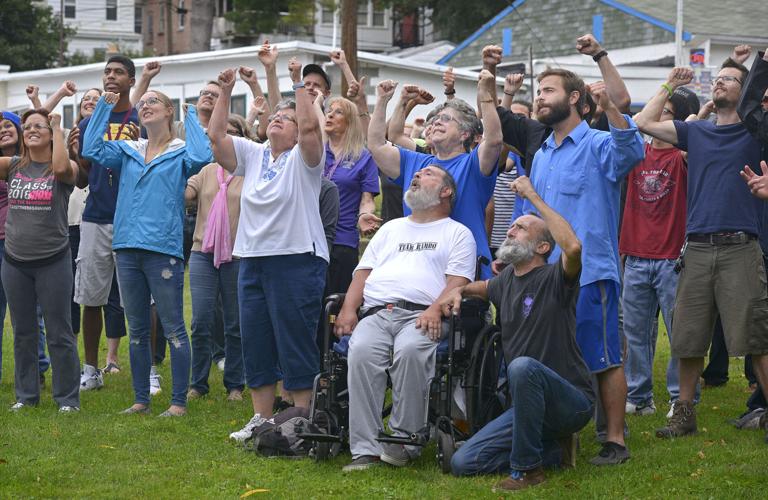

Ron Rambo may be responsible for more curb cuts%2C,surface%20of%20an%20adjoining%20street.) and ramps getting added in the City of Lancaster than any other human. As a necessary user himself, Ron has not stopped at attempting to improve his own access, but has been an activist and advocate on behalf of all folks with differing mobilities. That said, most American cities, because ADA is structured in such a way that grandfathers many business, city systems, and buildings into pre-ADA requirements and features, it is still very hard to get around even public areas for many citizens. We have found that many folks, even social and environmental activists, are unaware of this, thinking “that’s no longer an issue, ADA fixed that a long time ago.” In fact, as important as ADA was, it took some of the wind out of the larger movement advocating for progress in these areas, and we must continue to innovate, expanding access in not only economically and environmentally sustainable ways, but in ways that allow more of us to thrive together, in all ways, including economically. Ramboland is proving this is possible, in part by changing the scale and expanding the types of systems we combine. The synergies among energy, water, food, conveyance and mobility, and policy and financial systems are huge, but only if we can look at things differently than we’re accustomed to. Ramboland will cost less to build than Ron will need in subsistence benefits from the state, and it will self-sustain and self-expand financially. What if this was the default for how we address these things all at once.
Core Concept:
How most American cities COULD work: Neighborhood Economics
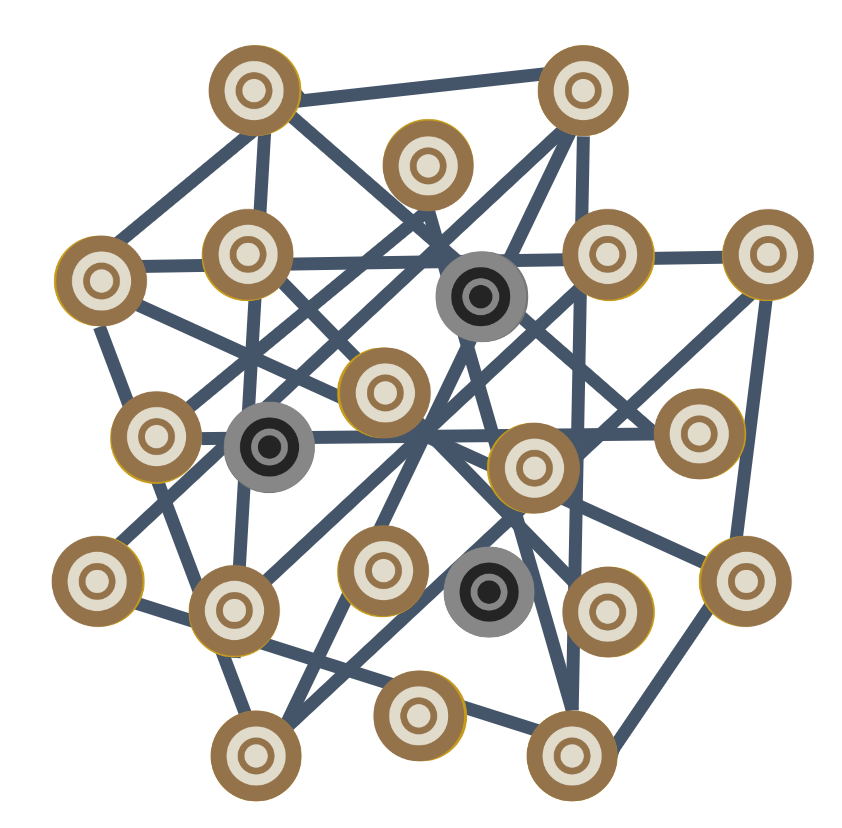

Money, like all mediums (water, blood, etc.) only yields value when its moving. So a dollar that cycles once gains a user access to one unit of value… and so that community gains one unit of value exchange. But if that same dollar moves around 12 times before it leaves, it yields 12 units of value exchange in that community, arguable 12x’ing its worth.
Average time a dollar spends in American urban neighborhoods, and how high quantity of local exchange can get.
In a healthy village…
the Velocity of Money or Money Circulation, and/or Velocity of Barter is very high. There is an entire thriving ecosystem of goods and services, with little needed from beyond the village, and at least as much of the bespoke local products being sought after by outsiders, bringing in more money and variety of bartered goods to the Place. This supports not only material needs, but Essence and personality based specialties, interests, hobbies, etc. (aka some mental and emotional needs).
Some previously redlined neighborhoods, or otherwise passively and/or actively impoverished places still have some locally owned shops and eateries, which increase the Money Circulation in the neighborhood minimally. These are either exploitive businesses (like check cashing or vice selling), or conversely, lauded destinations for folks in many neighborhoods to travel to (e.g. a great bakery, pizza shop, etc.), and/or are hanging on by a thread financially.
In economically thriving American city neighborhoods, these locally owned and operated shops and eateries are the norm, and nonlocal chains are less common, or even the exception. This is no coincidence. In cultures and places where Value Circulation (Money Circulation concept + other forms and mediums of value) there has almost always been a explicit, serious effort to cultivate value creation and asset diversity within the place or culture. Sometimes this goes perhaps too far, and becomes overly insular, and supports and is supported by racism and other forms of xenophobia. But in multicultural communities there might be no limit to the benefit of driving further towards this bias for curated, locally owned operations (for-proit or otherwise) that represent the fullest possible inventory of goods and services. In some places this is even building upon rich ecosystems of retail, and of course art, to extend into micro-industry that produces goods that would otherwise have to come from a big company elsewhere (clothing, shoes, other accessories, furniture.
The residential real estate counterparts to this regenerative retail ecosystem is discussed above in the other sections, and below in the demonstrative design concepts!
This residential and retail homegrown approach, and the socio-economic and cultural “playbooks” being described here represents a version of what Silvie Gallier Howard called “sprout up” economics. In contrast to trickle down.
Read more about how neighborhood economics work in most American cities here.
Core Concept:
How most American cities work: Neighborhood Economics


Many are economically trapped by circumstances they're born into and programs, designed to help, are set up to disqualify individuals as they begin to succeed, but before they can survive independently of that support; many in low-income, redlined, and otherwise abused communities don't know anyone personally that significantly changed their lot in life. Celebrity exceptions are statistically absurd, and studies have shown a strong, present, stable adult deeply believing in you is a key to success, and some have that, and many don't. Many adults in abused communities are absent at least a lot of the daytime, often because they must hold more than one low-income job to provide for basic physical needs (food, energy, and housing). Experience has also shown us that if a person does not personally know someone in a given profession or professional pathway, they simply will not believe it is possible for them to be in it. Experience is the only thing that can overcome these beliefs which are themselves ingrained as a result of an utter, multi-generational lack of that optimistic experience. Government programs are a non-starter for many in such circumstances, who still remember times in their family histories, sometimes not long ago, that filling out a form led to abuse. As neighborhoods in these conditions begin to receive economic development its advocates suggest simplistically that it will benefit everyone. However, rising property prices also mean rising taxes and other living expenses, and existing residents are seldom formally included in the rising tide, held to the bottom by a short chain on their anchor. The cyclical diasporas of the poor are moved around our cities as the churn of investment gnaws through the edges of "good" and "bad" neighborhoods - generally this poor-displacement occurs across the span of a few generations, and then repeats. But this isn't how it works everywhere, and our lost arts of "Villaging" are not gone altogether - there is a way to regenerate people and their places, such that even more economic value is created –actually for all. Beware, there is a huge amount of claims in this arena, but we are committed to approaches in which non-consenting displacement driven by economic development is a DEAL-BREAKER, and Ramboland is the application of some of the most innovative ideas about how this could work differently.
Read more about how neighborhood economies COULD work in most American cities here.
Core Concept:
How most American cities COULD work: Education
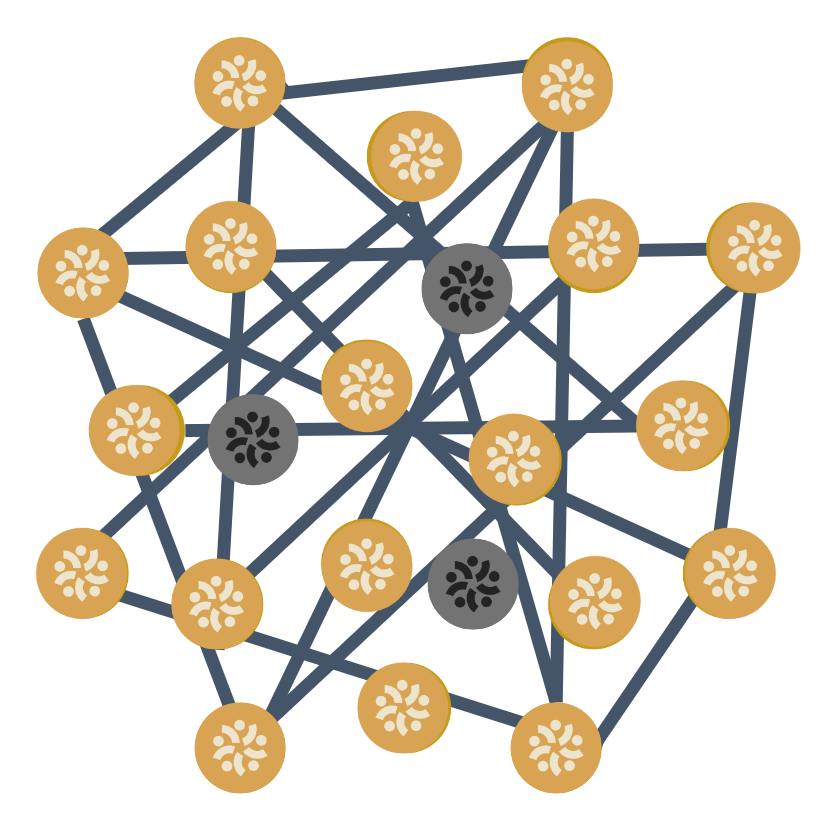

In a healthy village...
children are not stuffed into boxes to learn things, or at least that's not the only or primary way learning happens. In a healthy village most of the youth's learning, and the most important sorts of learning, happen in community, and with several other generations. And they are likewise teaching their elders some things, regenerating the learnings and keeping the elders from settling too firmly into attitudes and positions.
The often adopted/appropriated concept of 7 generation thinking has been misunderstood by even well-intended descendents of settlers. It does not (just) mean thinking about the implications of our decisions on our descendents 7 generations in the future. Nor does it just mean we consider 3 behind us, our own, and 3 ahead of us, though apparently this is closer. Apparently it refers to the number of generations we should each encounter in our lifetime. When we're born we might be lucky enough to know great-grandparents and others from their generation; our elders' elders. But we may also live long enough and be lucky enough in other ways to meet our great-grandchildren. Tending to life-wisdom across 4 generations at any given moment creates resilience in that wisdom. Resilience unavailable when our elders are relegated to only being with each other, often in medical buildings they'd rather not be in, and our children's energy is pulled out of our community most waking hours, so they can learn, mostly data, and not how systems work or how to understand living systems, and step into their working.
We are going through ridiculous business model contortions and creativity in order to enable evolved approaches that not only allow a reintegration of our generations in western modernity, but also weave learning back into that shared-presence, and some technological and programmatic crutches for them to all step into co-learning about both the timeless systems, and rapidly evolving modern ones alike.
Read more about how education works in most American cities here.
Core Concept:
How most American cities work: Education


We have the utmost respect and admiration for educators, and several of us have specific educators from the Lancaster area we credit with being fundamental to the directions we took in life. Many of them would say that the system is working, or at least not well enough. And a lot of that has to do with the fact it is stuck in a few structures and principles that are not conducive to evoking the essence and potential of learners (what education should really be about, as opposed to cramming data into skulls). In addition to this data obsession, we are also stuck in the idea that we should remove learners from their systems, stuff them in buildings, pull apart the systems in the abstract; as opposed to embedding learning how to interact and be a part of the systems of our communities while we engage in their health. We are pulling the energy of our young and others out of the systems that need that energy the most, and attempting to indoctrinate them to use automated "thoughting" rather than increase thinking prowess and capacity. The primary instruments of these education systems are pat memorization, enclosure & fragmentation / reductive methods, and with obedience as a prerequisite for being able to impose this.
Read more about how education COULD work in most American cities here.
Feature:
Kitchen: Pull-down Upper Cabinets
.avif)
.avif)
Storage can be a serious challenge in spaces with high levels of mobility accessibility. Limitations on what can be reached by various folks is not only limited, but often mutually exclusive. I.e. some folks can't reach things down low easily, others can't reach things up high, both for various reasons. Universal Design is an aspiration, a north star that perhaps can never truly be reached, but it can get us a lot of progress in checking ourselves against it, and repeatedly asking ""how can we make this better for more people?""
The kitchen at Ramboland is packed with examples of this, one of our favorites being the pull-down cabinets. There are several versions of this on the market; some allow you to pull the ""guts"" of the cabinet straight down out of the bottom of the cabinet carcass (that's what they call the outer enclosure of cabinets), so that the bottommost shelf in an upper cabinet can be the whole down at counter height, or perhaps even lower if the counter itself can also drop. Others allow those guts to both come down and forward. Still others bring the entire carcass and its guts the whole way down and to the front edge of the counter.
Links to:
Feature:
Kitchen: Low Refrigeration and Dishwasher
.avif)
.avif)
Nothing super innovative here, honestly. Tried and true, energy star certified under-counter freezer (left) and refrigerator (right) and dishwasher (further right, beside sink because it uses water) with a wheelchair pull-in between/beside all of them. The prep space between the two refrigeration units is set at desk height, though may be adjustable. We're leaving the space above the counter on top of the refrigerator open in case an additional refrigerator is desired, or for coffee/espresso machines, toasters, air fryer, or other small appliances.
Links to:
Feature:
Bathroom: The best shower in the tri-state area


"Recirculating shower saves 90% of energy and 85% of water compared to code. High-flow shower head for convenience and quality of life.
Many do not fully appreciate some of the luxuries and coping mechanisms we have in our society, nor realize that many don’t have safe or frequent access to them. For example, showers. In Ron’s current subsistence level living situation, it is unsafe for him to take a shower as well as it is unsafe for his caregivers to assist him during a shower. Because of that, he relies mostly on sponge bathing, as do millions of other people with limited mobility. The shower installed at Ramboland will allow Ron (and ultimately other users) to have access to a full soaker tub with a door that allows a suspension system to carry him safely and conveniently in and out of it. The tub is positioned in such a way that caregivers can reach in from 3 of the 4 sides, a rare convenience. The bathroom will also feature a high-flow shower head next to the bathtub that he can enter independently in a wheelchair or with support of the suspension system and enjoy a better shower experience.
How does this comply with our other environmental goals? Well, the showering system we are installing is called a recirculating shower. Despite its high-flow rainforest shower head, it saves almost 90% of both water and energy compared to a code compliant 2.5 gallon per minute showerhead. This is because unlike standard showers that lose all the water and heat after it passes over our bodies and down the drain only once, water in this system will recirculate about 7 times before being drained. This is possible because the shower has built-in treatment, filtration, and temperature regulators, which also ensure cleaner water than typical tap water and allow for a perfectly controlled water temperature, making them safer in terms of burns and cold shocks – a greater risk with users that have speech challenges.
Links to:
Feature:
Kitchen: Height Adjustable Double Appliance
.avif)
.avif)
As with our split cooktop our design team, including our accessible equipment advisor, have come up with an approach to some of the appliances, which we think will increase accessibility for more folks. By placing two half-height appliances together –one above and one below a height adjustable counter section –, the full size microwave, and an oven can both become highly accessible while using up minimal space.
When the counter is raised a person using a wheelchair could also pull in under the oven, and likely reach both appliances, with really easy access to the oven. When the pair are lowered the whole way to a point at which the oven is on the floor, the microwave could be all the way down to under counter height, and easily accessed from the front, or by someone in a wheelchair who has pulled in beside it under the sink.
Links to:
Feature:
Bathroom: Accessible Bath Tub
.jpeg)
.jpeg)
The bathtub itself is a wheelchair-transfer walk-iIn tub with a fast fill Faucet, and massage jets. The orthopedic and quality of life benefits of this are clear. And like the pot-filler* in the kitchen space, flow-rate is irrelevant, in terms of water usage, because you'll put the same amount of water into the tub regardless of how fast it gets there. Getting it there faster will also save a small amount of energy because less heat will be lost before use.
The bathtub is set up like a peninsula extending into the bathroom instead of with its long side against a wall, as would be the typical way to place it. This is so that care-givers can access the tub from any of 3 sides, including the one where the sink is. The opposite side is the one with the door for transfer. Not only will this be much easier to get in and out for someone reliant on a wheelchair, but it will also enable a very easy transfer using the suspension system dolly**. There is also a floor drain on that side as well tied to the recirculating shower***.
Enabling this level of self care and care-giver ease is very rare, and therefore worth the additional financial cost. Most of us that are more mobile-able take for granted the luxury of being able to shower or take a bath, not only for convenience but the significant mental health benefits.
The fact that the water in this house will be unparalleled in terms of its purity also means that the steam generated in the bathroom will have far fewer contaminants, keeping the indoor air at a higher quality.
This approach is not only much safer – it’s also something that has long been out of reach for many people with mobility challenges. Bathing and showering can be too risky for them and their caregivers, largely because they only have consistent access to non-accessible bathrooms like the one shown in this image of Ron’s current setup. These are the types of facilities typically found in apartments that people with mobility impairments can afford when relying on state subsistence benefits. While programs do exist to support modifications even in rental units, landlords are often unwilling to allow them, or the small square footage and other architectural limitations make renovations cost-prohibitive.
Links to:
Feature:
Kitchen: Height Adjustable Sink
.avif)
.avif)
The height adjustable sink, which uses flex hose to allow fixture movement, provides a wheelchair pull-in space beside the adjacent appliances regardless of which height those are set at, and of course access to the sink itself.
The sink will also have an additional metered faucet control. Metered faucets are those activated usually by pushing down a knob and which then run for a specific amount of time. The button or knob slowly pops up stopping water flow when it has returned to its deactivated original position. This metered control will not control a faucet that pours into this sink however. This is a manual backup for the
irrigation system for the indoor green roof just beyond the top of the kitchen wall, which caps the mechanical room behind it. The primary faucet will be a sensor activated basic kitchen faucet. We will likely also provide a typical sprayer that can also be held and activated by a button on the sprayer head.
Links to:
Feature:
Universal Design: Suspension System


For much of the design process we have planned to provide an overhead track system to support a hanging mechanism that allows Ron, visitors, and/or future residents to be comfortably suspended, and moved easily around the house to key fixtures, appliances, furniture, etc., by a caregiver or their own control interface. Accommodating this structurally and architecturally was challenging and increasing complicatedness and cost. Getting it through doors, and to all those locations was particularly challenging. We recently expanded the track idea to go throughout the entire house however, rationalizing that the track itself was not the costly part, and it even being a somewhat fun ""ride"" for some fit well with the theme park implications of the project name. And yet it was still not universal in the access it granted and getting more over-the-top than might be reasonable even for this swing-for-the-fences project. And then it occurred to us that maybe we could hang the components that actually suspend our bodies from a floor-based mobile unit, something like an engine block lift. We thought this was very clever. In what couldn't even be considered an ""ah ha"" moment, but more like a ""yeah duh"" moment, we realized these make those already. Of course they do. They can fit through doors, turn and move along on casters, change height and orientation for different fixtures, furnishings, and appliances, and more. They can be operated by motor, or caregiver elbow grease.
That said, if we're not able to get the one we want, we may still modify an engine block lift! Which might actually be cooler and cheaper, and perhaps our partners who work and learn in fabrication and robotics labs might help us make that!
Feature:
Bedroom: Convenience Vanity/Sink and Indoor Green Roof
.jpeg)
.jpeg)
There is a convenience lavatory/sink in the bedroom as well – this is just that, convenience. Especially for care-givers convenience in having rapid access to a sink and faucet in the bedroom for drinking or cleanup needs. Like the kitchen sink and faucet, an additional control is included here to manage the low amounts of irrigation the indoor green roofs in both spaces will require – which will also assist in dust control on those horizontal out of reach areas, and the green roofs will help to moderate air contaminants, oxygen levels, and humidity levels, not to mention provide a biophilic psychological benefit.
Links to:
Feature:
Universal Design: 40" Doors
.jpeg)
.jpeg)
36 inch wide doors, per the minimum requirements of ADA, are what we call barely legal. They're just good enough, not great. Someone relying on a wheelchair can easily still lose some knuckle skin going through a 36" wide door if they're self-propelling. Because they are so common, standard doorways have an economy of scale, and so they are cheaper than most other sizes. Despite this we felt it made sense to take a stand and specify 40" wide doors everywhere at Ramboland. Economies of scale only occur when something is legally standardized, or sells enough because of demand. Let's drive up demand for safer, better doors.
For much of the design process we have planned to provide an overhead track system to support a hanging mechanism that allows Ron, visitors, and/or future residents to be comfortably suspended, and moved easily around the house to key fixtures, appliances, furniture, etc., by a caregiver or their own control interface. Accommodating this structurally and architecturally was challenging and increasing complicatedness and cost. Getting it through doors, and to all those locations was particularly challenging. We recently expanded the track idea to go throughout the entire house however, rationalizing that the track itself was not the costly part, and it even being a somewhat fun "ride" for some fit well with the theme park implications of the project name. And yet it was still not universal in the access it granted and getting more over-the-top than might be reasonable even for this swing-for-the-fences project. And then it occurred to us that maybe we could hang the components that actually suspend our bodies from a floor-based mobile unit, something like an engine block lift. We thought this was very clever. In what couldn't even be considered an "ah ha" moment, but more like a "yeah duh" moment, we realized people make those already. Of course they do. They can fit through doors, turn and move along on casters, change height and orientation for different fixtures, furnishings, and appliances, and more. They can be operated by motor, or caregiver elbow grease.
That said, if we're not able to get the one we want, we may still modify an engine block lift! Which might actually be cooler and cheaper, and perhaps our partners who work and learn in fabrication and robotics labs might help us make that!
Feature:
Bathroom: Cool Toilet
.avif)
.avif)
And then of course there is the elephant in the bathroom – the toilet. Although we will not be going with a $6,000 Japanese toilet, but are providing one with excellent geometry for caregiver and user ease, as well as either a built-in or bolt-on bidet and tushy dryer, which are becoming readily and affordably available in the market, and a great help to everyone involved.
In addition to all of those benefits, the plumbing system is set up so that the toiler flushes greywater (insert definition link), which essentially eliminates the negative impacts of water demand for toilet flushing.
A custom designed pedal mechanism as a second option for flushing (which will simply pull down on the dual-flush flush-valve handle) improves hygiene when usable, by allowing hand contact with the fixture to be avoided. In some cases it will also improve accessibility when 1. a user has the ability to step on it but not otherwise operate a flush mechanism higher up, or 2. a user of a wheelchair can maneuver it to run over the pedal.
Links to:
Feature:
Air Quality / Chemistry Monitoring and Treatment


Air quality in western modernity has been a bit of a rollercoaster. Before the industrial revolution humanity had seldom (though certainly not never) produced a concentrated pollutant source consistently enough to create lasting outdoor or even indoor air quality threats or problems. Cities became incredibly polluted in the early and mid stages of industrialization, so much so that those that could live outside of them did so. Regulation and other factors that moved industry out of urban centers from urban poor, to rural poor areas, essentially diluted the contamination enough that it became somewhat less severe issues for broader areas. The Clean Air Act and its sibling Clean Water Act substantially reduced the negative impacts of industry, which had been radically disproportionately impacting poor and non-human living beings. Regulation and enforcement have continued to struggle to keep up with the propagation of new sorts of industries and their new contaminates, and other factors like corporate lobbying and politicians susceptible to it have hindered their effectiveness. But generally the arc of outdoor air quality over nearly the last century and half has been mostly a trend in the healthier direction, with ozone loss for a time, and throughout the century greenhouse gas emissions as indirect health impacts of air contamination steadily rising.
In the mid to late stages of industrialization our industries were producing new chemicals for household and other products at a rate well beyond what testing, medical and health analysis could keep pace with. Fashion trends in architecture and interior design at times exacerbated this, while health and green building rating systems at least pointed the way to often cost-effective avoidance of indoor health threats from products and materials, albeit without really moving the bell-curve of building industry practice all that much. It would be fair to say that have substantially impacted product and material manufacturing, leveraging the PR and marketing motives of building product manufacturers, though greenwashing still runs rampant. Much of these
efforts fall short of proper prioritization and accurate technical considerations however, and the air chemistry being brought to bear on Ramboland is rarified air, both literally and figuratively (sorry, couldn't resist).
By 1. maintaining a simple material palette, 2. maximizing material reuse, 3. being highly critical of chemical content in all products and materials selected, 4. resorting to new materials only when necessary and via local and scientifically validated and/or certified content, as well as 5. introducing filtration and other treatment within rooms and sometimes within HVAC systems (whichever is more effective in terms of air quality, and often also hard costs, and addressing other air quality issues like temperature and humidity as well) Ramboland will have amongst the most pristine air of any building. This 'optimization sequence' ensures maximum performance and minimal cost. Ongoing air quality testing will add insight and prompt responses to air quality impacts materials and products introduced by occupants (clothes, accessories, food, and other belongings) as well as activities like cooking, bathing, cleaning, and respirating, further strides will be made in controlling for and maintaining super healthy air quality beyond design and construction stages, in a way that can be accessed by education systems and the public at large.
Feature:
Counter-intuitive / Outside the Box Thinking
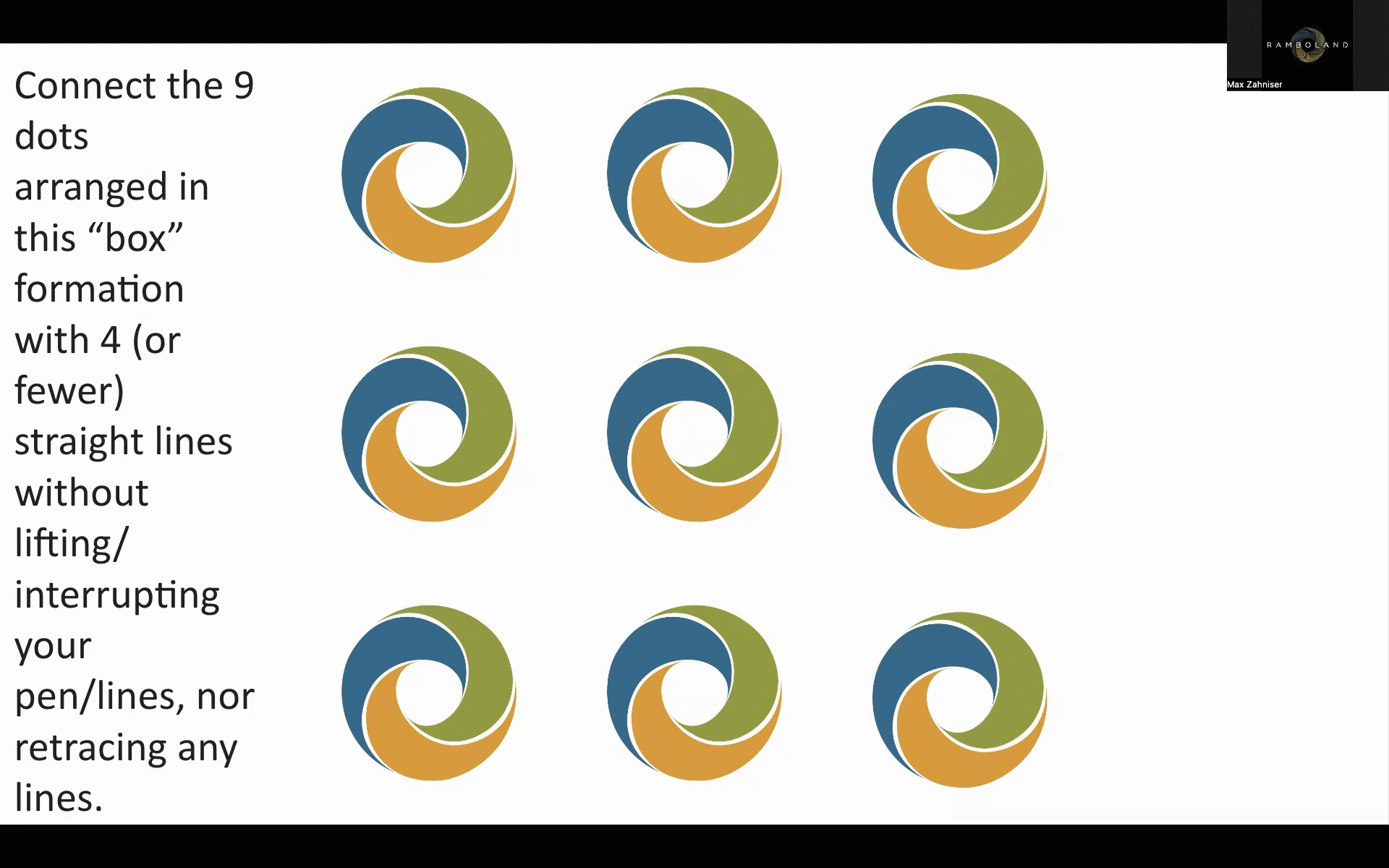

This is a great example of the outside-the-box, creative contortions we find ourselves in when we audaciously step into extremely aggressive goals with a world-class team, working from regenerative thinking and integrative principles. Several of these ideas fly directly in the face of longstanding environmental movement dogma, so we invite you to not reject or accept these ideas before really considering them in their context and in terms of their effects, and what paradigms and assumptions you are sitting in as you do so.
Feature:
How most American cities work: Mobility

Ron Rambo may be responsible for more curb cuts%2C,surface%20of%20an%20adjoining%20street.) and ramps getting added in the City of Lancaster than any other human. As a necessary user himself, Ron has not stopped at attempting to improve his own access, but has been an activist and advocate on behalf of all folks with differing mobilities. That said, most American cities, because ADA is structured in such a way that grandfathers many business, city systems, and buildings into pre-ADA requirements and features, it is still very hard to get around even public areas for many citizens. We have found that many folks, even social and environmental activists, are unaware of this, thinking “that’s no longer an issue, ADA fixed that a long time ago.” In fact, as important as ADA was, it took some of the wind out of the larger movement advocating for progress in these areas, and we must continue to innovate, expanding access in not only economically and environmentally sustainable ways, but in ways that allow more of us to thrive together, in all ways, including economically. Ramboland is proving this is possible, in part by changing the scale and expanding the types of systems we combine. The synergies among energy, water, food, conveyance and mobility, and policy and financial systems are huge, but only if we can look at things differently than we’re accustomed to. Ramboland will cost less to build than Ron will need in subsistence benefits from the state, and it will self-sustain and self-expand financially. What if this was the default for how we address these things all at once.
Close

Ron Rambo may be responsible for more curb cuts%2C,surface%20of%20an%20adjoining%20street.) and ramps getting added in the City of Lancaster than any other human. As a necessary user himself, Ron has not stopped at attempting to improve his own access, but has been an activist and advocate on behalf of all folks with differing mobilities. That said, most American cities, because ADA is structured in such a way that grandfathers many business, city systems, and buildings into pre-ADA requirements and features, it is still very hard to get around even public areas for many citizens. We have found that many folks, even social and environmental activists, are unaware of this, thinking “that’s no longer an issue, ADA fixed that a long time ago.” In fact, as important as ADA was, it took some of the wind out of the larger movement advocating for progress in these areas, and we must continue to innovate, expanding access in not only economically and environmentally sustainable ways, but in ways that allow more of us to thrive together, in all ways, including economically. Ramboland is proving this is possible, in part by changing the scale and expanding the types of systems we combine. The synergies among energy, water, food, conveyance and mobility, and policy and financial systems are huge, but only if we can look at things differently than we’re accustomed to. Ramboland will cost less to build than Ron will need in subsistence benefits from the state, and it will self-sustain and self-expand financially. What if this was the default for how we address these things all at once.

Feature:
Cross-Ventilation & the Venturi Effect
.avif)
The house is oriented to optimize sun angles, penetrating or not, depending on time of year and day*. But the house is also designed to account for prevailing winds.
"Prevailing winds" is a term for the direction wind tends to come from, and in this climate they have tended to come from the Northwest in the Winter (when we don't generally want to be hit by cold air), and the Southwest in the Summer (when we often can benefit from some cross-ventilation and cooling).
So the house is designed with blocking the (north)westerly cold winter prevailing winds in mind, with additional layers of vegetation, insulation, walls, trees, and pockets of air**.
Likewise, the house is designed to scoop up the southwesterly winds in warmer months, so when the temperature is within certain ranges the windows can be opened, and the movement of the air can create whats called "expanded thermal comfort." This is a term for the effect of more air molecules hitting your skin and absorbing some heat from it thanks to the air moving. This increases the rate the body can release heat energy, and thus requires the air to be less cool than when it's not moving as much. Ceiling fans also offer this benefit but use up some electricity to do so (though less than air conditioning).
When early on in our design process the addition of a greenhouse was being considered, we were concerned this might jeopardize our cross ventilation because the greenhouse would block some of that southwesterly winds in some of the warmer months of the year. So we did a type of analysis called Computational Fluid Dynamics (CFD). This technology has been used for a longer period in automobile and aeronautical engineering and design so that cars and planes could be made more aerodynamic. The old fashioned way to do it is to place a model of the geometry of the object being designed in a wind tunnel (literally a room with fans at both ends to create high air speed in one direction), and then smoke being blown blowing in the fan so that the airflow is visible to the observers. CFD software allows us to assess our design in a virtual model without building a physical one yet.
Somewhat to our surprise, the introduction of the greenhouse created whats called a Venturi Effect. This is the phenomenon in which sending a fluid (usually air) through a compressed space causes it to speed up, like a nozzle on a hose, or the tapered or fluted cooling towers and smoke stacks on factories and combustion-based power plants. The breezeway between the house and the greenhouse is angled enough towards the prevailing southwesterly winds, that it captures enough wind and compresses, that that wind is actually accelerated into the house a little bit more than if the greenhouse weren't there.
Using CFD created a lot more confidence that we could not only add the additional complexity of a diverse and high tech food system to the project without sacrificing other performance goals, but in fact enhanced our achievement of those goals. The house will actually be able to use active, electricity consuming air conditioning a little bit less, because our breezeway pushes the air a little bit faster into the south-facing windows in house. As the air inside heats up a bit from contact with warm human bodies and other heat sources inside the house, this will actually help it rise a bit and then more effectively be sucked out of the high-up windows on the north wall of the house. The CFD allowed us to do a lot better than the typical ""wishful thinking arrows"" designers so often use to represent how they hope the air will flow!
Close
.avif)
The house is oriented to optimize sun angles, penetrating or not, depending on time of year and day*. But the house is also designed to account for prevailing winds.
"Prevailing winds" is a term for the direction wind tends to come from, and in this climate they have tended to come from the Northwest in the Winter (when we don't generally want to be hit by cold air), and the Southwest in the Summer (when we often can benefit from some cross-ventilation and cooling).
So the house is designed with blocking the (north)westerly cold winter prevailing winds in mind, with additional layers of vegetation, insulation, walls, trees, and pockets of air**.
Likewise, the house is designed to scoop up the southwesterly winds in warmer months, so when the temperature is within certain ranges the windows can be opened, and the movement of the air can create whats called "expanded thermal comfort." This is a term for the effect of more air molecules hitting your skin and absorbing some heat from it thanks to the air moving. This increases the rate the body can release heat energy, and thus requires the air to be less cool than when it's not moving as much. Ceiling fans also offer this benefit but use up some electricity to do so (though less than air conditioning).
When early on in our design process the addition of a greenhouse was being considered, we were concerned this might jeopardize our cross ventilation because the greenhouse would block some of that southwesterly winds in some of the warmer months of the year. So we did a type of analysis called Computational Fluid Dynamics (CFD). This technology has been used for a longer period in automobile and aeronautical engineering and design so that cars and planes could be made more aerodynamic. The old fashioned way to do it is to place a model of the geometry of the object being designed in a wind tunnel (literally a room with fans at both ends to create high air speed in one direction), and then smoke being blown blowing in the fan so that the airflow is visible to the observers. CFD software allows us to assess our design in a virtual model without building a physical one yet.
Somewhat to our surprise, the introduction of the greenhouse created whats called a Venturi Effect. This is the phenomenon in which sending a fluid (usually air) through a compressed space causes it to speed up, like a nozzle on a hose, or the tapered or fluted cooling towers and smoke stacks on factories and combustion-based power plants. The breezeway between the house and the greenhouse is angled enough towards the prevailing southwesterly winds, that it captures enough wind and compresses, that that wind is actually accelerated into the house a little bit more than if the greenhouse weren't there.
Using CFD created a lot more confidence that we could not only add the additional complexity of a diverse and high tech food system to the project without sacrificing other performance goals, but in fact enhanced our achievement of those goals. The house will actually be able to use active, electricity consuming air conditioning a little bit less, because our breezeway pushes the air a little bit faster into the south-facing windows in house. As the air inside heats up a bit from contact with warm human bodies and other heat sources inside the house, this will actually help it rise a bit and then more effectively be sucked out of the high-up windows on the north wall of the house. The CFD allowed us to do a lot better than the typical ""wishful thinking arrows"" designers so often use to represent how they hope the air will flow!

Core Concept:
How most American cities COULD work: Energy

In a healthy village...
…All energy capacity and needs are understood by many if not all villagers. In times and places in which energy “technologies” amounted only to caloric human efforts, wood burning, and even onsite coal fired furnaces, this meant that villagers were sustainably managing their own usage as well as forest and other fuel source systems within a short travel distance so they never ran out of fuel. Tolerances of much broader temperature swings or extremes were also usually much higher. Architecture almost always accounted for solar angles, prevailing winds, obstructions of both, opportunities to utilize both in energy production / storage, like thermal mass adobe, cross ventilation, stack-effect “roof” openings, evaporative cooling from water bodies and plants, and more. All of these systems and techniques were both teaching tool and subject at once, so that physics, village management, and sacred elements were all learned about simultaneously.
In addition to restoring these “passive” techniques to contemporary construction and management of our habitats, there can be modern American expressions of these elegant and ubiquitously understood vernacular approaches to energy. In a modern American urban neighborhood going through self-directed re-villaging (instead of externally driven economic development, and the gentrification and displacement that almost always comes with it) would likely involve a Community Development Corporation or another candidate entity to serve as a genuinely well-intended positive change agency. This entity would first organize neighbors to be aware, informed, and capable to self-direction, if they are not already (many neighborhoods are, and many are not).
Next focus could shift beyond typical economics-only driven real estate developments that lay bare the landscapes of the neighborhood, vulnerable to vampiric developers who simply want to buy low, sell high, and never really be present in the Place. Instead the shift would be to initiatives like establishing a network of upgraded roofs covered in solar PV, as an extension of already common but underutilized weatherization programs. Furthermore, community held landtrusts or even POA’s (Property Ownership Associations) or a new entity type called an LSA (Land Stewardship Association) which honors the reality of land-personhood, as well as the need to interface with the current paradigm of land ownership. Regardless of entity type, these would establish the permanency and resident ownership and dividend access for managing “central plants” at the core of the block or in vacant rowhomes or lots,, to which upgraded solar roofs would all be tied. Ultimately these manage surpluses of energy across the block to expand to block-centralized heating and cooling, and other beneficial energy uses like pumping rainwater for collection, treatment, and distribution from roofs and even street surfaces for direct distribution of higher-than-utility quality water to homes and agriculture on all utilizable surfaces. This “nanogrid” (because even at block scale this is smaller than most microgrids) would eventually become part of a cellularly-networked mesh of nano-grids connected by physical cabling if power company franchise rights were frozen or redistributed to the CDC’s or RCO’s, or via EV battery exchange choreography (sounds crazy, but transitioning from entrenched, damaging, extractive, cynical systems can involve some pretty counter-intuitive solutions), especially when topography allows for heavy transport of batteries and water downhill, and lighter harvested crops back uphill.
This early establishment of stable, clean, cheap, community managed energy systems creates some resilience amongst existing residents, and establishes steady revenue for an entity, directed by the residents, which can then self-development and/or self-manage others utilizing many alternatives to the typical vampiric approaches to toxic, un-durable and unendurable, intrusive versions of bricks and mortar or bricks and sticks physical homes and other infrastructure developments discussed throughout the rest of this file.
Read more about energy works in most American cities here.
Close

In a healthy village...
…All energy capacity and needs are understood by many if not all villagers. In times and places in which energy “technologies” amounted only to caloric human efforts, wood burning, and even onsite coal fired furnaces, this meant that villagers were sustainably managing their own usage as well as forest and other fuel source systems within a short travel distance so they never ran out of fuel. Tolerances of much broader temperature swings or extremes were also usually much higher. Architecture almost always accounted for solar angles, prevailing winds, obstructions of both, opportunities to utilize both in energy production / storage, like thermal mass adobe, cross ventilation, stack-effect “roof” openings, evaporative cooling from water bodies and plants, and more. All of these systems and techniques were both teaching tool and subject at once, so that physics, village management, and sacred elements were all learned about simultaneously.
In addition to restoring these “passive” techniques to contemporary construction and management of our habitats, there can be modern American expressions of these elegant and ubiquitously understood vernacular approaches to energy. In a modern American urban neighborhood going through self-directed re-villaging (instead of externally driven economic development, and the gentrification and displacement that almost always comes with it) would likely involve a Community Development Corporation or another candidate entity to serve as a genuinely well-intended positive change agency. This entity would first organize neighbors to be aware, informed, and capable to self-direction, if they are not already (many neighborhoods are, and many are not).
Next focus could shift beyond typical economics-only driven real estate developments that lay bare the landscapes of the neighborhood, vulnerable to vampiric developers who simply want to buy low, sell high, and never really be present in the Place. Instead the shift would be to initiatives like establishing a network of upgraded roofs covered in solar PV, as an extension of already common but underutilized weatherization programs. Furthermore, community held landtrusts or even POA’s (Property Ownership Associations) or a new entity type called an LSA (Land Stewardship Association) which honors the reality of land-personhood, as well as the need to interface with the current paradigm of land ownership. Regardless of entity type, these would establish the permanency and resident ownership and dividend access for managing “central plants” at the core of the block or in vacant rowhomes or lots,, to which upgraded solar roofs would all be tied. Ultimately these manage surpluses of energy across the block to expand to block-centralized heating and cooling, and other beneficial energy uses like pumping rainwater for collection, treatment, and distribution from roofs and even street surfaces for direct distribution of higher-than-utility quality water to homes and agriculture on all utilizable surfaces. This “nanogrid” (because even at block scale this is smaller than most microgrids) would eventually become part of a cellularly-networked mesh of nano-grids connected by physical cabling if power company franchise rights were frozen or redistributed to the CDC’s or RCO’s, or via EV battery exchange choreography (sounds crazy, but transitioning from entrenched, damaging, extractive, cynical systems can involve some pretty counter-intuitive solutions), especially when topography allows for heavy transport of batteries and water downhill, and lighter harvested crops back uphill.
This early establishment of stable, clean, cheap, community managed energy systems creates some resilience amongst existing residents, and establishes steady revenue for an entity, directed by the residents, which can then self-development and/or self-manage others utilizing many alternatives to the typical vampiric approaches to toxic, un-durable and unendurable, intrusive versions of bricks and mortar or bricks and sticks physical homes and other infrastructure developments discussed throughout the rest of this file.
Read more about energy works in most American cities here.

Core Concept:
How most American cities work: Energy

The reality is that energy in most American cities is centralized, loss-heavy, fragile, dirty, inequitable, unhealthy, and dangerous.
Hubs we call power-plants are a few vulnerable dots on the map, nodes in a system they would collapse by failing, struggling to keep the entire cardiovascular-like system of the energy grid glowing despite huge swings in production and demand, increasingly frequent natural disasters, terrorism, and tactical warfare. For the most part these strained juggernauts either belch out toxic emissions, and/or emissions that are already beginning to thermally skew the balances of our current atmosphere, biosphere, hydrosphere, pedosphere, etc., or they are producing types of waste that will remain a threat to Life longer than any of our current languages have been used on Earth - demanding the impossible task of creating signage to warn of the peril they present that will be definitely understandable hundreds of thousands or millions of years from now is next to impossible.
So the desperate, despotic, and/or vengeful have singular nodes in the form of mostly dirty and dangerous power-plants they can attack to threaten so many at once, and even the system as a whole. Not only are the regions each power plant serves huge, but the region supported by each juggernaut is limited in its ability to support any others, unless we're lucky enough for the disruptions in one to align with moderate or low stresses in nearly all the others.
Along with all these downsides, these juggernauts and the technology they are based upon enabled incredible progress, luxury, and wealth. And if that arc is to continue we must adapt the system, to allow the juggernauts to retire in honor, for the workers that support them to be honored and thanked, and supported in their transition to other roles. The surpluses of the new pattern can allow this to happen.
Read more about how energy COULD work in most American cities here.
Close

The reality is that energy in most American cities is centralized, loss-heavy, fragile, dirty, inequitable, unhealthy, and dangerous.
Hubs we call power-plants are a few vulnerable dots on the map, nodes in a system they would collapse by failing, struggling to keep the entire cardiovascular-like system of the energy grid glowing despite huge swings in production and demand, increasingly frequent natural disasters, terrorism, and tactical warfare. For the most part these strained juggernauts either belch out toxic emissions, and/or emissions that are already beginning to thermally skew the balances of our current atmosphere, biosphere, hydrosphere, pedosphere, etc., or they are producing types of waste that will remain a threat to Life longer than any of our current languages have been used on Earth - demanding the impossible task of creating signage to warn of the peril they present that will be definitely understandable hundreds of thousands or millions of years from now is next to impossible.
So the desperate, despotic, and/or vengeful have singular nodes in the form of mostly dirty and dangerous power-plants they can attack to threaten so many at once, and even the system as a whole. Not only are the regions each power plant serves huge, but the region supported by each juggernaut is limited in its ability to support any others, unless we're lucky enough for the disruptions in one to align with moderate or low stresses in nearly all the others.
Along with all these downsides, these juggernauts and the technology they are based upon enabled incredible progress, luxury, and wealth. And if that arc is to continue we must adapt the system, to allow the juggernauts to retire in honor, for the workers that support them to be honored and thanked, and supported in their transition to other roles. The surpluses of the new pattern can allow this to happen.
Read more about how energy COULD work in most American cities here.

Core Concept:
How most American cities COULD work: Food

In a healthy village… there tends to be nested patterns of self-sufficiency and exchange with the larger nested collectives. I.E. individual “household” or nuclear families produce much of what they like and need most in their own share of the area. They usually produce a surplus of this, and then trade with neighbors and/or extended family. The core of their diet usually comes from community efforts in which shared food forests and/or fields, and or hunting provides a lot of the base. In some cultures almost all of the production, including the vast variety of flavoring, nutrition, etc. comes from community food systems, in which many or even a majority of the community participates in “cultivating.” These food systems are not exceptions to otherwise “natural” ecology, but a deeply interwoven and interdependent part of it. The ecology of the place is healthier, not hampered, thanks to the humans tending to their own needs for nutrition, medicine, and the pleasures of cuisine, and in full awareness of the balances and dynamics in that ecosystem.
Jumping scale, because every square yard of land is as different from the next as it is one across the continent (Gerald Wilhelm), villages also often have specializations in certain medicines, foods, and cuisines, which creates unique value for their trading with other villages, just as the families do within the village. One can see how the massive scale overspecialization of modern agribusiness is a form of this pattern run amuck, and reaching a scale that this pattern is not appropriate to.
Read more about how food works in most American cities here.
Close

In a healthy village… there tends to be nested patterns of self-sufficiency and exchange with the larger nested collectives. I.E. individual “household” or nuclear families produce much of what they like and need most in their own share of the area. They usually produce a surplus of this, and then trade with neighbors and/or extended family. The core of their diet usually comes from community efforts in which shared food forests and/or fields, and or hunting provides a lot of the base. In some cultures almost all of the production, including the vast variety of flavoring, nutrition, etc. comes from community food systems, in which many or even a majority of the community participates in “cultivating.” These food systems are not exceptions to otherwise “natural” ecology, but a deeply interwoven and interdependent part of it. The ecology of the place is healthier, not hampered, thanks to the humans tending to their own needs for nutrition, medicine, and the pleasures of cuisine, and in full awareness of the balances and dynamics in that ecosystem.
Jumping scale, because every square yard of land is as different from the next as it is one across the continent (Gerald Wilhelm), villages also often have specializations in certain medicines, foods, and cuisines, which creates unique value for their trading with other villages, just as the families do within the village. One can see how the massive scale overspecialization of modern agribusiness is a form of this pattern run amuck, and reaching a scale that this pattern is not appropriate to.
Read more about how food works in most American cities here.


Core Concept:
How most American cities work: Food

Altogether now: centralized, loss-heavy, fragile, dirty, inequitable, unhealthy, dangerous...
Most of the food we eat, for those of us that have access to enough, is coming from far away; from mono-cropped land (land on which only one crop is grown, that is deader than deserts in many ways); bathed in petrochemicals to make up for the un-systemic, extractive methods of cultivation and the problems with pests and lack of nutrients it creates; tended by either massive machines or underpaid, desperate workers destroying their bodies by being hunched over all day, often just to send a few dollars back to poorer family in other countries; and about 40% of it is wasted either on the vine, or on the shelves, or somewhere in between; meanwhile huge populations go without sufficient access to healthy food, and we have simultaneous pandemics of obesity and hunger. Several of the species of plants being grown have been whittled down from numerous sub-species to only one or two, incredibly vulnerable to a single blight, and so heavily subsidized and relied upon that it could collapse our whole food system. And the animals involved are mostly treated like machines or plants, and live miserable, tortuously painful and short lives that resemble several levels of Dante's Hell, and are themselves extremely vulnerable to viruses and other infections and disease, and for that reason and to maximize their productivity are pumped full of hormones and antibiotics, many of which make their way into our food and the water bodies via their excretions being washed by rainwater runoff into the water bodies from which we draw our drinking water.
It is centralized, loss-heavy, fragile, dirty, inequitable, inhumane, brutal, and maybe if that were all in the name of the economic thriving of the people that rely on it throughout that overall chain there would be some kind of argument for protecting our agriculture's current form from reform. But it is squeezing family and small businesses, and primarily benefiting already wealthy subsets of our population, and perhaps also some of the retirement plans of our hard working citizens through pension funds on the stock market being tied up in the transnational corporations running most of it. But who would want their money in such a fragile and grim investment?
And what if it were all unnecessary, and a faster-than-we-think transition that left no one behind were possible? And what if that created far more overall wealth, security, and health for all species. We're not alone in not only believing in this, but testing it and proving it.
Read more about how food COULD work in most American cities here.
Close

Altogether now: centralized, loss-heavy, fragile, dirty, inequitable, unhealthy, dangerous...
Most of the food we eat, for those of us that have access to enough, is coming from far away; from mono-cropped land (land on which only one crop is grown, that is deader than deserts in many ways); bathed in petrochemicals to make up for the un-systemic, extractive methods of cultivation and the problems with pests and lack of nutrients it creates; tended by either massive machines or underpaid, desperate workers destroying their bodies by being hunched over all day, often just to send a few dollars back to poorer family in other countries; and about 40% of it is wasted either on the vine, or on the shelves, or somewhere in between; meanwhile huge populations go without sufficient access to healthy food, and we have simultaneous pandemics of obesity and hunger. Several of the species of plants being grown have been whittled down from numerous sub-species to only one or two, incredibly vulnerable to a single blight, and so heavily subsidized and relied upon that it could collapse our whole food system. And the animals involved are mostly treated like machines or plants, and live miserable, tortuously painful and short lives that resemble several levels of Dante's Hell, and are themselves extremely vulnerable to viruses and other infections and disease, and for that reason and to maximize their productivity are pumped full of hormones and antibiotics, many of which make their way into our food and the water bodies via their excretions being washed by rainwater runoff into the water bodies from which we draw our drinking water.
It is centralized, loss-heavy, fragile, dirty, inequitable, inhumane, brutal, and maybe if that were all in the name of the economic thriving of the people that rely on it throughout that overall chain there would be some kind of argument for protecting our agriculture's current form from reform. But it is squeezing family and small businesses, and primarily benefiting already wealthy subsets of our population, and perhaps also some of the retirement plans of our hard working citizens through pension funds on the stock market being tied up in the transnational corporations running most of it. But who would want their money in such a fragile and grim investment?
And what if it were all unnecessary, and a faster-than-we-think transition that left no one behind were possible? And what if that created far more overall wealth, security, and health for all species. We're not alone in not only believing in this, but testing it and proving it.
Read more about how food COULD work in most American cities here.


Core Concept:
How most American cities COULD work: Water

In a healthy village...
…resources are not taken for granted. Let alone contaminated and cast aside. The combination of having plenty of energy (whatever forms that takes, elbow grease, flowing water, solar radiation, the heat of the Earth herself) and the awareness of the water demands of the maximized healthy abundance in the hyper-local biome, makes the water falling out of the sky an obvious connector. Not only that, the familiarity with how that ecosystem relates to the hydrology, above and below, clues the citizens into the idea that rain does not skip right to the surface water bodies. The living beings take up huge amounts of it, use it for biological processes, often several, before releasing mostly vertically, through infiltration and evaporation/evapotranspiration. What if our built infrastructures did this as well? When significant storage capacity is introduced, not only is there enough water for all the biological processes in many parts of our country, there are also ways to release the water when it is in excess of needs, and without damaging systems and their members downstream.
When goals like "capture all rain, and use it multiple times on site" and "only release water vertically unless its in living being's body (mostly animals and plants that have consumed it)" become guiding principles, well-intended (pun) green building principles, like reducing water use, fall away because those are based on an intention of minutely reducing the contribution to the harm of the centralized municipal water systems. In the approaches explored here there are moments in the year that more water must be used to keep the hydrologic processes in balance.
Read more about how water works in most American cities here.
Close

In a healthy village...
…resources are not taken for granted. Let alone contaminated and cast aside. The combination of having plenty of energy (whatever forms that takes, elbow grease, flowing water, solar radiation, the heat of the Earth herself) and the awareness of the water demands of the maximized healthy abundance in the hyper-local biome, makes the water falling out of the sky an obvious connector. Not only that, the familiarity with how that ecosystem relates to the hydrology, above and below, clues the citizens into the idea that rain does not skip right to the surface water bodies. The living beings take up huge amounts of it, use it for biological processes, often several, before releasing mostly vertically, through infiltration and evaporation/evapotranspiration. What if our built infrastructures did this as well? When significant storage capacity is introduced, not only is there enough water for all the biological processes in many parts of our country, there are also ways to release the water when it is in excess of needs, and without damaging systems and their members downstream.
When goals like "capture all rain, and use it multiple times on site" and "only release water vertically unless its in living being's body (mostly animals and plants that have consumed it)" become guiding principles, well-intended (pun) green building principles, like reducing water use, fall away because those are based on an intention of minutely reducing the contribution to the harm of the centralized municipal water systems. In the approaches explored here there are moments in the year that more water must be used to keep the hydrologic processes in balance.
Read more about how water works in most American cities here.

Core Concept:
How most American cities work: Water

Yep, also centralized, loss-heavy, fragile, dirty, inequitable, unhealthy, dangerous...
Our power-plants and factories dump heat and toxins into water bodies, joined by hormones and pharmaceuticals from run-off from our farmland, and drawn into our water treatment plants which cannot remove all of these health threats. Our cities assure our citizens "the levels of hexavalent chromium (and a bunch of other stuff) are below EPA limits," but the recommended dosage if your doctor hasn't coincidentally prescribed the some of the same pharmaceuticals, is zero. And the test results are mostly from the treatment plants, while many old buildings and infrastructure, predominantly in poor neighborhoods, schools, and homes, contain additional contaminants like lead (because they haven't been updated in decades), so our most vulnerable and underserved are once again getting the worst version of the most basic resources.
Not to mention that the incredible amounts of energy that create a level of pressure in the water system needed to drive flow to all our fixtures, is also both responsible and challenged by the MASSIVE losses to leakage throughout the distribution system. Other than the impacts of the energy use and the production it demands, this might be one of the greatest virtues of this system, because it helps to recharge the aquifers that would otherwise be nearly completely cut off from incoming water due to the excessive amount of impervious surfaces in our cities - we have nearly fully cap the land with hardscape.
We then contaminate all of the water we use, and send it back into the water bodies from whence it came, often without further treatment when rain overwhelms our combined sewer and stormwater systems and causes outflows into these natural water bodies. Then a town downstream pulls it back in to do it again. From a certain perspective, an alien one for example, it might almost seem like the purpose of the system was to contaminate the natural water bodies, and hurt the living beings throughout the system.
This was not done intentionally, and it is largely a function of unforeseen developments in our societies' growth in both size and industrialization. Like our power plants these systems enabled great progress, but that is no reason to ignore their shortcomings and entrench in their current layout, structures, and technologies. If previous generations had thought that way we wouldn’t have had the progress we have. So the lack of progress and the current harm occurring is also now a function of its human operators and corporate and political stewards opposing bigger systemic shifts. We’re being told we must be relegated to coping with these issues with incremental band-aid solutions, one problem at a time, usually addressed by a single technology or technique (often yet another chemical, or energy intensifying form of filtration or treatment).
All the while much cleaner water, at least in some respects, is falling on us from the sky fairly regularly in many parts of the country. We increasingly have more water than we can handle falling out of the sky several times of year, and not enough in others... if only there were a way to take the excess water from the deluges and save it for the droughts! There is, storage. This water has smog, bird poop, pollen, dust, etc. in it, all of which should be removed for human consumption, and only some of which should be removed for irrigation. Removing all of that is much easier than a lot of what is in our municipally supplied water. Whether you treat rain like the sacred, valuable resource it is, or like its a nuisance, it will be a self-fulfilling prophecy. Stormwater is essentially a curse-word for rain or run-off that would not happen if we hadn't paved over almost everything.
The irony of this ignored resource literally hitting us in the face while we complain about it, and take it instead from what is probably the worst stage in the same hydrologic cycle to do so (rivers) is something that can't be unseen once realized.
And again, when you sit down to pencil the math on whether blocks or districts could meet their own water needs, especially if storage and natural treatment approaches were occurring within the core of blocks, in many regions of the U.S. and world, the numbers more than work. If that is tied into food systems and nano-/micro-grids producing a surplus of energy, it starts to become clear that our failure to design a compassionate and effective transition from our disastrous current approaches is the primary problem.
Read more about how water COULD work in most American cities here.
Close

Yep, also centralized, loss-heavy, fragile, dirty, inequitable, unhealthy, dangerous...
Our power-plants and factories dump heat and toxins into water bodies, joined by hormones and pharmaceuticals from run-off from our farmland, and drawn into our water treatment plants which cannot remove all of these health threats. Our cities assure our citizens "the levels of hexavalent chromium (and a bunch of other stuff) are below EPA limits," but the recommended dosage if your doctor hasn't coincidentally prescribed the some of the same pharmaceuticals, is zero. And the test results are mostly from the treatment plants, while many old buildings and infrastructure, predominantly in poor neighborhoods, schools, and homes, contain additional contaminants like lead (because they haven't been updated in decades), so our most vulnerable and underserved are once again getting the worst version of the most basic resources.
Not to mention that the incredible amounts of energy that create a level of pressure in the water system needed to drive flow to all our fixtures, is also both responsible and challenged by the MASSIVE losses to leakage throughout the distribution system. Other than the impacts of the energy use and the production it demands, this might be one of the greatest virtues of this system, because it helps to recharge the aquifers that would otherwise be nearly completely cut off from incoming water due to the excessive amount of impervious surfaces in our cities - we have nearly fully cap the land with hardscape.
We then contaminate all of the water we use, and send it back into the water bodies from whence it came, often without further treatment when rain overwhelms our combined sewer and stormwater systems and causes outflows into these natural water bodies. Then a town downstream pulls it back in to do it again. From a certain perspective, an alien one for example, it might almost seem like the purpose of the system was to contaminate the natural water bodies, and hurt the living beings throughout the system.
This was not done intentionally, and it is largely a function of unforeseen developments in our societies' growth in both size and industrialization. Like our power plants these systems enabled great progress, but that is no reason to ignore their shortcomings and entrench in their current layout, structures, and technologies. If previous generations had thought that way we wouldn’t have had the progress we have. So the lack of progress and the current harm occurring is also now a function of its human operators and corporate and political stewards opposing bigger systemic shifts. We’re being told we must be relegated to coping with these issues with incremental band-aid solutions, one problem at a time, usually addressed by a single technology or technique (often yet another chemical, or energy intensifying form of filtration or treatment).
All the while much cleaner water, at least in some respects, is falling on us from the sky fairly regularly in many parts of the country. We increasingly have more water than we can handle falling out of the sky several times of year, and not enough in others... if only there were a way to take the excess water from the deluges and save it for the droughts! There is, storage. This water has smog, bird poop, pollen, dust, etc. in it, all of which should be removed for human consumption, and only some of which should be removed for irrigation. Removing all of that is much easier than a lot of what is in our municipally supplied water. Whether you treat rain like the sacred, valuable resource it is, or like its a nuisance, it will be a self-fulfilling prophecy. Stormwater is essentially a curse-word for rain or run-off that would not happen if we hadn't paved over almost everything.
The irony of this ignored resource literally hitting us in the face while we complain about it, and take it instead from what is probably the worst stage in the same hydrologic cycle to do so (rivers) is something that can't be unseen once realized.
And again, when you sit down to pencil the math on whether blocks or districts could meet their own water needs, especially if storage and natural treatment approaches were occurring within the core of blocks, in many regions of the U.S. and world, the numbers more than work. If that is tied into food systems and nano-/micro-grids producing a surplus of energy, it starts to become clear that our failure to design a compassionate and effective transition from our disastrous current approaches is the primary problem.
Read more about how water COULD work in most American cities here.

Core Concept:
How most American cities COULD work: Neighborhood Economics

Money, like all mediums (water, blood, etc.) only yields value when its moving. So a dollar that cycles once gains a user access to one unit of value… and so that community gains one unit of value exchange. But if that same dollar moves around 12 times before it leaves, it yields 12 units of value exchange in that community, arguable 12x’ing its worth.
Average time a dollar spends in American urban neighborhoods, and how high quantity of local exchange can get.
In a healthy village…
the Velocity of Money or Money Circulation, and/or Velocity of Barter is very high. There is an entire thriving ecosystem of goods and services, with little needed from beyond the village, and at least as much of the bespoke local products being sought after by outsiders, bringing in more money and variety of bartered goods to the Place. This supports not only material needs, but Essence and personality based specialties, interests, hobbies, etc. (aka some mental and emotional needs).
Some previously redlined neighborhoods, or otherwise passively and/or actively impoverished places still have some locally owned shops and eateries, which increase the Money Circulation in the neighborhood minimally. These are either exploitive businesses (like check cashing or vice selling), or conversely, lauded destinations for folks in many neighborhoods to travel to (e.g. a great bakery, pizza shop, etc.), and/or are hanging on by a thread financially.
In economically thriving American city neighborhoods, these locally owned and operated shops and eateries are the norm, and nonlocal chains are less common, or even the exception. This is no coincidence. In cultures and places where Value Circulation (Money Circulation concept + other forms and mediums of value) there has almost always been a explicit, serious effort to cultivate value creation and asset diversity within the place or culture. Sometimes this goes perhaps too far, and becomes overly insular, and supports and is supported by racism and other forms of xenophobia. But in multicultural communities there might be no limit to the benefit of driving further towards this bias for curated, locally owned operations (for-proit or otherwise) that represent the fullest possible inventory of goods and services. In some places this is even building upon rich ecosystems of retail, and of course art, to extend into micro-industry that produces goods that would otherwise have to come from a big company elsewhere (clothing, shoes, other accessories, furniture.
The residential real estate counterparts to this regenerative retail ecosystem is discussed above in the other sections, and below in the demonstrative design concepts!
This residential and retail homegrown approach, and the socio-economic and cultural “playbooks” being described here represents a version of what Silvie Gallier Howard called “sprout up” economics. In contrast to trickle down.
Read more about how neighborhood economics work in most American cities here.
Close

Money, like all mediums (water, blood, etc.) only yields value when its moving. So a dollar that cycles once gains a user access to one unit of value… and so that community gains one unit of value exchange. But if that same dollar moves around 12 times before it leaves, it yields 12 units of value exchange in that community, arguable 12x’ing its worth.
Average time a dollar spends in American urban neighborhoods, and how high quantity of local exchange can get.
In a healthy village…
the Velocity of Money or Money Circulation, and/or Velocity of Barter is very high. There is an entire thriving ecosystem of goods and services, with little needed from beyond the village, and at least as much of the bespoke local products being sought after by outsiders, bringing in more money and variety of bartered goods to the Place. This supports not only material needs, but Essence and personality based specialties, interests, hobbies, etc. (aka some mental and emotional needs).
Some previously redlined neighborhoods, or otherwise passively and/or actively impoverished places still have some locally owned shops and eateries, which increase the Money Circulation in the neighborhood minimally. These are either exploitive businesses (like check cashing or vice selling), or conversely, lauded destinations for folks in many neighborhoods to travel to (e.g. a great bakery, pizza shop, etc.), and/or are hanging on by a thread financially.
In economically thriving American city neighborhoods, these locally owned and operated shops and eateries are the norm, and nonlocal chains are less common, or even the exception. This is no coincidence. In cultures and places where Value Circulation (Money Circulation concept + other forms and mediums of value) there has almost always been a explicit, serious effort to cultivate value creation and asset diversity within the place or culture. Sometimes this goes perhaps too far, and becomes overly insular, and supports and is supported by racism and other forms of xenophobia. But in multicultural communities there might be no limit to the benefit of driving further towards this bias for curated, locally owned operations (for-proit or otherwise) that represent the fullest possible inventory of goods and services. In some places this is even building upon rich ecosystems of retail, and of course art, to extend into micro-industry that produces goods that would otherwise have to come from a big company elsewhere (clothing, shoes, other accessories, furniture.
The residential real estate counterparts to this regenerative retail ecosystem is discussed above in the other sections, and below in the demonstrative design concepts!
This residential and retail homegrown approach, and the socio-economic and cultural “playbooks” being described here represents a version of what Silvie Gallier Howard called “sprout up” economics. In contrast to trickle down.
Read more about how neighborhood economics work in most American cities here.

Core Concept:
How most American cities work: Neighborhood Economics

Many are economically trapped by circumstances they're born into and programs, designed to help, are set up to disqualify individuals as they begin to succeed, but before they can survive independently of that support; many in low-income, redlined, and otherwise abused communities don't know anyone personally that significantly changed their lot in life. Celebrity exceptions are statistically absurd, and studies have shown a strong, present, stable adult deeply believing in you is a key to success, and some have that, and many don't. Many adults in abused communities are absent at least a lot of the daytime, often because they must hold more than one low-income job to provide for basic physical needs (food, energy, and housing). Experience has also shown us that if a person does not personally know someone in a given profession or professional pathway, they simply will not believe it is possible for them to be in it. Experience is the only thing that can overcome these beliefs which are themselves ingrained as a result of an utter, multi-generational lack of that optimistic experience. Government programs are a non-starter for many in such circumstances, who still remember times in their family histories, sometimes not long ago, that filling out a form led to abuse. As neighborhoods in these conditions begin to receive economic development its advocates suggest simplistically that it will benefit everyone. However, rising property prices also mean rising taxes and other living expenses, and existing residents are seldom formally included in the rising tide, held to the bottom by a short chain on their anchor. The cyclical diasporas of the poor are moved around our cities as the churn of investment gnaws through the edges of "good" and "bad" neighborhoods - generally this poor-displacement occurs across the span of a few generations, and then repeats. But this isn't how it works everywhere, and our lost arts of "Villaging" are not gone altogether - there is a way to regenerate people and their places, such that even more economic value is created –actually for all. Beware, there is a huge amount of claims in this arena, but we are committed to approaches in which non-consenting displacement driven by economic development is a DEAL-BREAKER, and Ramboland is the application of some of the most innovative ideas about how this could work differently.
Read more about how neighborhood economies COULD work in most American cities here.
Close

Many are economically trapped by circumstances they're born into and programs, designed to help, are set up to disqualify individuals as they begin to succeed, but before they can survive independently of that support; many in low-income, redlined, and otherwise abused communities don't know anyone personally that significantly changed their lot in life. Celebrity exceptions are statistically absurd, and studies have shown a strong, present, stable adult deeply believing in you is a key to success, and some have that, and many don't. Many adults in abused communities are absent at least a lot of the daytime, often because they must hold more than one low-income job to provide for basic physical needs (food, energy, and housing). Experience has also shown us that if a person does not personally know someone in a given profession or professional pathway, they simply will not believe it is possible for them to be in it. Experience is the only thing that can overcome these beliefs which are themselves ingrained as a result of an utter, multi-generational lack of that optimistic experience. Government programs are a non-starter for many in such circumstances, who still remember times in their family histories, sometimes not long ago, that filling out a form led to abuse. As neighborhoods in these conditions begin to receive economic development its advocates suggest simplistically that it will benefit everyone. However, rising property prices also mean rising taxes and other living expenses, and existing residents are seldom formally included in the rising tide, held to the bottom by a short chain on their anchor. The cyclical diasporas of the poor are moved around our cities as the churn of investment gnaws through the edges of "good" and "bad" neighborhoods - generally this poor-displacement occurs across the span of a few generations, and then repeats. But this isn't how it works everywhere, and our lost arts of "Villaging" are not gone altogether - there is a way to regenerate people and their places, such that even more economic value is created –actually for all. Beware, there is a huge amount of claims in this arena, but we are committed to approaches in which non-consenting displacement driven by economic development is a DEAL-BREAKER, and Ramboland is the application of some of the most innovative ideas about how this could work differently.
Read more about how neighborhood economies COULD work in most American cities here.

Core Concept:
How most American cities COULD work: Education

In a healthy village...
children are not stuffed into boxes to learn things, or at least that's not the only or primary way learning happens. In a healthy village most of the youth's learning, and the most important sorts of learning, happen in community, and with several other generations. And they are likewise teaching their elders some things, regenerating the learnings and keeping the elders from settling too firmly into attitudes and positions.
The often adopted/appropriated concept of 7 generation thinking has been misunderstood by even well-intended descendents of settlers. It does not (just) mean thinking about the implications of our decisions on our descendents 7 generations in the future. Nor does it just mean we consider 3 behind us, our own, and 3 ahead of us, though apparently this is closer. Apparently it refers to the number of generations we should each encounter in our lifetime. When we're born we might be lucky enough to know great-grandparents and others from their generation; our elders' elders. But we may also live long enough and be lucky enough in other ways to meet our great-grandchildren. Tending to life-wisdom across 4 generations at any given moment creates resilience in that wisdom. Resilience unavailable when our elders are relegated to only being with each other, often in medical buildings they'd rather not be in, and our children's energy is pulled out of our community most waking hours, so they can learn, mostly data, and not how systems work or how to understand living systems, and step into their working.
We are going through ridiculous business model contortions and creativity in order to enable evolved approaches that not only allow a reintegration of our generations in western modernity, but also weave learning back into that shared-presence, and some technological and programmatic crutches for them to all step into co-learning about both the timeless systems, and rapidly evolving modern ones alike.
Read more about how education works in most American cities here.
Close

In a healthy village...
children are not stuffed into boxes to learn things, or at least that's not the only or primary way learning happens. In a healthy village most of the youth's learning, and the most important sorts of learning, happen in community, and with several other generations. And they are likewise teaching their elders some things, regenerating the learnings and keeping the elders from settling too firmly into attitudes and positions.
The often adopted/appropriated concept of 7 generation thinking has been misunderstood by even well-intended descendents of settlers. It does not (just) mean thinking about the implications of our decisions on our descendents 7 generations in the future. Nor does it just mean we consider 3 behind us, our own, and 3 ahead of us, though apparently this is closer. Apparently it refers to the number of generations we should each encounter in our lifetime. When we're born we might be lucky enough to know great-grandparents and others from their generation; our elders' elders. But we may also live long enough and be lucky enough in other ways to meet our great-grandchildren. Tending to life-wisdom across 4 generations at any given moment creates resilience in that wisdom. Resilience unavailable when our elders are relegated to only being with each other, often in medical buildings they'd rather not be in, and our children's energy is pulled out of our community most waking hours, so they can learn, mostly data, and not how systems work or how to understand living systems, and step into their working.
We are going through ridiculous business model contortions and creativity in order to enable evolved approaches that not only allow a reintegration of our generations in western modernity, but also weave learning back into that shared-presence, and some technological and programmatic crutches for them to all step into co-learning about both the timeless systems, and rapidly evolving modern ones alike.
Read more about how education works in most American cities here.

Core Concept:
How most American cities work: Education

We have the utmost respect and admiration for educators, and several of us have specific educators from the Lancaster area we credit with being fundamental to the directions we took in life. Many of them would say that the system is working, or at least not well enough. And a lot of that has to do with the fact it is stuck in a few structures and principles that are not conducive to evoking the essence and potential of learners (what education should really be about, as opposed to cramming data into skulls). In addition to this data obsession, we are also stuck in the idea that we should remove learners from their systems, stuff them in buildings, pull apart the systems in the abstract; as opposed to embedding learning how to interact and be a part of the systems of our communities while we engage in their health. We are pulling the energy of our young and others out of the systems that need that energy the most, and attempting to indoctrinate them to use automated "thoughting" rather than increase thinking prowess and capacity. The primary instruments of these education systems are pat memorization, enclosure & fragmentation / reductive methods, and with obedience as a prerequisite for being able to impose this.
Read more about how education COULD work in most American cities here.
Close

We have the utmost respect and admiration for educators, and several of us have specific educators from the Lancaster area we credit with being fundamental to the directions we took in life. Many of them would say that the system is working, or at least not well enough. And a lot of that has to do with the fact it is stuck in a few structures and principles that are not conducive to evoking the essence and potential of learners (what education should really be about, as opposed to cramming data into skulls). In addition to this data obsession, we are also stuck in the idea that we should remove learners from their systems, stuff them in buildings, pull apart the systems in the abstract; as opposed to embedding learning how to interact and be a part of the systems of our communities while we engage in their health. We are pulling the energy of our young and others out of the systems that need that energy the most, and attempting to indoctrinate them to use automated "thoughting" rather than increase thinking prowess and capacity. The primary instruments of these education systems are pat memorization, enclosure & fragmentation / reductive methods, and with obedience as a prerequisite for being able to impose this.
Read more about how education COULD work in most American cities here.

Feature:
Hot water system

Recent innovations in hot water heaters have led not only to a more widely available energy efficient option than typical gas fired or even old electric water heater technology. But hot water heat pumps have also introduced a new source of cool air. As these units produce hot water buy pulling energy out of the air, they expel cooled air. In the winter this can be a bit of problem, because you’re effectively placing a small air conditioner, usually in your basement, during months you’re already spending too much energy on heating. We will exhaust this cooled air to the outside of the building in these months. But precooling the air in our mechanical room in the warmer months is a benefit.
Coupled with a few hot water solar panels on the roof, not only will we be able to produce all the hot water we need using very little energy, but we are also investigating a warmwater, subsurface irrigation system to supplement heating in the greenhouse and even extend growing seasons in outdoors raised beds. One of the many living-lab experiments we’ll be doing early on.
(Image source: DOE)
Close

Recent innovations in hot water heaters have led not only to a more widely available energy efficient option than typical gas fired or even old electric water heater technology. But hot water heat pumps have also introduced a new source of cool air. As these units produce hot water buy pulling energy out of the air, they expel cooled air. In the winter this can be a bit of problem, because you’re effectively placing a small air conditioner, usually in your basement, during months you’re already spending too much energy on heating. We will exhaust this cooled air to the outside of the building in these months. But precooling the air in our mechanical room in the warmer months is a benefit.
Coupled with a few hot water solar panels on the roof, not only will we be able to produce all the hot water we need using very little energy, but we are also investigating a warmwater, subsurface irrigation system to supplement heating in the greenhouse and even extend growing seasons in outdoors raised beds. One of the many living-lab experiments we’ll be doing early on.
(Image source: DOE)


Feature:
Kitchen: Pull-down Upper Cabinets
.avif)
Storage can be a serious challenge in spaces with high levels of mobility accessibility. Limitations on what can be reached by various folks is not only limited, but often mutually exclusive. I.e. some folks can't reach things down low easily, others can't reach things up high, both for various reasons. Universal Design is an aspiration, a north star that perhaps can never truly be reached, but it can get us a lot of progress in checking ourselves against it, and repeatedly asking ""how can we make this better for more people?""
The kitchen at Ramboland is packed with examples of this, one of our favorites being the pull-down cabinets. There are several versions of this on the market; some allow you to pull the ""guts"" of the cabinet straight down out of the bottom of the cabinet carcass (that's what they call the outer enclosure of cabinets), so that the bottommost shelf in an upper cabinet can be the whole down at counter height, or perhaps even lower if the counter itself can also drop. Others allow those guts to both come down and forward. Still others bring the entire carcass and its guts the whole way down and to the front edge of the counter.
Links to:
Close
.avif)
Storage can be a serious challenge in spaces with high levels of mobility accessibility. Limitations on what can be reached by various folks is not only limited, but often mutually exclusive. I.e. some folks can't reach things down low easily, others can't reach things up high, both for various reasons. Universal Design is an aspiration, a north star that perhaps can never truly be reached, but it can get us a lot of progress in checking ourselves against it, and repeatedly asking ""how can we make this better for more people?""
The kitchen at Ramboland is packed with examples of this, one of our favorites being the pull-down cabinets. There are several versions of this on the market; some allow you to pull the ""guts"" of the cabinet straight down out of the bottom of the cabinet carcass (that's what they call the outer enclosure of cabinets), so that the bottommost shelf in an upper cabinet can be the whole down at counter height, or perhaps even lower if the counter itself can also drop. Others allow those guts to both come down and forward. Still others bring the entire carcass and its guts the whole way down and to the front edge of the counter.
Links to:


Feature:
Kitchen: Low Refrigeration and Dishwasher
.avif)
Nothing super innovative here, honestly. Tried and true, energy star certified under-counter freezer (left) and refrigerator (right) and dishwasher (further right, beside sink because it uses water) with a wheelchair pull-in between/beside all of them. The prep space between the two refrigeration units is set at desk height, though may be adjustable. We're leaving the space above the counter on top of the refrigerator open in case an additional refrigerator is desired, or for coffee/espresso machines, toasters, air fryer, or other small appliances.
Links to:
Close
.avif)
Nothing super innovative here, honestly. Tried and true, energy star certified under-counter freezer (left) and refrigerator (right) and dishwasher (further right, beside sink because it uses water) with a wheelchair pull-in between/beside all of them. The prep space between the two refrigeration units is set at desk height, though may be adjustable. We're leaving the space above the counter on top of the refrigerator open in case an additional refrigerator is desired, or for coffee/espresso machines, toasters, air fryer, or other small appliances.
Links to:




Feature:
Bathroom: The best shower in the tri-state area

"Recirculating shower saves 90% of energy and 85% of water compared to code. High-flow shower head for convenience and quality of life.
Many do not fully appreciate some of the luxuries and coping mechanisms we have in our society, nor realize that many don’t have safe or frequent access to them. For example, showers. In Ron’s current subsistence level living situation, it is unsafe for him to take a shower as well as it is unsafe for his caregivers to assist him during a shower. Because of that, he relies mostly on sponge bathing, as do millions of other people with limited mobility. The shower installed at Ramboland will allow Ron (and ultimately other users) to have access to a full soaker tub with a door that allows a suspension system to carry him safely and conveniently in and out of it. The tub is positioned in such a way that caregivers can reach in from 3 of the 4 sides, a rare convenience. The bathroom will also feature a high-flow shower head next to the bathtub that he can enter independently in a wheelchair or with support of the suspension system and enjoy a better shower experience.
How does this comply with our other environmental goals? Well, the showering system we are installing is called a recirculating shower. Despite its high-flow rainforest shower head, it saves almost 90% of both water and energy compared to a code compliant 2.5 gallon per minute showerhead. This is because unlike standard showers that lose all the water and heat after it passes over our bodies and down the drain only once, water in this system will recirculate about 7 times before being drained. This is possible because the shower has built-in treatment, filtration, and temperature regulators, which also ensure cleaner water than typical tap water and allow for a perfectly controlled water temperature, making them safer in terms of burns and cold shocks – a greater risk with users that have speech challenges.
Links to:
Close

"Recirculating shower saves 90% of energy and 85% of water compared to code. High-flow shower head for convenience and quality of life.
Many do not fully appreciate some of the luxuries and coping mechanisms we have in our society, nor realize that many don’t have safe or frequent access to them. For example, showers. In Ron’s current subsistence level living situation, it is unsafe for him to take a shower as well as it is unsafe for his caregivers to assist him during a shower. Because of that, he relies mostly on sponge bathing, as do millions of other people with limited mobility. The shower installed at Ramboland will allow Ron (and ultimately other users) to have access to a full soaker tub with a door that allows a suspension system to carry him safely and conveniently in and out of it. The tub is positioned in such a way that caregivers can reach in from 3 of the 4 sides, a rare convenience. The bathroom will also feature a high-flow shower head next to the bathtub that he can enter independently in a wheelchair or with support of the suspension system and enjoy a better shower experience.
How does this comply with our other environmental goals? Well, the showering system we are installing is called a recirculating shower. Despite its high-flow rainforest shower head, it saves almost 90% of both water and energy compared to a code compliant 2.5 gallon per minute showerhead. This is because unlike standard showers that lose all the water and heat after it passes over our bodies and down the drain only once, water in this system will recirculate about 7 times before being drained. This is possible because the shower has built-in treatment, filtration, and temperature regulators, which also ensure cleaner water than typical tap water and allow for a perfectly controlled water temperature, making them safer in terms of burns and cold shocks – a greater risk with users that have speech challenges.
Links to:



Feature:
Kitchen: Height Adjustable Double Appliance
.avif)
As with our split cooktop our design team, including our accessible equipment advisor, have come up with an approach to some of the appliances, which we think will increase accessibility for more folks. By placing two half-height appliances together –one above and one below a height adjustable counter section –, the full size microwave, and an oven can both become highly accessible while using up minimal space.
When the counter is raised a person using a wheelchair could also pull in under the oven, and likely reach both appliances, with really easy access to the oven. When the pair are lowered the whole way to a point at which the oven is on the floor, the microwave could be all the way down to under counter height, and easily accessed from the front, or by someone in a wheelchair who has pulled in beside it under the sink.
Links to:
Close
.avif)
As with our split cooktop our design team, including our accessible equipment advisor, have come up with an approach to some of the appliances, which we think will increase accessibility for more folks. By placing two half-height appliances together –one above and one below a height adjustable counter section –, the full size microwave, and an oven can both become highly accessible while using up minimal space.
When the counter is raised a person using a wheelchair could also pull in under the oven, and likely reach both appliances, with really easy access to the oven. When the pair are lowered the whole way to a point at which the oven is on the floor, the microwave could be all the way down to under counter height, and easily accessed from the front, or by someone in a wheelchair who has pulled in beside it under the sink.
Links to:


Feature:
Bathroom: Accessible Bath Tub
.jpeg)
The bathtub itself is a wheelchair-transfer walk-iIn tub with a fast fill Faucet, and massage jets. The orthopedic and quality of life benefits of this are clear. And like the pot-filler* in the kitchen space, flow-rate is irrelevant, in terms of water usage, because you'll put the same amount of water into the tub regardless of how fast it gets there. Getting it there faster will also save a small amount of energy because less heat will be lost before use.
The bathtub is set up like a peninsula extending into the bathroom instead of with its long side against a wall, as would be the typical way to place it. This is so that care-givers can access the tub from any of 3 sides, including the one where the sink is. The opposite side is the one with the door for transfer. Not only will this be much easier to get in and out for someone reliant on a wheelchair, but it will also enable a very easy transfer using the suspension system dolly**. There is also a floor drain on that side as well tied to the recirculating shower***.
Enabling this level of self care and care-giver ease is very rare, and therefore worth the additional financial cost. Most of us that are more mobile-able take for granted the luxury of being able to shower or take a bath, not only for convenience but the significant mental health benefits.
The fact that the water in this house will be unparalleled in terms of its purity also means that the steam generated in the bathroom will have far fewer contaminants, keeping the indoor air at a higher quality.
This approach is not only much safer – it’s also something that has long been out of reach for many people with mobility challenges. Bathing and showering can be too risky for them and their caregivers, largely because they only have consistent access to non-accessible bathrooms like the one shown in this image of Ron’s current setup. These are the types of facilities typically found in apartments that people with mobility impairments can afford when relying on state subsistence benefits. While programs do exist to support modifications even in rental units, landlords are often unwilling to allow them, or the small square footage and other architectural limitations make renovations cost-prohibitive.
Links to:
Close
.jpeg)
The bathtub itself is a wheelchair-transfer walk-iIn tub with a fast fill Faucet, and massage jets. The orthopedic and quality of life benefits of this are clear. And like the pot-filler* in the kitchen space, flow-rate is irrelevant, in terms of water usage, because you'll put the same amount of water into the tub regardless of how fast it gets there. Getting it there faster will also save a small amount of energy because less heat will be lost before use.
The bathtub is set up like a peninsula extending into the bathroom instead of with its long side against a wall, as would be the typical way to place it. This is so that care-givers can access the tub from any of 3 sides, including the one where the sink is. The opposite side is the one with the door for transfer. Not only will this be much easier to get in and out for someone reliant on a wheelchair, but it will also enable a very easy transfer using the suspension system dolly**. There is also a floor drain on that side as well tied to the recirculating shower***.
Enabling this level of self care and care-giver ease is very rare, and therefore worth the additional financial cost. Most of us that are more mobile-able take for granted the luxury of being able to shower or take a bath, not only for convenience but the significant mental health benefits.
The fact that the water in this house will be unparalleled in terms of its purity also means that the steam generated in the bathroom will have far fewer contaminants, keeping the indoor air at a higher quality.
This approach is not only much safer – it’s also something that has long been out of reach for many people with mobility challenges. Bathing and showering can be too risky for them and their caregivers, largely because they only have consistent access to non-accessible bathrooms like the one shown in this image of Ron’s current setup. These are the types of facilities typically found in apartments that people with mobility impairments can afford when relying on state subsistence benefits. While programs do exist to support modifications even in rental units, landlords are often unwilling to allow them, or the small square footage and other architectural limitations make renovations cost-prohibitive.
Links to:


Feature:
Kitchen: Height Adjustable Sink
.avif)
The height adjustable sink, which uses flex hose to allow fixture movement, provides a wheelchair pull-in space beside the adjacent appliances regardless of which height those are set at, and of course access to the sink itself.
The sink will also have an additional metered faucet control. Metered faucets are those activated usually by pushing down a knob and which then run for a specific amount of time. The button or knob slowly pops up stopping water flow when it has returned to its deactivated original position. This metered control will not control a faucet that pours into this sink however. This is a manual backup for the
irrigation system for the indoor green roof just beyond the top of the kitchen wall, which caps the mechanical room behind it. The primary faucet will be a sensor activated basic kitchen faucet. We will likely also provide a typical sprayer that can also be held and activated by a button on the sprayer head.
Links to:
Close
.avif)
The height adjustable sink, which uses flex hose to allow fixture movement, provides a wheelchair pull-in space beside the adjacent appliances regardless of which height those are set at, and of course access to the sink itself.
The sink will also have an additional metered faucet control. Metered faucets are those activated usually by pushing down a knob and which then run for a specific amount of time. The button or knob slowly pops up stopping water flow when it has returned to its deactivated original position. This metered control will not control a faucet that pours into this sink however. This is a manual backup for the
irrigation system for the indoor green roof just beyond the top of the kitchen wall, which caps the mechanical room behind it. The primary faucet will be a sensor activated basic kitchen faucet. We will likely also provide a typical sprayer that can also be held and activated by a button on the sprayer head.
Links to:


Feature:
Universal Design: Suspension System

For much of the design process we have planned to provide an overhead track system to support a hanging mechanism that allows Ron, visitors, and/or future residents to be comfortably suspended, and moved easily around the house to key fixtures, appliances, furniture, etc., by a caregiver or their own control interface. Accommodating this structurally and architecturally was challenging and increasing complicatedness and cost. Getting it through doors, and to all those locations was particularly challenging. We recently expanded the track idea to go throughout the entire house however, rationalizing that the track itself was not the costly part, and it even being a somewhat fun ""ride"" for some fit well with the theme park implications of the project name. And yet it was still not universal in the access it granted and getting more over-the-top than might be reasonable even for this swing-for-the-fences project. And then it occurred to us that maybe we could hang the components that actually suspend our bodies from a floor-based mobile unit, something like an engine block lift. We thought this was very clever. In what couldn't even be considered an ""ah ha"" moment, but more like a ""yeah duh"" moment, we realized these make those already. Of course they do. They can fit through doors, turn and move along on casters, change height and orientation for different fixtures, furnishings, and appliances, and more. They can be operated by motor, or caregiver elbow grease.
That said, if we're not able to get the one we want, we may still modify an engine block lift! Which might actually be cooler and cheaper, and perhaps our partners who work and learn in fabrication and robotics labs might help us make that!
Close

For much of the design process we have planned to provide an overhead track system to support a hanging mechanism that allows Ron, visitors, and/or future residents to be comfortably suspended, and moved easily around the house to key fixtures, appliances, furniture, etc., by a caregiver or their own control interface. Accommodating this structurally and architecturally was challenging and increasing complicatedness and cost. Getting it through doors, and to all those locations was particularly challenging. We recently expanded the track idea to go throughout the entire house however, rationalizing that the track itself was not the costly part, and it even being a somewhat fun ""ride"" for some fit well with the theme park implications of the project name. And yet it was still not universal in the access it granted and getting more over-the-top than might be reasonable even for this swing-for-the-fences project. And then it occurred to us that maybe we could hang the components that actually suspend our bodies from a floor-based mobile unit, something like an engine block lift. We thought this was very clever. In what couldn't even be considered an ""ah ha"" moment, but more like a ""yeah duh"" moment, we realized these make those already. Of course they do. They can fit through doors, turn and move along on casters, change height and orientation for different fixtures, furnishings, and appliances, and more. They can be operated by motor, or caregiver elbow grease.
That said, if we're not able to get the one we want, we may still modify an engine block lift! Which might actually be cooler and cheaper, and perhaps our partners who work and learn in fabrication and robotics labs might help us make that!


Feature:
Bedroom: Convenience Vanity/Sink and Indoor Green Roof
.jpeg)
There is a convenience lavatory/sink in the bedroom as well – this is just that, convenience. Especially for care-givers convenience in having rapid access to a sink and faucet in the bedroom for drinking or cleanup needs. Like the kitchen sink and faucet, an additional control is included here to manage the low amounts of irrigation the indoor green roofs in both spaces will require – which will also assist in dust control on those horizontal out of reach areas, and the green roofs will help to moderate air contaminants, oxygen levels, and humidity levels, not to mention provide a biophilic psychological benefit.
Links to:
Close
.jpeg)
There is a convenience lavatory/sink in the bedroom as well – this is just that, convenience. Especially for care-givers convenience in having rapid access to a sink and faucet in the bedroom for drinking or cleanup needs. Like the kitchen sink and faucet, an additional control is included here to manage the low amounts of irrigation the indoor green roofs in both spaces will require – which will also assist in dust control on those horizontal out of reach areas, and the green roofs will help to moderate air contaminants, oxygen levels, and humidity levels, not to mention provide a biophilic psychological benefit.
Links to:


Feature:
Laundry - Washer/Dyer

The washer/dryer unit is placed in the mechanical room for convenience, and shortens pipe length from treatment systems to all fixtures and appliances using treated rain for washing and irrigation. This will also slightly post/pre-heat return air before it is exhausted through an energy recovery ventilator (ERV) or cycled back into the house. This is also creating a warmer pocket of air on the northern wall, and is what's called "waste heat capture," which is good because Lancaster will remain a "heating load dominant" climate for at least the next couple of decades.
Close

The washer/dryer unit is placed in the mechanical room for convenience, and shortens pipe length from treatment systems to all fixtures and appliances using treated rain for washing and irrigation. This will also slightly post/pre-heat return air before it is exhausted through an energy recovery ventilator (ERV) or cycled back into the house. This is also creating a warmer pocket of air on the northern wall, and is what's called "waste heat capture," which is good because Lancaster will remain a "heating load dominant" climate for at least the next couple of decades.



Feature:
Universal Design: 40" Doors
.jpeg)
36 inch wide doors, per the minimum requirements of ADA, are what we call barely legal. They're just good enough, not great. Someone relying on a wheelchair can easily still lose some knuckle skin going through a 36" wide door if they're self-propelling. Because they are so common, standard doorways have an economy of scale, and so they are cheaper than most other sizes. Despite this we felt it made sense to take a stand and specify 40" wide doors everywhere at Ramboland. Economies of scale only occur when something is legally standardized, or sells enough because of demand. Let's drive up demand for safer, better doors.
For much of the design process we have planned to provide an overhead track system to support a hanging mechanism that allows Ron, visitors, and/or future residents to be comfortably suspended, and moved easily around the house to key fixtures, appliances, furniture, etc., by a caregiver or their own control interface. Accommodating this structurally and architecturally was challenging and increasing complicatedness and cost. Getting it through doors, and to all those locations was particularly challenging. We recently expanded the track idea to go throughout the entire house however, rationalizing that the track itself was not the costly part, and it even being a somewhat fun "ride" for some fit well with the theme park implications of the project name. And yet it was still not universal in the access it granted and getting more over-the-top than might be reasonable even for this swing-for-the-fences project. And then it occurred to us that maybe we could hang the components that actually suspend our bodies from a floor-based mobile unit, something like an engine block lift. We thought this was very clever. In what couldn't even be considered an "ah ha" moment, but more like a "yeah duh" moment, we realized people make those already. Of course they do. They can fit through doors, turn and move along on casters, change height and orientation for different fixtures, furnishings, and appliances, and more. They can be operated by motor, or caregiver elbow grease.
That said, if we're not able to get the one we want, we may still modify an engine block lift! Which might actually be cooler and cheaper, and perhaps our partners who work and learn in fabrication and robotics labs might help us make that!
Close
.jpeg)
36 inch wide doors, per the minimum requirements of ADA, are what we call barely legal. They're just good enough, not great. Someone relying on a wheelchair can easily still lose some knuckle skin going through a 36" wide door if they're self-propelling. Because they are so common, standard doorways have an economy of scale, and so they are cheaper than most other sizes. Despite this we felt it made sense to take a stand and specify 40" wide doors everywhere at Ramboland. Economies of scale only occur when something is legally standardized, or sells enough because of demand. Let's drive up demand for safer, better doors.
For much of the design process we have planned to provide an overhead track system to support a hanging mechanism that allows Ron, visitors, and/or future residents to be comfortably suspended, and moved easily around the house to key fixtures, appliances, furniture, etc., by a caregiver or their own control interface. Accommodating this structurally and architecturally was challenging and increasing complicatedness and cost. Getting it through doors, and to all those locations was particularly challenging. We recently expanded the track idea to go throughout the entire house however, rationalizing that the track itself was not the costly part, and it even being a somewhat fun "ride" for some fit well with the theme park implications of the project name. And yet it was still not universal in the access it granted and getting more over-the-top than might be reasonable even for this swing-for-the-fences project. And then it occurred to us that maybe we could hang the components that actually suspend our bodies from a floor-based mobile unit, something like an engine block lift. We thought this was very clever. In what couldn't even be considered an "ah ha" moment, but more like a "yeah duh" moment, we realized people make those already. Of course they do. They can fit through doors, turn and move along on casters, change height and orientation for different fixtures, furnishings, and appliances, and more. They can be operated by motor, or caregiver elbow grease.
That said, if we're not able to get the one we want, we may still modify an engine block lift! Which might actually be cooler and cheaper, and perhaps our partners who work and learn in fabrication and robotics labs might help us make that!

Feature:
Super-High Efficiency Heating/Cooling System

Having already designed a building envelope that allows wind and sun to do more of the cooling and heating when its needed most, and as little as possible when its not wanted, the remaining heating and cooling loads are quite small. This “downsizing” or “right-sizing” (link to definition) allows significant cost savings, and depending on how a project decides to think about it, it could be considered to create an allowance that can be spent to get more expensive technologies - which could still cost less than typical because they’re so much smaller.
Close

Having already designed a building envelope that allows wind and sun to do more of the cooling and heating when its needed most, and as little as possible when its not wanted, the remaining heating and cooling loads are quite small. This “downsizing” or “right-sizing” (link to definition) allows significant cost savings, and depending on how a project decides to think about it, it could be considered to create an allowance that can be spent to get more expensive technologies - which could still cost less than typical because they’re so much smaller.


Feature:
Bathroom: Cool Toilet
.avif)
And then of course there is the elephant in the bathroom – the toilet. Although we will not be going with a $6,000 Japanese toilet, but are providing one with excellent geometry for caregiver and user ease, as well as either a built-in or bolt-on bidet and tushy dryer, which are becoming readily and affordably available in the market, and a great help to everyone involved.
In addition to all of those benefits, the plumbing system is set up so that the toiler flushes greywater (insert definition link), which essentially eliminates the negative impacts of water demand for toilet flushing.
A custom designed pedal mechanism as a second option for flushing (which will simply pull down on the dual-flush flush-valve handle) improves hygiene when usable, by allowing hand contact with the fixture to be avoided. In some cases it will also improve accessibility when 1. a user has the ability to step on it but not otherwise operate a flush mechanism higher up, or 2. a user of a wheelchair can maneuver it to run over the pedal.
Links to:
Close
.avif)
And then of course there is the elephant in the bathroom – the toilet. Although we will not be going with a $6,000 Japanese toilet, but are providing one with excellent geometry for caregiver and user ease, as well as either a built-in or bolt-on bidet and tushy dryer, which are becoming readily and affordably available in the market, and a great help to everyone involved.
In addition to all of those benefits, the plumbing system is set up so that the toiler flushes greywater (insert definition link), which essentially eliminates the negative impacts of water demand for toilet flushing.
A custom designed pedal mechanism as a second option for flushing (which will simply pull down on the dual-flush flush-valve handle) improves hygiene when usable, by allowing hand contact with the fixture to be avoided. In some cases it will also improve accessibility when 1. a user has the ability to step on it but not otherwise operate a flush mechanism higher up, or 2. a user of a wheelchair can maneuver it to run over the pedal.
Links to:


Feature:
Air Quality / Chemistry Monitoring and Treatment

Air quality in western modernity has been a bit of a rollercoaster. Before the industrial revolution humanity had seldom (though certainly not never) produced a concentrated pollutant source consistently enough to create lasting outdoor or even indoor air quality threats or problems. Cities became incredibly polluted in the early and mid stages of industrialization, so much so that those that could live outside of them did so. Regulation and other factors that moved industry out of urban centers from urban poor, to rural poor areas, essentially diluted the contamination enough that it became somewhat less severe issues for broader areas. The Clean Air Act and its sibling Clean Water Act substantially reduced the negative impacts of industry, which had been radically disproportionately impacting poor and non-human living beings. Regulation and enforcement have continued to struggle to keep up with the propagation of new sorts of industries and their new contaminates, and other factors like corporate lobbying and politicians susceptible to it have hindered their effectiveness. But generally the arc of outdoor air quality over nearly the last century and half has been mostly a trend in the healthier direction, with ozone loss for a time, and throughout the century greenhouse gas emissions as indirect health impacts of air contamination steadily rising.
In the mid to late stages of industrialization our industries were producing new chemicals for household and other products at a rate well beyond what testing, medical and health analysis could keep pace with. Fashion trends in architecture and interior design at times exacerbated this, while health and green building rating systems at least pointed the way to often cost-effective avoidance of indoor health threats from products and materials, albeit without really moving the bell-curve of building industry practice all that much. It would be fair to say that have substantially impacted product and material manufacturing, leveraging the PR and marketing motives of building product manufacturers, though greenwashing still runs rampant. Much of these
efforts fall short of proper prioritization and accurate technical considerations however, and the air chemistry being brought to bear on Ramboland is rarified air, both literally and figuratively (sorry, couldn't resist).
By 1. maintaining a simple material palette, 2. maximizing material reuse, 3. being highly critical of chemical content in all products and materials selected, 4. resorting to new materials only when necessary and via local and scientifically validated and/or certified content, as well as 5. introducing filtration and other treatment within rooms and sometimes within HVAC systems (whichever is more effective in terms of air quality, and often also hard costs, and addressing other air quality issues like temperature and humidity as well) Ramboland will have amongst the most pristine air of any building. This 'optimization sequence' ensures maximum performance and minimal cost. Ongoing air quality testing will add insight and prompt responses to air quality impacts materials and products introduced by occupants (clothes, accessories, food, and other belongings) as well as activities like cooking, bathing, cleaning, and respirating, further strides will be made in controlling for and maintaining super healthy air quality beyond design and construction stages, in a way that can be accessed by education systems and the public at large.
Close

Air quality in western modernity has been a bit of a rollercoaster. Before the industrial revolution humanity had seldom (though certainly not never) produced a concentrated pollutant source consistently enough to create lasting outdoor or even indoor air quality threats or problems. Cities became incredibly polluted in the early and mid stages of industrialization, so much so that those that could live outside of them did so. Regulation and other factors that moved industry out of urban centers from urban poor, to rural poor areas, essentially diluted the contamination enough that it became somewhat less severe issues for broader areas. The Clean Air Act and its sibling Clean Water Act substantially reduced the negative impacts of industry, which had been radically disproportionately impacting poor and non-human living beings. Regulation and enforcement have continued to struggle to keep up with the propagation of new sorts of industries and their new contaminates, and other factors like corporate lobbying and politicians susceptible to it have hindered their effectiveness. But generally the arc of outdoor air quality over nearly the last century and half has been mostly a trend in the healthier direction, with ozone loss for a time, and throughout the century greenhouse gas emissions as indirect health impacts of air contamination steadily rising.
In the mid to late stages of industrialization our industries were producing new chemicals for household and other products at a rate well beyond what testing, medical and health analysis could keep pace with. Fashion trends in architecture and interior design at times exacerbated this, while health and green building rating systems at least pointed the way to often cost-effective avoidance of indoor health threats from products and materials, albeit without really moving the bell-curve of building industry practice all that much. It would be fair to say that have substantially impacted product and material manufacturing, leveraging the PR and marketing motives of building product manufacturers, though greenwashing still runs rampant. Much of these
efforts fall short of proper prioritization and accurate technical considerations however, and the air chemistry being brought to bear on Ramboland is rarified air, both literally and figuratively (sorry, couldn't resist).
By 1. maintaining a simple material palette, 2. maximizing material reuse, 3. being highly critical of chemical content in all products and materials selected, 4. resorting to new materials only when necessary and via local and scientifically validated and/or certified content, as well as 5. introducing filtration and other treatment within rooms and sometimes within HVAC systems (whichever is more effective in terms of air quality, and often also hard costs, and addressing other air quality issues like temperature and humidity as well) Ramboland will have amongst the most pristine air of any building. This 'optimization sequence' ensures maximum performance and minimal cost. Ongoing air quality testing will add insight and prompt responses to air quality impacts materials and products introduced by occupants (clothes, accessories, food, and other belongings) as well as activities like cooking, bathing, cleaning, and respirating, further strides will be made in controlling for and maintaining super healthy air quality beyond design and construction stages, in a way that can be accessed by education systems and the public at large.


Feature:
Counter-intuitive / Outside the Box Thinking

This is a great example of the outside-the-box, creative contortions we find ourselves in when we audaciously step into extremely aggressive goals with a world-class team, working from regenerative thinking and integrative principles. Several of these ideas fly directly in the face of longstanding environmental movement dogma, so we invite you to not reject or accept these ideas before really considering them in their context and in terms of their effects, and what paradigms and assumptions you are sitting in as you do so.
Close

This is a great example of the outside-the-box, creative contortions we find ourselves in when we audaciously step into extremely aggressive goals with a world-class team, working from regenerative thinking and integrative principles. Several of these ideas fly directly in the face of longstanding environmental movement dogma, so we invite you to not reject or accept these ideas before really considering them in their context and in terms of their effects, and what paradigms and assumptions you are sitting in as you do so.

Feature:
AUTOMATION NOTE

With the help of our accessibility automation and IOT advisor**** we will be tech-enabling as much of this as off-the-shelf AI assistants and IOT allows, but with manual operation overrides/alternatives whenever possible as well, for the sake user preferences and
instances of system failure (power or connective loss).
Close

With the help of our accessibility automation and IOT advisor**** we will be tech-enabling as much of this as off-the-shelf AI assistants and IOT allows, but with manual operation overrides/alternatives whenever possible as well, for the sake user preferences and
instances of system failure (power or connective loss).
Feature:
PRODUCT DONATION NOTE

Unless we get these systems donated for all needs, our plan is to demonstrate and test a variety each one of these features, and highlight them over time, sharing our findings in blogs, social media posts, and in our educational materials with local and worldwide education partners.
If you're a product manufacturer that wishes to donate your product for one or more unit or typology, and thus be highlighted in all future press and education about the project, you can contact us at the project email listed on the website. Likewise, if you'd like to sponsor one or the whole array of these innovations, feel free to contact us.
Close

Unless we get these systems donated for all needs, our plan is to demonstrate and test a variety each one of these features, and highlight them over time, sharing our findings in blogs, social media posts, and in our educational materials with local and worldwide education partners.
If you're a product manufacturer that wishes to donate your product for one or more unit or typology, and thus be highlighted in all future press and education about the project, you can contact us at the project email listed on the website. Likewise, if you'd like to sponsor one or the whole array of these innovations, feel free to contact us.
Feature:
ACCESSIBILITY PROGRESS NOTE

The passing of the Americans with Disabilities Act (ADA) was a watershed moment and has been critical to especially new buildings and infrastructure systems becoming more supportive to more levels and types of mobility. But the victory did seem to result in a waning of effort to keep making progress, especially with regard to considering other sorts of capability differences amongst our population. That said, in the last 10 or so years there have been many product innovations and a rekindling of the discussion about to move toward universal support of all humans, and even other living beings, in the design movement's discourse.
Close

The passing of the Americans with Disabilities Act (ADA) was a watershed moment and has been critical to especially new buildings and infrastructure systems becoming more supportive to more levels and types of mobility. But the victory did seem to result in a waning of effort to keep making progress, especially with regard to considering other sorts of capability differences amongst our population. That said, in the last 10 or so years there have been many product innovations and a rekindling of the discussion about to move toward universal support of all humans, and even other living beings, in the design movement's discourse.